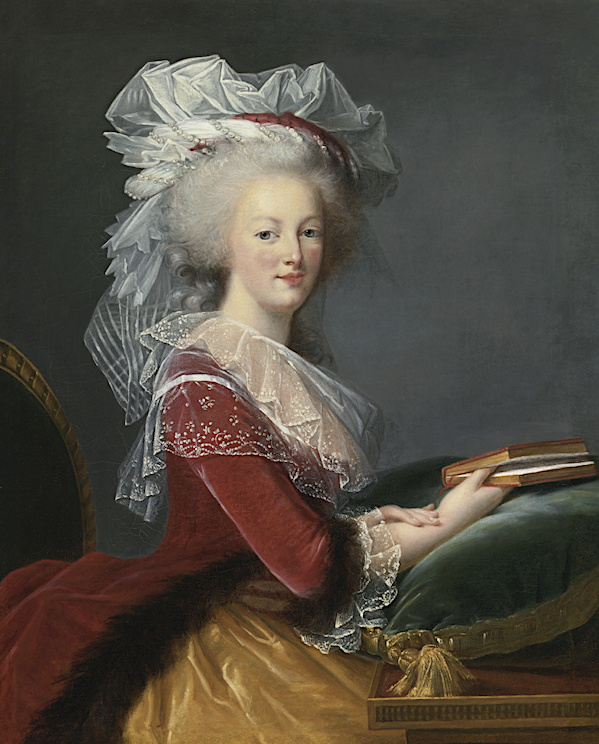La manufacture Wedgwood et sa production du XVIIIe siècle
4 participants
LE FORUM DE MARIE-ANTOINETTE :: La France et le Monde au XVIIIe siècle :: Les Arts et l'artisanat au XVIIIe siècle :: Les arts décoratifs
Page 1 sur 1
 La manufacture Wedgwood et sa production du XVIIIe siècle
La manufacture Wedgwood et sa production du XVIIIe siècle
A l'occasion du 260ème anniversaire de la création de la célèbre manufacture, la maison Sotheby's présentera prochainement à la vente de nombreuses pièces de la "collection Starr".
Sotheby's New-York - 23 octobre 2019
Wedgwood and Beyond: English Ceramics from the Starr Collection

Sotheby’s is proud to present the Starr Collection of English Ceramics, unarguably one of the best in its category, formed over fifty years with great passion and attention to detail.
The collection reflects the diverse production of the Wedgwood manufactory, this year celebrating its 260th anniversary, and encompasses 18th century Wedgwood jasperwares, agatewares, black basalts and encaustic vases (...)
* Source et infos complémentaires : Sotheby's - Starr Collection
 Je profite de cette vente, et de la mise en ligne de son catalogue, pour présenter ici une (brève) histoire de cette manufacture, ansi que la diversité de sa production.
Je profite de cette vente, et de la mise en ligne de son catalogue, pour présenter ici une (brève) histoire de cette manufacture, ansi que la diversité de sa production.
Si le fameux "Blue Jasperware" est le plus connu, voir par exemple notre sujet...
 Le mobilier décoré de plaques et médaillons Wedgwood - L'influence et le goût du marchand mercier Dominique Daguerre
Le mobilier décoré de plaques et médaillons Wedgwood - L'influence et le goût du marchand mercier Dominique Daguerre
...bien d'autres décors et techniques de réalisation sont à découvrir ici !
En complément des illustrations à suivre, je cite des extraits de l'article Wikipedia consacré à :
WEDGWOOD (entreprise)
Wedgwood, de son nom complet Josiah Wedgwood and Sons, est une manufacture de poterie, de porcelaine et de faïence britannique fondée en mai 1759, au tout début de la Révolution industrielle du Royaume-Uni, par Josiah Wedgwood (1730 – 1795) et son fils Thomas Wedgwood.
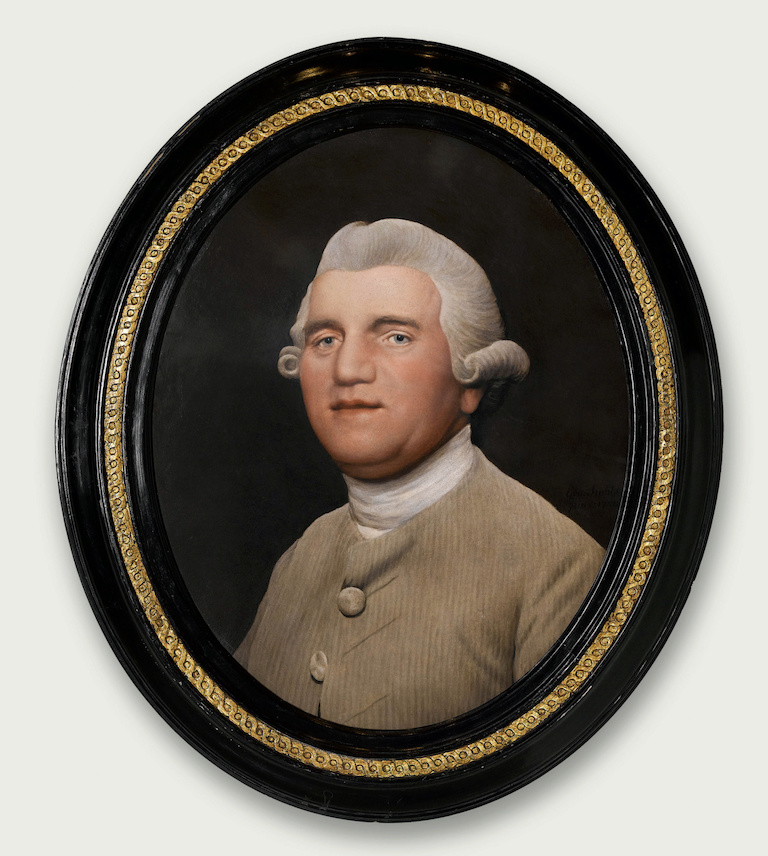
Josiah Wedgwood (1730-195)
by George Stubbs
Enamel on a Wedgwood ceramic tablet, 1780
Image : Wedgwood.com
Josiah Wedgwood, ne l'oublions pas, grand-père de Charles Darwin (voir notre Jeu de l'hiver)
Historique
Josiah Wedgwood s'établit dans les propriétés d'Ivy et de Bell House, et s'associa dès 1754 à Thomas Whieldon, qui a également joué un rôle prépondérant dans l'histoire de la céramique anglaise, dans sa fabrique de Little Fenton, très prospère entre 1740 et 1780, avec Aaron Wood, qui lui fournissait des moules.
Le vernis vert, inventé par Josiah Wedgwood vers 1754, permit à la manufacture de Little Fenton de simuler des fruits et des végétaux.
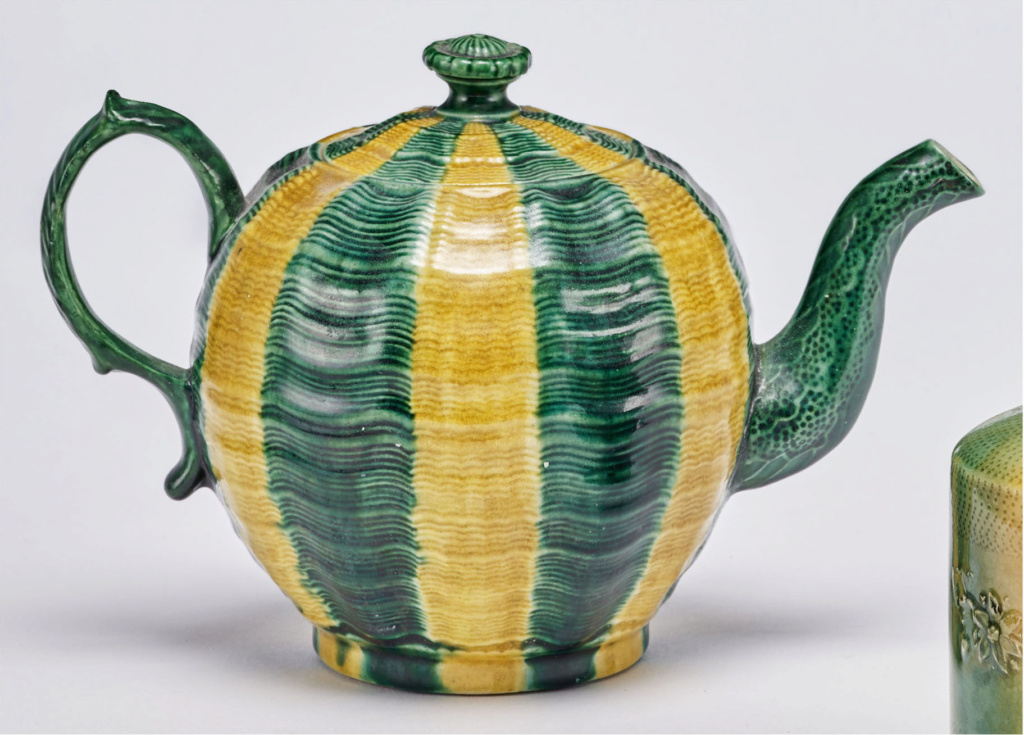
A WEDGWOOD LEAD-GLAZED CREAM-COLORED EARTHENWARE MELON TEAPOT AND COVER
CIRCA 1759-60
of globular form, affixed with a leaf-form handle and cauliflower spout, the ribbed and rouletted body picked out in vivid green and ochre-yellow stripes.
Height 4¾ in. 12.1 cm
Image : Sotheby's
En 1759, il ouvre à Burslem, sa ville natale du Staffordshire, sa propre manufacture, qui reçoit en 1765 la première commande de la famille royale.
En 1769, Wegdwood fonde aux environs de Stoke-on-Trent, avec le marchand et homme de lettres Thomas Bentley, la grande usine Etruria, donnant à la fabrication industrielle un développement et une qualité jusque-là inconnus.
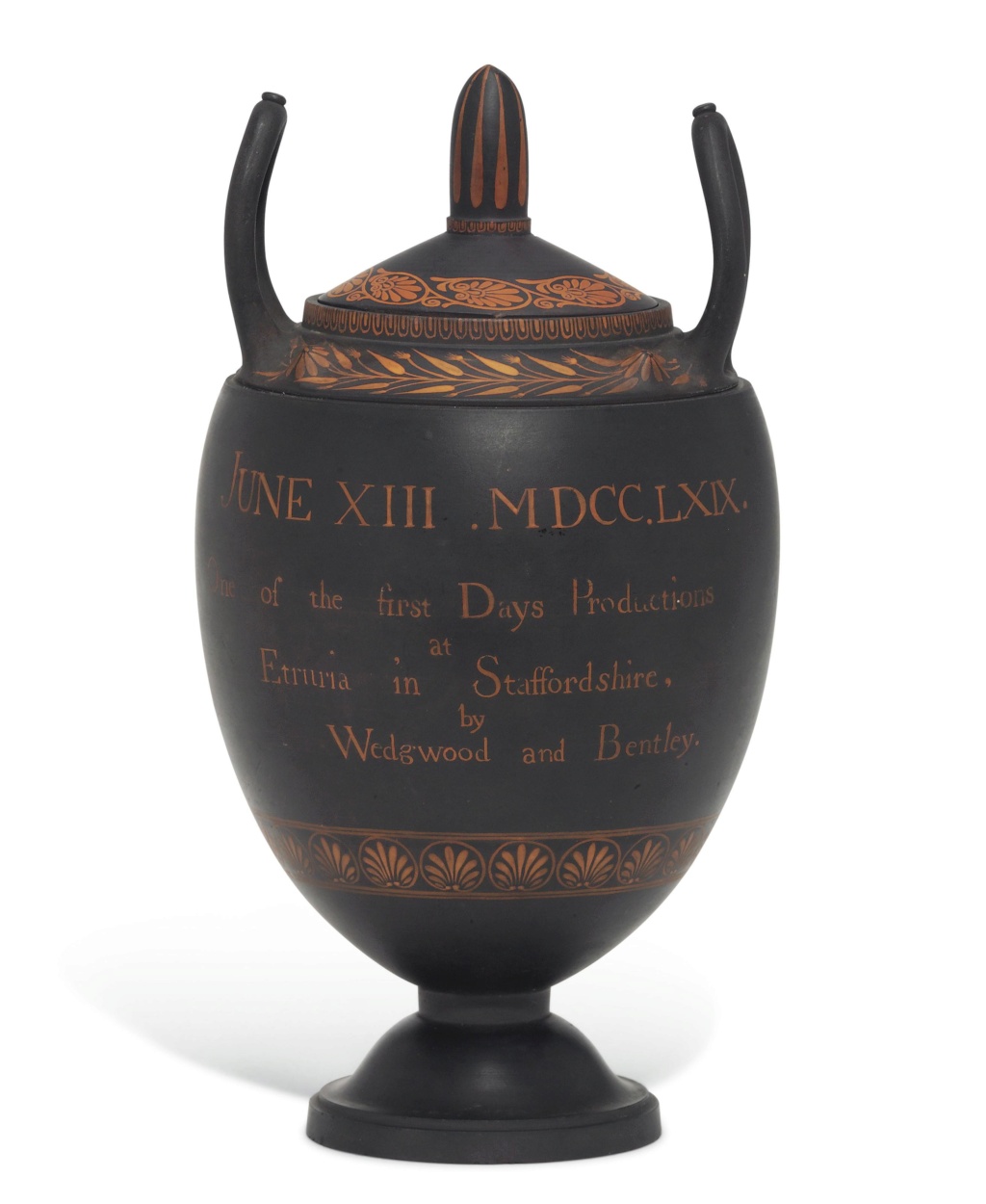
The First Day's Vase
Black basalt stoneware vase and cover, painted and inscribed in English and Latin.
Dated 13 June 1769 the vase was made by Josiah Wedgwood himself on the opening day of the Etruria factory.
Image : National Heritage Memorial Fund
Les ateliers de l'Etruria forment tout un village et continuent la fabrication régulière de la faïence fine pour les services de table.

Plan of Etruria Works before 1790
Image : Wedgwood Museum on Twitter
La manufacture et l'entreprise de Josiah Wedgwood sont distinctes de celles fondées par son cousin, Enoch Wedgwood, en 1860, dans la même ville de Stoke-on-Trent : Wedgwood & Co.
Toutefois, celles-ci finirent par être réunies au XXe siècle lorsque Wedgwood racheta Wedgwood & Co en 1980.
Wedgwood a fusionné en 1987 avec l'irlandais Waterford Crystal pour créer Waterford Wedgwood, entreprise elle-même acquise en juillet 2015 par le groupe finlandais Fiskars.
Caractères stylistiques
Toute la production du groupe est placée sous l'influence du goût antique, du fameux style classique « néo-grec ».
La faïence fine de couleur crème ou bleue, connue sous le nom de « céramique de la Reine » (nom donné au service exécuté par Wedgwood en 1762 pour la Reine Charlotte) pouvait recevoir un décor peint aussi bien qu'imprimé, avec les formes grêles et sèches propres à l'art décoratif anglais de la seconde partie du XVIIIe siècle.

Tureen with plate.
Wedgwood Queen's ware
Etruria manufactory, c. 1770
Musée Ariana, Geneva, Switzerland. Photo : Jacques Pugin
Image Researchgate

Pieces from the Green Frog Service, ordered by Catherine II of Russia, 1773
The Green Frog Service is considered one of the masterpieces of the Wedgwood Collection.
It was produced under commission for Catherine II in 1773, who requested a 952-piece dinner and dessert service – each to be hand-painted with a view of Britain.
The set was intended for her home at Kekerekeksinensky Palace – the name of which translates as 'frog marsh' in Finnish – explaining the green enamel amphibian crest that features in the design. Josiah employed artists to work up the sketches and also used a camera obscura to capture some scenes.
The set cost Catherine £2,290,12s.4d and was dispatched to St Petersburg by sea in 11 crates.
Source et image : Artfund.org
Le modeleur James Tassi et le sculpteur John Flaxman fournissaient les modèles Wedgwood et eux et son associé, Bentley, reprirent les procédés des vieux artisans du Staffordshire : fabrication des grès rouges sans vernis et poteries imitant les métaux précieux ou les pierres dures.
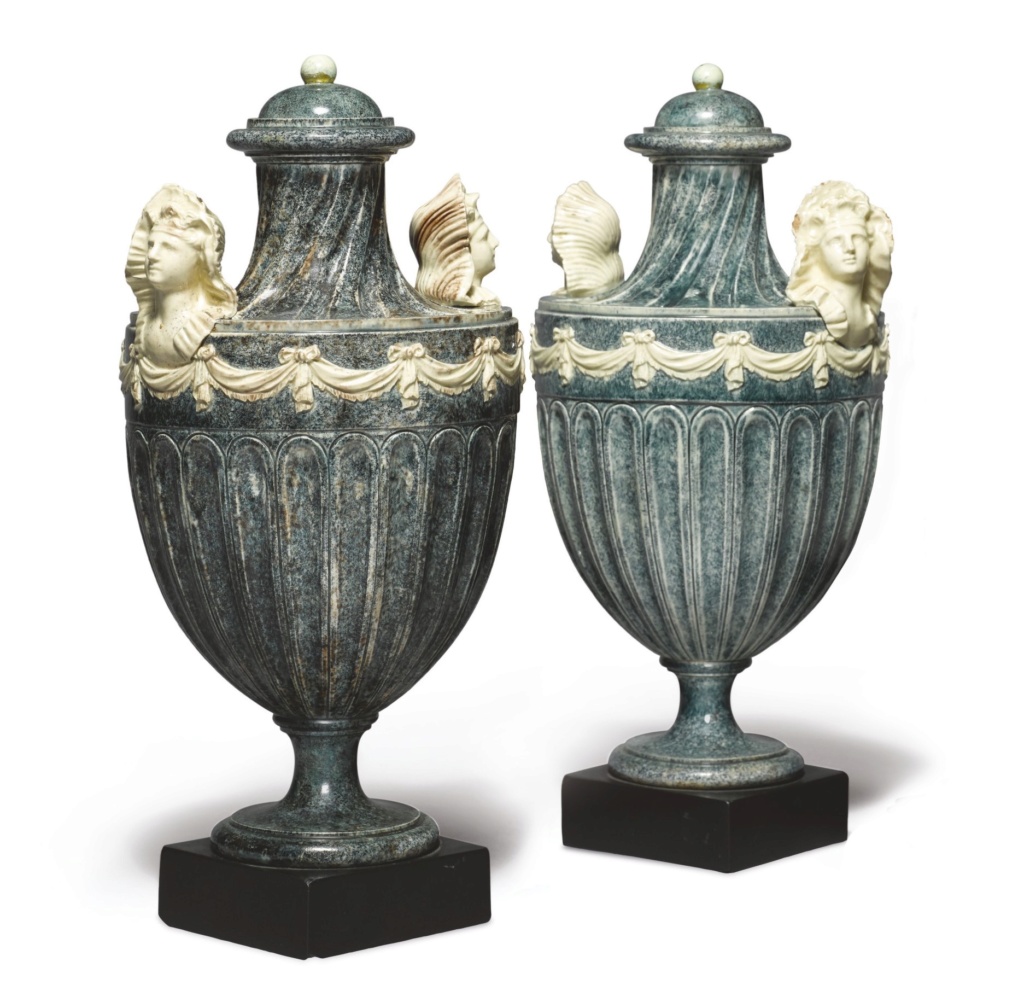
A PAIR OF WEDGWOOD AND BENTLEY CREAMWARE PORPHYRY TWO-HANDLED VASES AND COVERS
CIRCA 1768-80
vase shape no. 41, of urn shape and fluted form, the neck with spiral fluting, applied around the shoulder in white with suspended drapery tied in bows, affixed on either side with the female sphinx head forming a handle, the creamware body modeled in shades of green and black to simulate porphyry, raised on a black basalt square base, embossed WEDGWOOD & BENTLEY: ETRURIA. circular marks.
Heights 10⅞ in. 27.7 cm
Image : Sotheby's
Sur le « basalte », grès noir très dur, Wedgwood appliqua un décor peint à l'encaustique grâce auquel il parvint à contrefaire la céramique antique.

A WEDGWOOD BLACK BASALT LARGE TEA KETTLE AND COVER
CIRCA 1790
with a high strap handle molded with anthemion, the body sprigged in relief with scenes of putti at play, above a band of engine turning, the cover similarly-engine turned with a lion knop, the interior glazed, impressed lowercase Wedgwood.
Height 8 in. 20.4 cm
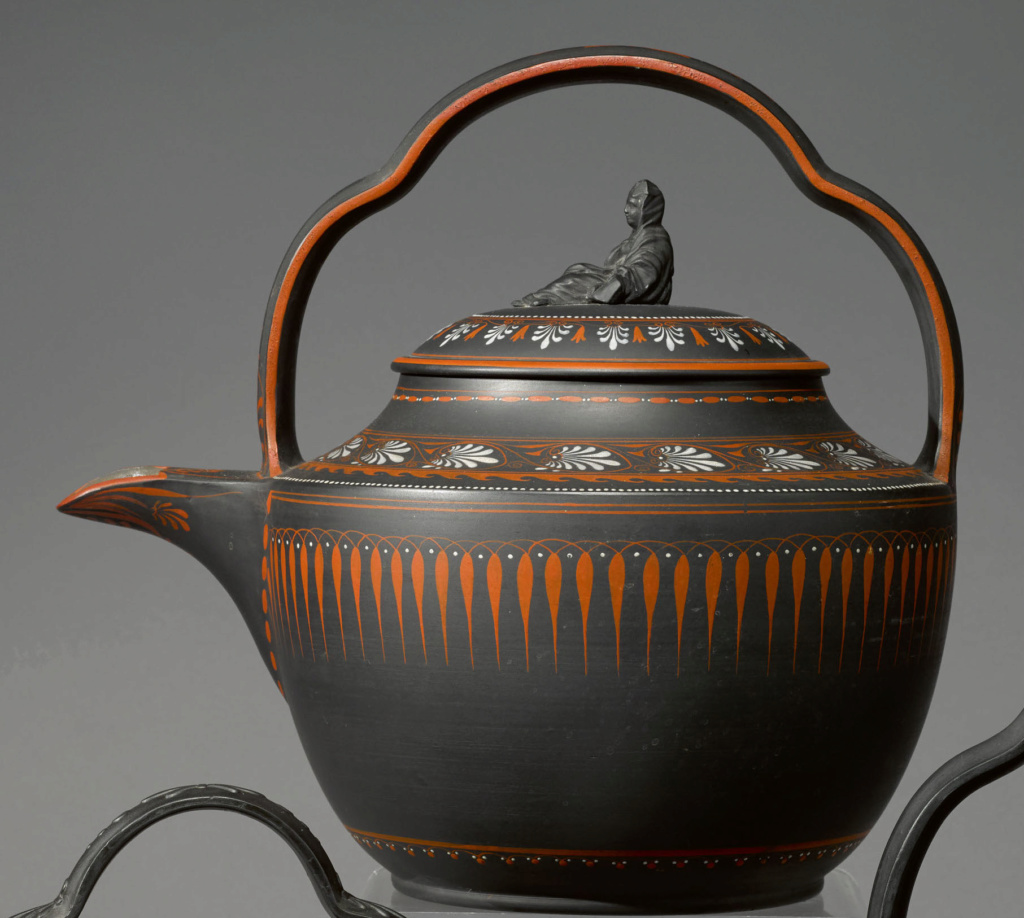
A WEDGWOOD BLACK BASALT 'ENCAUSTIC'-DECORATED RUM KETTLE AND COVER
CIRCA 1800
the cover with a 'sybil' knop, painted in terracotta-red and white with bands of anthemion and classical ornament, the interior glazed, impressed uppercase WEDGWOOD and letter M.
Height 10½ in. 26.6 cm
Le « jaspe » qui apparaît vers 1775 est une pâte très dure, blanche et fine, presque translucide, dont l'aspect se rapproche de celui de la porcelaine.
Le jaspe peut être coloré dans la masse ou, suivant le procédé plus économique introduit à partir de 1777, teinté en surface seulement.

Jaspar trials, with numbers keyed to Wedgwood's Experiment Book, 1773-1776
Wedgwood Museum - Barlaston, Stoke-on-Trent, England
Image : Wedgwood.com
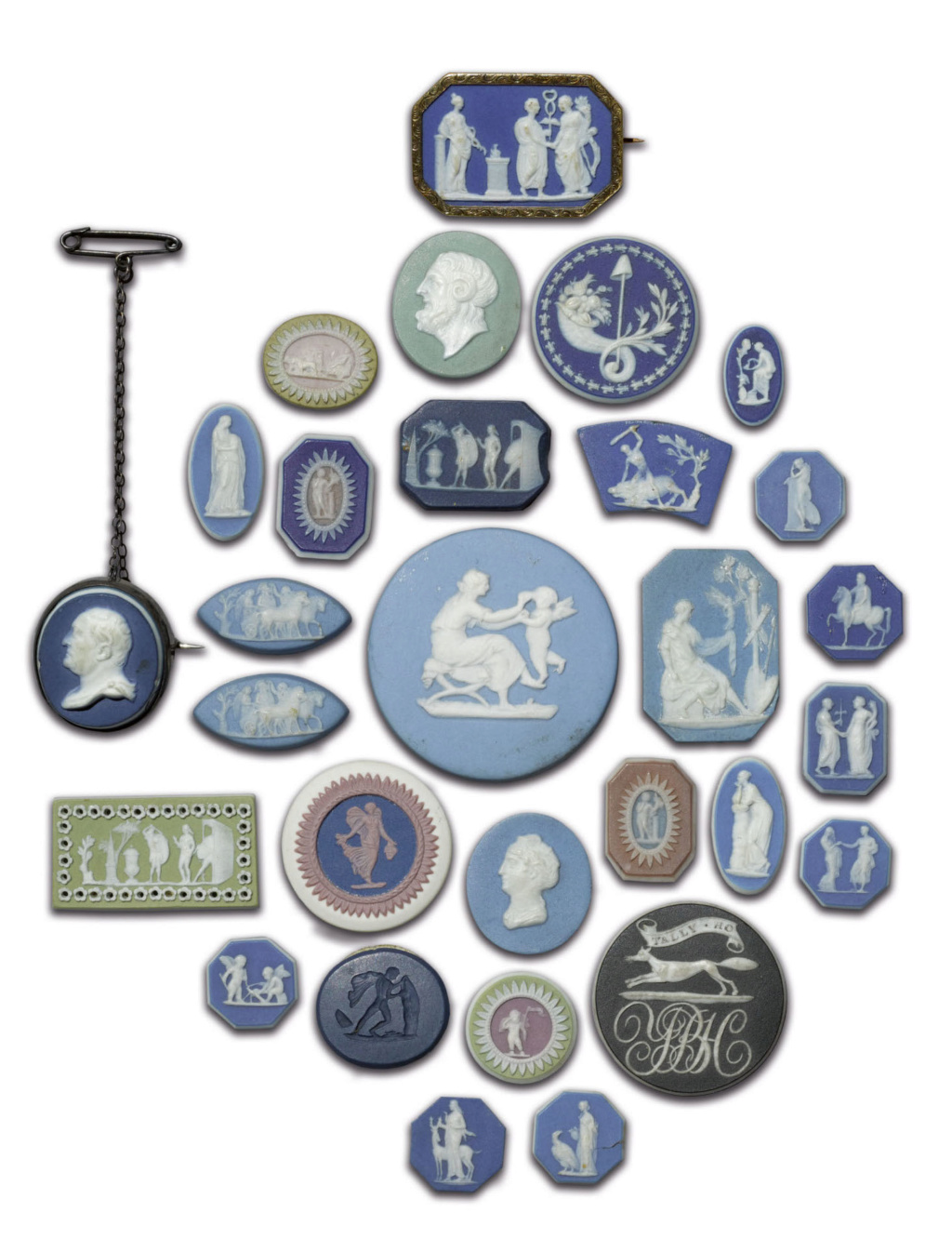
A GROUP OF TWENTY-NINE WEDGWOOD JASPERWARE CAMEOS AND INTAGLIOS MOSTLY LATE 18TH CENTURY
in varying shapes and sizes, decorated with classical scenes of figures and heads in profile, most marked with uppercase WEDGWOOD mark, one Wedgwood and Bentley, three with metal brooch mounts.
Diameter of largest 1½ in. 3.9 cm
Image : Sotheby's
L'entreprise fut très imitée dans le Staffordshire, où tous les potiers à sa suite adoptèrent le style classique, même dans le reste de l'Angleterre, en particulier dans la région de Leeds.
Elle fut rachetée en 1987, plus de deux siècles plus tard, par Waterford Crystal, devenant Waterford Wedgwood, un groupe de luxe basé en Irlande.
Le terme Wedgwood est devenu un terme générique pour désigner les produits de la société.
* Source texte (extraits) : https://fr.wikipedia.org/wiki/Wedgwood_(entreprise)
Sotheby's New-York - 23 octobre 2019
Wedgwood and Beyond: English Ceramics from the Starr Collection

Sotheby’s is proud to present the Starr Collection of English Ceramics, unarguably one of the best in its category, formed over fifty years with great passion and attention to detail.
The collection reflects the diverse production of the Wedgwood manufactory, this year celebrating its 260th anniversary, and encompasses 18th century Wedgwood jasperwares, agatewares, black basalts and encaustic vases (...)
* Source et infos complémentaires : Sotheby's - Starr Collection
________________
Si le fameux "Blue Jasperware" est le plus connu, voir par exemple notre sujet...
...bien d'autres décors et techniques de réalisation sont à découvrir ici !
En complément des illustrations à suivre, je cite des extraits de l'article Wikipedia consacré à :
WEDGWOOD (entreprise)
Wedgwood, de son nom complet Josiah Wedgwood and Sons, est une manufacture de poterie, de porcelaine et de faïence britannique fondée en mai 1759, au tout début de la Révolution industrielle du Royaume-Uni, par Josiah Wedgwood (1730 – 1795) et son fils Thomas Wedgwood.

Josiah Wedgwood (1730-195)
by George Stubbs
Enamel on a Wedgwood ceramic tablet, 1780
Image : Wedgwood.com
Josiah Wedgwood, ne l'oublions pas, grand-père de Charles Darwin (voir notre Jeu de l'hiver)
Historique
Josiah Wedgwood s'établit dans les propriétés d'Ivy et de Bell House, et s'associa dès 1754 à Thomas Whieldon, qui a également joué un rôle prépondérant dans l'histoire de la céramique anglaise, dans sa fabrique de Little Fenton, très prospère entre 1740 et 1780, avec Aaron Wood, qui lui fournissait des moules.
Le vernis vert, inventé par Josiah Wedgwood vers 1754, permit à la manufacture de Little Fenton de simuler des fruits et des végétaux.

A WEDGWOOD LEAD-GLAZED CREAM-COLORED EARTHENWARE MELON TEAPOT AND COVER
CIRCA 1759-60
of globular form, affixed with a leaf-form handle and cauliflower spout, the ribbed and rouletted body picked out in vivid green and ochre-yellow stripes.
Height 4¾ in. 12.1 cm
Image : Sotheby's
En 1759, il ouvre à Burslem, sa ville natale du Staffordshire, sa propre manufacture, qui reçoit en 1765 la première commande de la famille royale.
En 1769, Wegdwood fonde aux environs de Stoke-on-Trent, avec le marchand et homme de lettres Thomas Bentley, la grande usine Etruria, donnant à la fabrication industrielle un développement et une qualité jusque-là inconnus.

The First Day's Vase
Black basalt stoneware vase and cover, painted and inscribed in English and Latin.
Dated 13 June 1769 the vase was made by Josiah Wedgwood himself on the opening day of the Etruria factory.
Image : National Heritage Memorial Fund
Les ateliers de l'Etruria forment tout un village et continuent la fabrication régulière de la faïence fine pour les services de table.

Plan of Etruria Works before 1790
Image : Wedgwood Museum on Twitter
La manufacture et l'entreprise de Josiah Wedgwood sont distinctes de celles fondées par son cousin, Enoch Wedgwood, en 1860, dans la même ville de Stoke-on-Trent : Wedgwood & Co.
Toutefois, celles-ci finirent par être réunies au XXe siècle lorsque Wedgwood racheta Wedgwood & Co en 1980.
Wedgwood a fusionné en 1987 avec l'irlandais Waterford Crystal pour créer Waterford Wedgwood, entreprise elle-même acquise en juillet 2015 par le groupe finlandais Fiskars.
Caractères stylistiques
Toute la production du groupe est placée sous l'influence du goût antique, du fameux style classique « néo-grec ».
La faïence fine de couleur crème ou bleue, connue sous le nom de « céramique de la Reine » (nom donné au service exécuté par Wedgwood en 1762 pour la Reine Charlotte) pouvait recevoir un décor peint aussi bien qu'imprimé, avec les formes grêles et sèches propres à l'art décoratif anglais de la seconde partie du XVIIIe siècle.

Tureen with plate.
Wedgwood Queen's ware
Etruria manufactory, c. 1770
Musée Ariana, Geneva, Switzerland. Photo : Jacques Pugin
Image Researchgate

Pieces from the Green Frog Service, ordered by Catherine II of Russia, 1773
The Green Frog Service is considered one of the masterpieces of the Wedgwood Collection.
It was produced under commission for Catherine II in 1773, who requested a 952-piece dinner and dessert service – each to be hand-painted with a view of Britain.
The set was intended for her home at Kekerekeksinensky Palace – the name of which translates as 'frog marsh' in Finnish – explaining the green enamel amphibian crest that features in the design. Josiah employed artists to work up the sketches and also used a camera obscura to capture some scenes.
The set cost Catherine £2,290,12s.4d and was dispatched to St Petersburg by sea in 11 crates.
Source et image : Artfund.org
Le modeleur James Tassi et le sculpteur John Flaxman fournissaient les modèles Wedgwood et eux et son associé, Bentley, reprirent les procédés des vieux artisans du Staffordshire : fabrication des grès rouges sans vernis et poteries imitant les métaux précieux ou les pierres dures.

A PAIR OF WEDGWOOD AND BENTLEY CREAMWARE PORPHYRY TWO-HANDLED VASES AND COVERS
CIRCA 1768-80
vase shape no. 41, of urn shape and fluted form, the neck with spiral fluting, applied around the shoulder in white with suspended drapery tied in bows, affixed on either side with the female sphinx head forming a handle, the creamware body modeled in shades of green and black to simulate porphyry, raised on a black basalt square base, embossed WEDGWOOD & BENTLEY: ETRURIA. circular marks.
Heights 10⅞ in. 27.7 cm
Image : Sotheby's
Sur le « basalte », grès noir très dur, Wedgwood appliqua un décor peint à l'encaustique grâce auquel il parvint à contrefaire la céramique antique.

A WEDGWOOD BLACK BASALT LARGE TEA KETTLE AND COVER
CIRCA 1790
with a high strap handle molded with anthemion, the body sprigged in relief with scenes of putti at play, above a band of engine turning, the cover similarly-engine turned with a lion knop, the interior glazed, impressed lowercase Wedgwood.
Height 8 in. 20.4 cm

A WEDGWOOD BLACK BASALT 'ENCAUSTIC'-DECORATED RUM KETTLE AND COVER
CIRCA 1800
the cover with a 'sybil' knop, painted in terracotta-red and white with bands of anthemion and classical ornament, the interior glazed, impressed uppercase WEDGWOOD and letter M.
Height 10½ in. 26.6 cm
Le « jaspe » qui apparaît vers 1775 est une pâte très dure, blanche et fine, presque translucide, dont l'aspect se rapproche de celui de la porcelaine.
Le jaspe peut être coloré dans la masse ou, suivant le procédé plus économique introduit à partir de 1777, teinté en surface seulement.

Jaspar trials, with numbers keyed to Wedgwood's Experiment Book, 1773-1776
Wedgwood Museum - Barlaston, Stoke-on-Trent, England
Image : Wedgwood.com

A GROUP OF TWENTY-NINE WEDGWOOD JASPERWARE CAMEOS AND INTAGLIOS MOSTLY LATE 18TH CENTURY
in varying shapes and sizes, decorated with classical scenes of figures and heads in profile, most marked with uppercase WEDGWOOD mark, one Wedgwood and Bentley, three with metal brooch mounts.
Diameter of largest 1½ in. 3.9 cm
Image : Sotheby's
L'entreprise fut très imitée dans le Staffordshire, où tous les potiers à sa suite adoptèrent le style classique, même dans le reste de l'Angleterre, en particulier dans la région de Leeds.
Elle fut rachetée en 1987, plus de deux siècles plus tard, par Waterford Crystal, devenant Waterford Wedgwood, un groupe de luxe basé en Irlande.
Le terme Wedgwood est devenu un terme générique pour désigner les produits de la société.
* Source texte (extraits) : https://fr.wikipedia.org/wiki/Wedgwood_(entreprise)
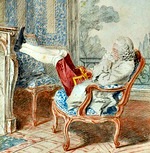
La nuit, la neige- Messages : 17807
Date d'inscription : 21/12/2013
 Re: La manufacture Wedgwood et sa production du XVIIIe siècle
Re: La manufacture Wedgwood et sa production du XVIIIe siècle
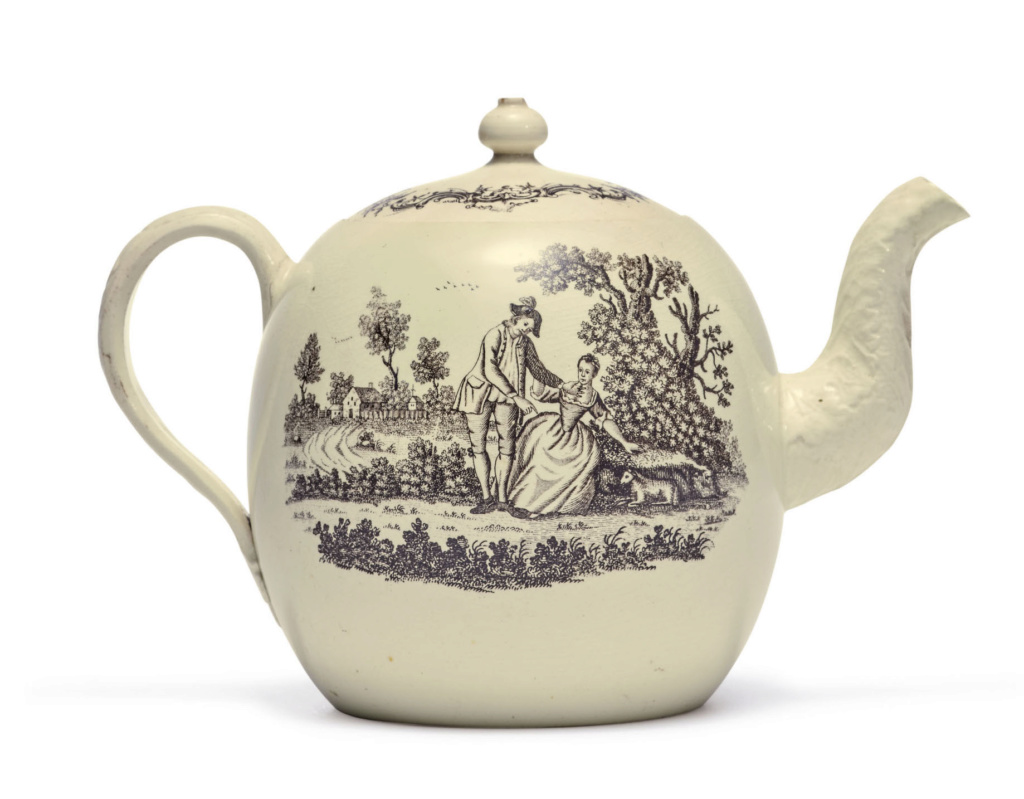
A WEDGWOOD CREAMWARE TRANSFER-PRINTED TEAPOT AND COVER
CIRCA 1765
of globular form, affixed with a foliate handle and cauliflower molded spout, printed on either side with a couple under a tree with a lamb to their side, and two figures dancing to a third playing a violin, the cover printed with a foliate scroll cartouche, impressed Wedgwood mark in lower case letters.
Height 5½ in. 14 cm

A WEDGWOOD CREAMWARE TEAPOT AND COVER
CIRCA 1775
of globular shape with a leaf-molded spout and double twisted handle, perhaps painted in the workshop of David Rhodes, with a vignette showing Aurora, Goddess of the Dawn in her chariot drawn by two winged horses, the reverse with a colorful sunrise below two winged putti heads, separated by a 'chintz' band, impressed lower case Wedgwood mark.
Height 5⅜ in.13.8 cm

A WEDGWOOD CREAMWARE POT-POURRI VASE AND PIERCED COVER
CIRCA 1785
of baluster form, molded with acanthus leaf band around the neck, the shoulder with bow-knotted festoons, picked out in brown, impressed lowercase Wedgwood over numeral 2, impressed L, L mark in brown enamel to vase, I. in brown enamel to cover.
Height 13⅝ in. 34.5 cm

A PAIR OF WEDGWOOD AND BENTLEY CREAMWARE 'PORPHYRY' TWO-HANDLED VASES AND COVERS
CIRCA 1768-80
vase shape no. 1, of urn shape, affixed on either side at the shoulder with a cream-colored satyr's mask, the horns forming handles which pierce the rim of the vase and from which hang molded garlands of fruiting vine, the creamware bodies modeled in shades of green to simulate porphyry, the covers with a ball knop, upon black basalt stepped square bases, applied medallions embossed WEDGWOOD & BENTLEY: ETRURIA.
Heights 10 and 10⅛ in. 25.4, 25.6 cm

A PAIR OF WEDGWOOD AND BENTLEY CREAMWARE 'PORPHYRY' TWO-HANDLED VASES AND COVERS
CIRCA 1780
vase shape no. 29, each of inverted pear shape, affixed on either side at the shoulder with fruiting foliate scroll handles, joined by a modeled laurel wreath band, reserving creamware medallions showing The Three Graces and the Sacrifice to Aesculapius, the Greek god of medicine and healing, reserved on a creamware body mottled and marbled in shades of underglaze green, brown and black to simulate porphyry, raised on a black basalt square base, the base with applied medallions embossed WEDGWOOD & BENTLEY ETRURIA.
Height 12⅞ in. 32.8 cm

A WEDGWOOD AND BENTLEY CREAMWARE 'PORPHYRY' TWO-HANDLED VASE AND COVER
CIRCA 1770
the oviform creamware body mottled in shades of green and black to simulate porphyry, applied with heavy gilt medallions supporting hanging garlands and affixed with foliate handles with female mask terminals, raised on a black basalt square base, embossed WEDGWOOD & BENTLEY: ETRURIA. circular mark.
Height 10½ in. 26.5 cm

A PAIR OF WEDGWOOD AND BENTLEY 'PORPHYRY' 'FISH TAIL' EWER VASES
CIRCA 1775
vase shape no. 152, after the engraving by Jacques Stella (1596-1657), of urn shape, each affixed on either side with a gilt mask handle terminal or spout joined by a band of vertical fluting at the shoulder, the cover issuing a long curving scaly gilt fish-tail handle, the creamware body motttled in shades of green and black to simulate porphyry, raised on a black basalt square base, embossed WEDGWOOD & BENTLEY: ETRURIA. circular marks.
Heights 12¼ and 12½ in. 31 and 31.8 cm
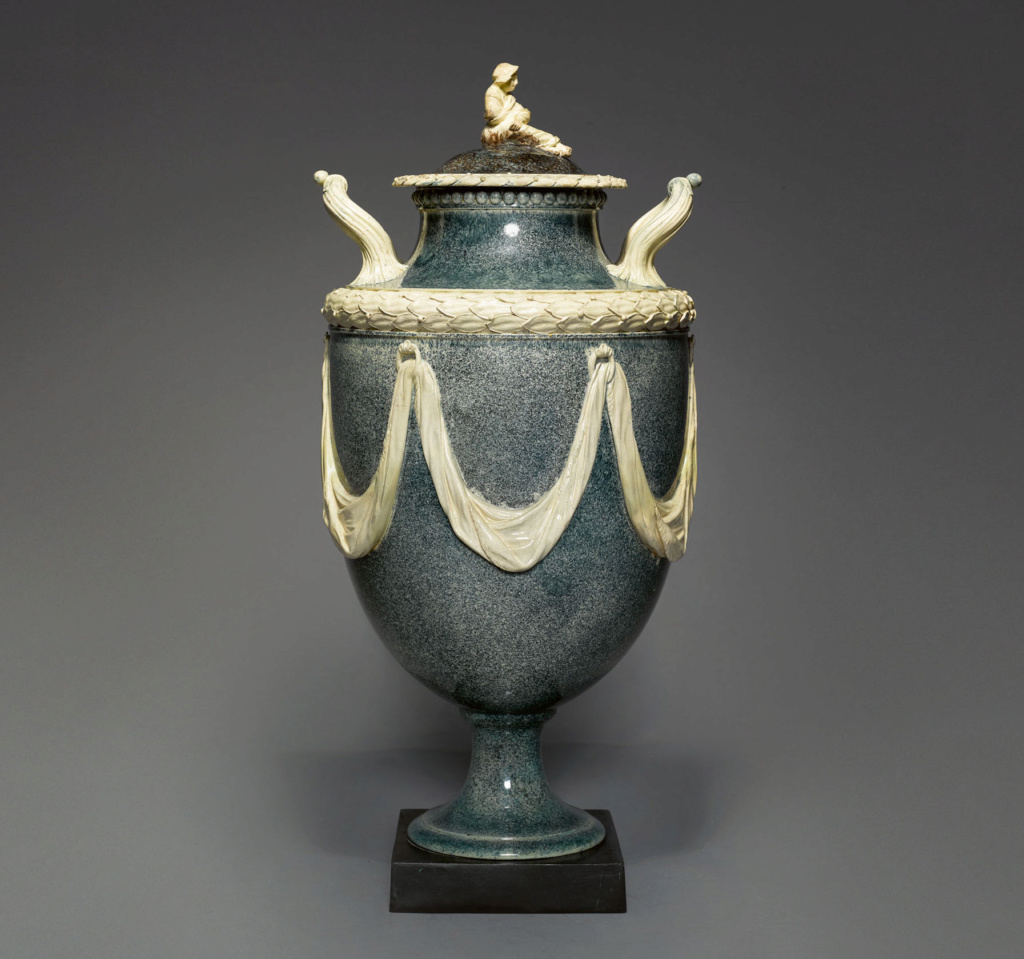
A WEDGWOOD AND BENTLEY CREAMWARE 'PORPHYRY' LARGE TWO-HANDLED VASE AND COVER
CIRCA 1775
of urn shape, applied around the exterior in white with drapery suspended from rings, the creamware body mottled in shades of green to simulate porphyry, raised on a black basalt square base, the cover with a widow knop, the shoulder and cover rim with molded laurel wreath bands, applied medallion embossed WEDGWOOD & BENTLEY: ETRURIA..
Height 18 in. 45.8 cm
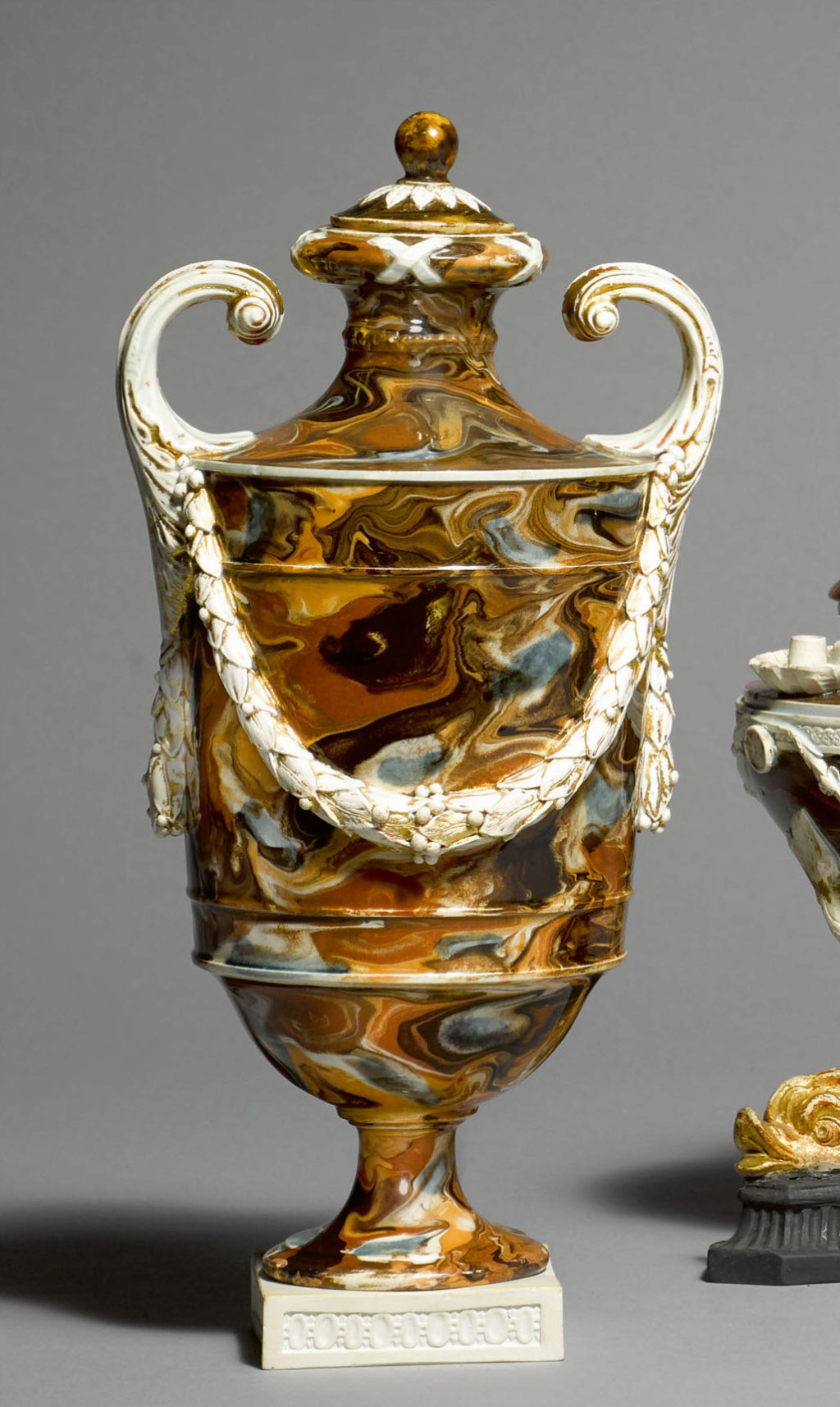
A WEDGWOOD AND BENTLEY SOLID AGATE VASE AND COVER
CIRCA 1775
of cylindrical form affixed on either side with a pistol handle suspending foliate swags enriched in gilding, the body in tones of brown, cream and blue, the cover with a ball knop, raised on a white stoneware base with molded guilloche panels, impressed Wedgwood & Bentley mark.
Height 9⅝ in. 24.5 cm
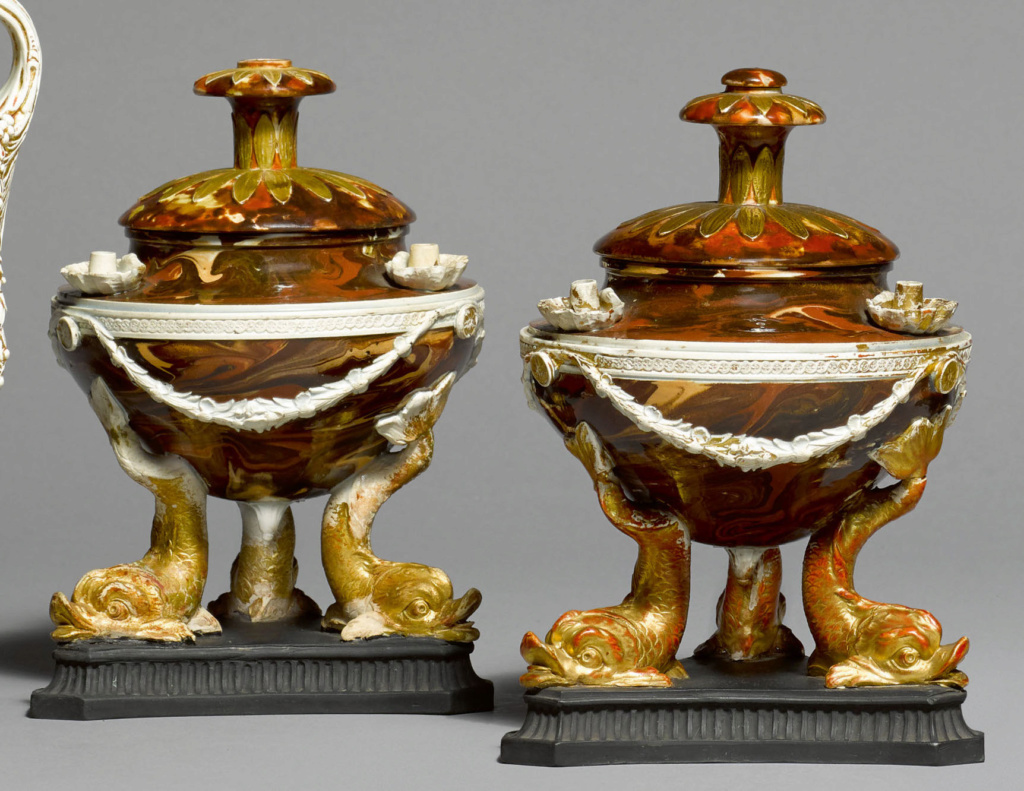
A PAIR OF WEDGWOOD CREAMWARE 'VARIEGATED AGATE' OIL LAMPS, COVERS AND ONE STOPPER
CIRCA 1770
of shallow form, the exterior affixed with creamware garlands with traces of gilding, the shoulder set with three small pierced shells, the covers enriched with gilded stiff leaves, one with a stopper, set on three gilt-heightened dolphin supports raised on a black basalt square base, impressed WEDGWOOD marks.
Heights 7½ and 7¼ in. 19 and 18.5 cm

A WEDGWOOD AND BENTLEY SOLID AGATE VASE AND COVER
CIRCA 1770-75
vase shape no. 231, of urn shape, affixed on either side with a 'monster' handle with traces of gilding, the cover with a 'Pelican in her Piety' knop, raised on a white stoneware bases with molded guilloche panels, impressed Wedgwood & Bentley mark.
Height 9¼ in. 23.5 cm

A WEDGWOOD AND BENTLEY CREAMWARE 'VARIEGATED AGATE' VASE
CIRCA 1775-78
of amphora form, the surface simulating agate in tones of brown and cream slip, modeled with a gilt banded border of stiff leaves around the neck and affixed on either side with a gilt strap and serpent entwined handle, the neck and lower body with a band of stiff leaves, raised on a black basalt foot, embossed WEDGWOOD & BENTLEY: ETRURIA. circular mark.
Height 14½ in. 37 cm
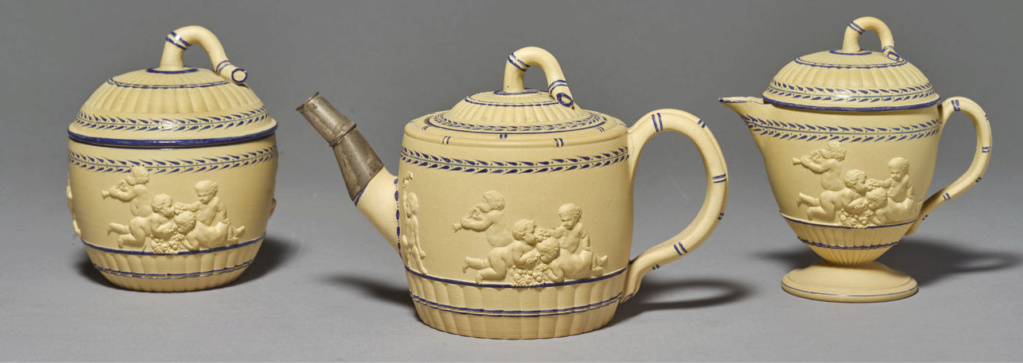
A WEDGWOOD CANEWARE PART-BAMBOO-MOLDED PART TEA SERVICE
CIRCA 1780-1800
sprigged in relief with figures of children at play, picked out with blue bands, comprising a teapot and cover, a milk jug and cover and a sugar bowl and cover, impressed Wedgwood over numeral 2. 6 pieces.
Height of teapot 4¼ in. 10.8 cm

A WEDGWOOD CANEWARE PART-BAMBOO-MOLDED TWO-HANDLED BOUGH POT AND PIERCED COVER
CIRCA 1780-85
painted with a gilt-edged blue-ground and foliate meander border, the ribbed border picked out in blue bands, the cover with a shaded blue band of anthemion, impressed lower case Wedgwood mark.
Height 8⅝ in. 22 cm

A WEDGWOOD CANEWARE BAMBOO-MOLDED TEAPOT AND COVER
CIRCA 1780
of pentangular form modeled in the form of tied lengths of bamboo, the cover with a finial formed of a coiled stem of bamboo, the interior glazed, impressed lower case Wedgwood mark.
Height 4⅞ in. 12.5 cm
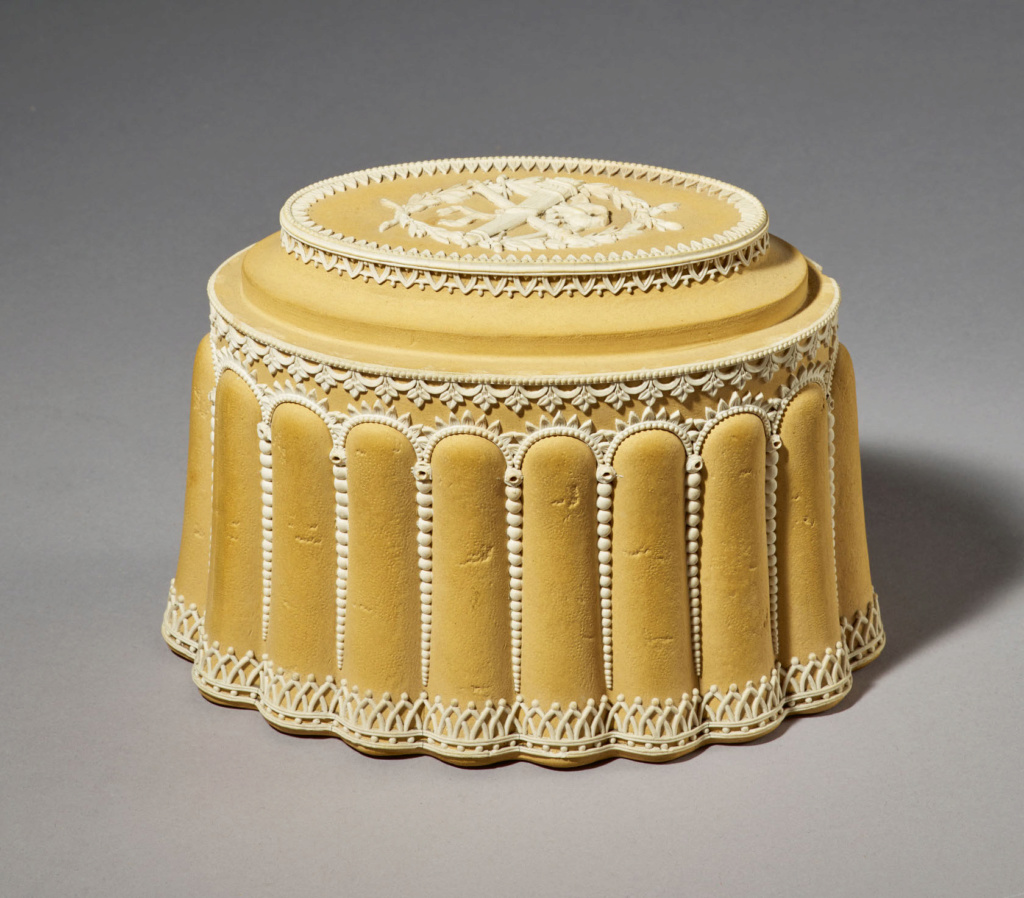
A WEDGWOOD CANEWARE 'CONCEIT' MODEL OF A CAKE
LATE 18TH CENTURY
shape no. 419, decorated with elaborate white 'icing', the top reserved with a pair of billing doves above a quiver and torch within a laurel leaf wreath, impressed uppercase WEDGWOOD over letter G.
Height 5⅜ in.; 13.8 cm Width 8 in.; 20.5 cm

A PAIR OF WEDGWOOD AND BENTLEY BLACK BASALT TWO-HANDLED VASES AND COVERS
CIRCA 1775
each of shield shape, affixed with upright loop handles at the shoulders suspending drapery from rings, the front applied with a medallion showing 'The Three Graces' or the 'Sacrifice to Aesculapius', Greek god of medicine and healing, the neck and foot with engine-turned banding, impressed Wedgwood & Bentley marks.
Heights 13⅝ in. 34.6 cm

A WEDGWOOD AND BENTLEY BLACK BASALT TWO-HANDLED VASE AND COVER CIRCA 1775
of amphora form with two high acanthus-leaf-molded handles terminating in ram's head mask terminals, a continuous foliate garland suspended from the horns, decorated in relief with oval medallions, applied medallions embossed WEDGWOOD & BENTLEY: ETRURIA..
Height 16⅛ in. 40.9 cm

TWO WEDGWOOD AND BENTLEY BLACK BASALT EWERS CIRCA 1775
shape number 60, each of ovoid form, the flaring shell molded rim issuing a tall looping handle terminating in a Dionysus mask above applied anthemion and laurel wreath bands, on square bases, impressed Wedgwood & Bentley marks.
Heights 13¾ and 13⅝ in. 35 and 34.7 cm

A WEDGWOOD AND BENTLEY VERY LARGE BLACK BASALT BUST OF JULIUS CAESAR
CIRCA 1779
modeled showing the emperor wearing fish-scale armor, raised on a separate socle base, the reverse edge at the shoulder impressed uppercase JULIUS CAESAR, the lower edge impressed lowercase Wedgwood & Bentley mark, the socle base impressed uppercase WEDGWOOD & BENTLEY.
Height 18⅝ in. 47.4 cm

A WEDGWOOD VERY LARGE BLACK BASALT BUST OF WILLIAM SHAKESPEARE
LATE 18TH CENTURY
modeled wearing doublet and shirt collar, raised on a separate socle base, the reverse of the shoulder embossed in uppercase SHAKESPEARE, and lowercase Wedgwood mark, the underside of the socle with uppercase WEDGWOOD & BENTLEY mark.
Height 19 in. 48.2 cm

A WEDGWOOD BLACK BASALT OVAL PLAQUE OF THE GREEK PHILOSOPHER ZENO CIRCA 1775
molded in high relief standing before a column on a small mound, within a gilded molded ribbed integral frame.
Height 14¾ in.
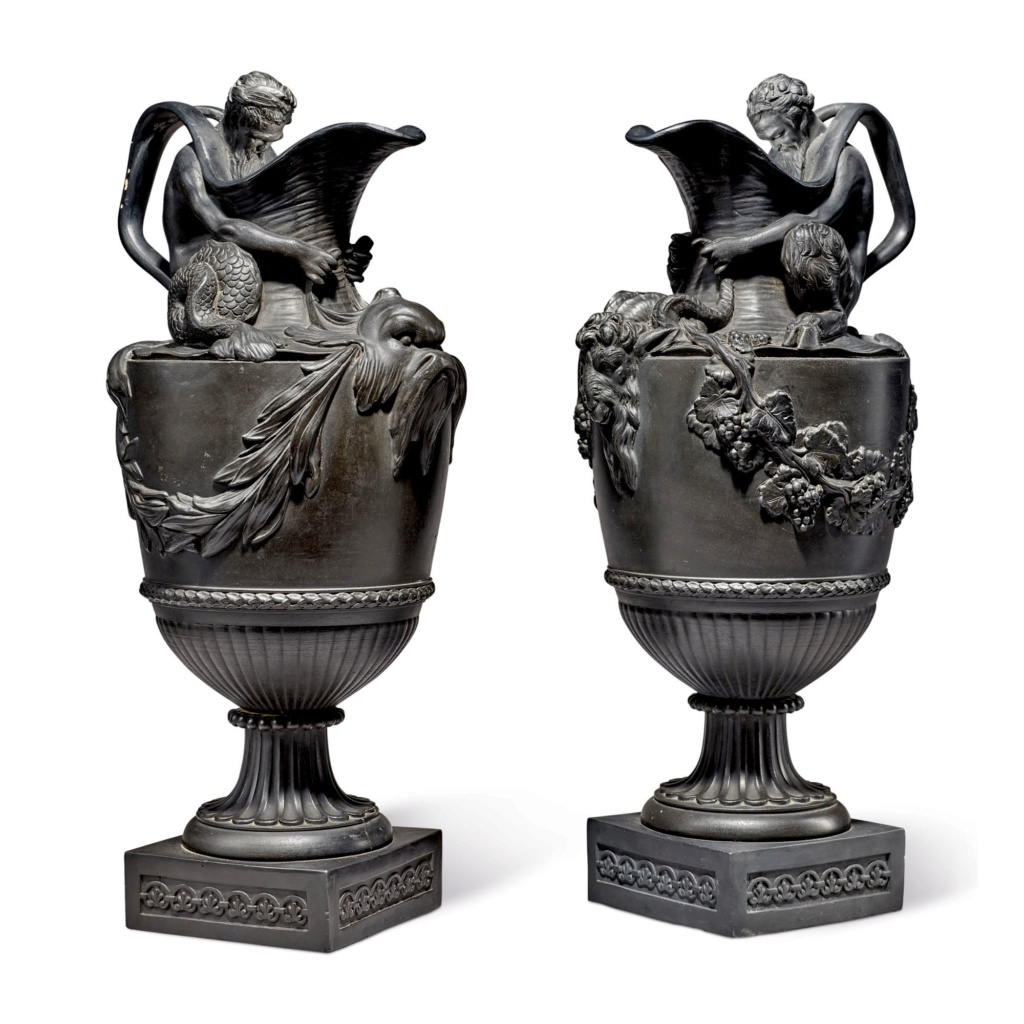
A PAIR OF WEDGWOOD AND BENTLEY BLACK BASALT 'WATER' AND 'WINE' EWERS CIRCA 1775
each modeled with either a satyr or triton representative of Bacchus or Neptune, seated upon the shoulder of the shield-shaped body with arms extending around the neck and grasping either the horns of a goat or the fins of a dolphin, above swags of either fruiting grapevine or waterweed, raised on a fluted stem and square base, the water ewer with applied medallion embossed WEDGWOOD & BENTLEY: ETRURIA.
Heights 15½ and 15⅜ in. 39. 3 and 39.1 cm
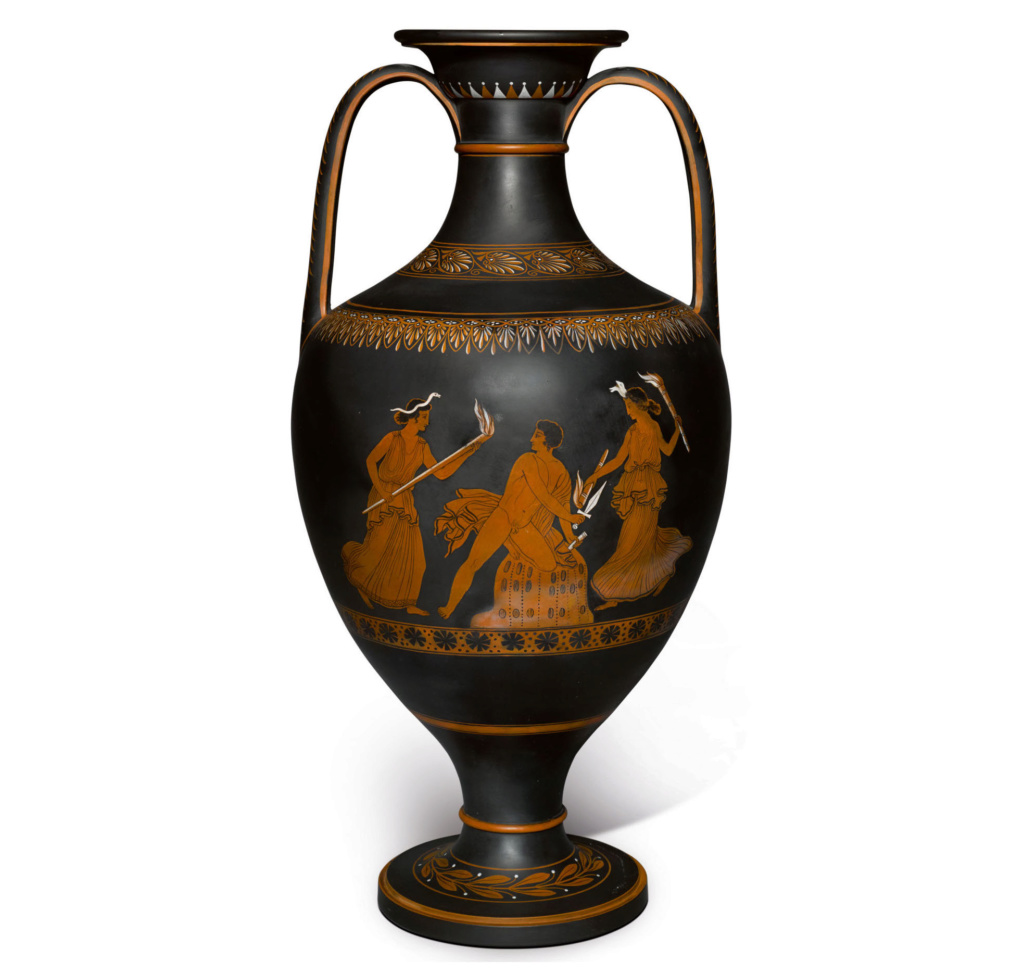
A WEDGWOOD BLACK BASALT 'ENCAUSTIC'-DECORATED AMPHORA VASE
LATE 18TH CENTURY
the flaring trumpet neck affixed with two loop handles, painted in terracotta-red and white with classical figures, the seated man holding a dagger flanked by maidens holding torches, within anthemion and stylized rosette bands, impressed uppercase WEDGWOOD mark.
Height 22 in. 56 cm

A WEDGWOOD BLACK BASALT 'ENCAUSTIC'-DECORATED KRATER VASE
CIRCA 1785
after the so-called 'Hamilton Vase' model, the shoulder affixed with two handles bearing Gorgon masks on either side terminating in two loops with swans heads, painted in terracotta-red, orange, blue and white, the front with a female figure holding a skeiadion, and a male figure holding a staff, the reverse with a large anthemion in shaded red and blue, within Greek Key and egg and dart bands, the flared rim with bands of egg and dart, waves and rosettes, impressed uppercase WEDGWOOD.
Height 13¾ in. 35 cm
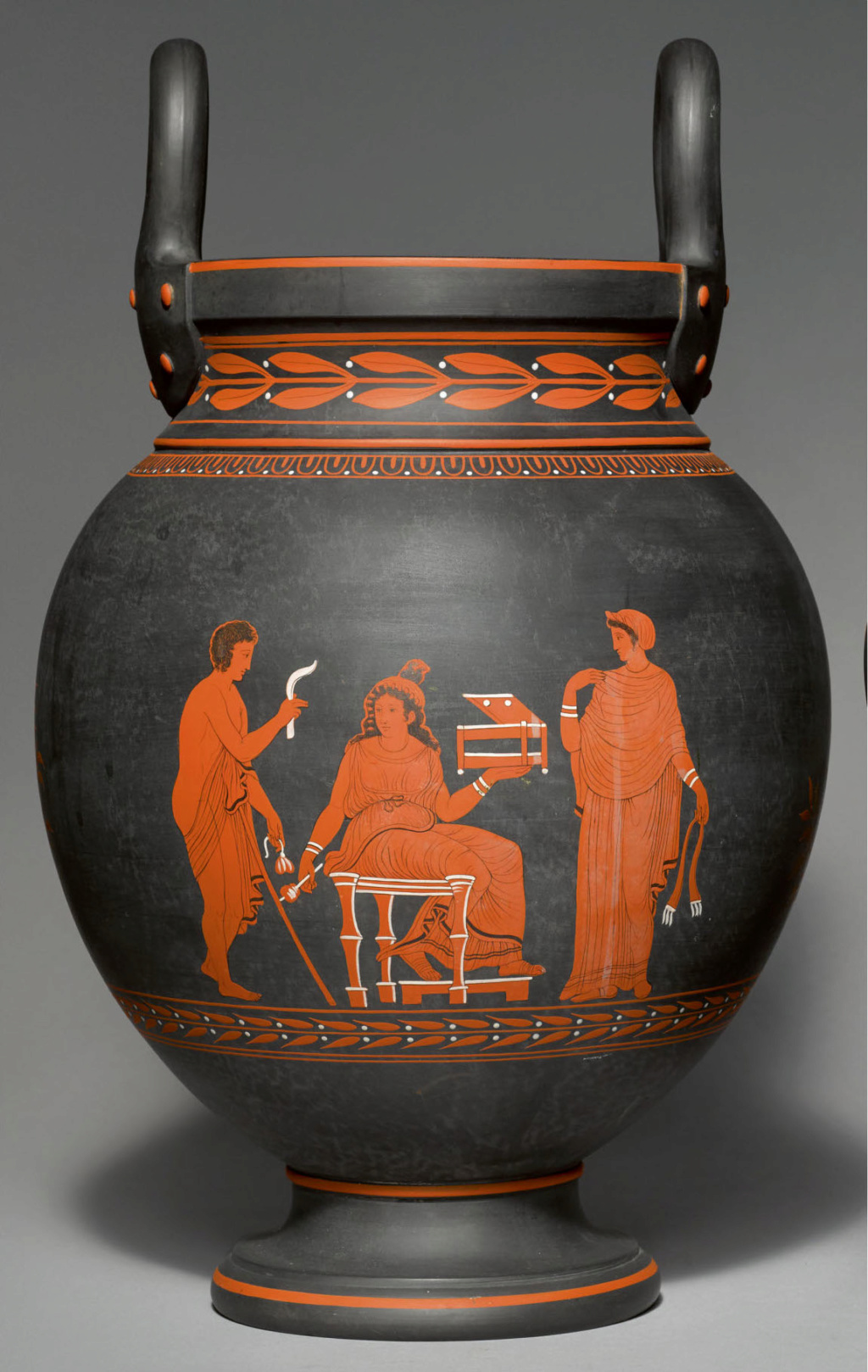
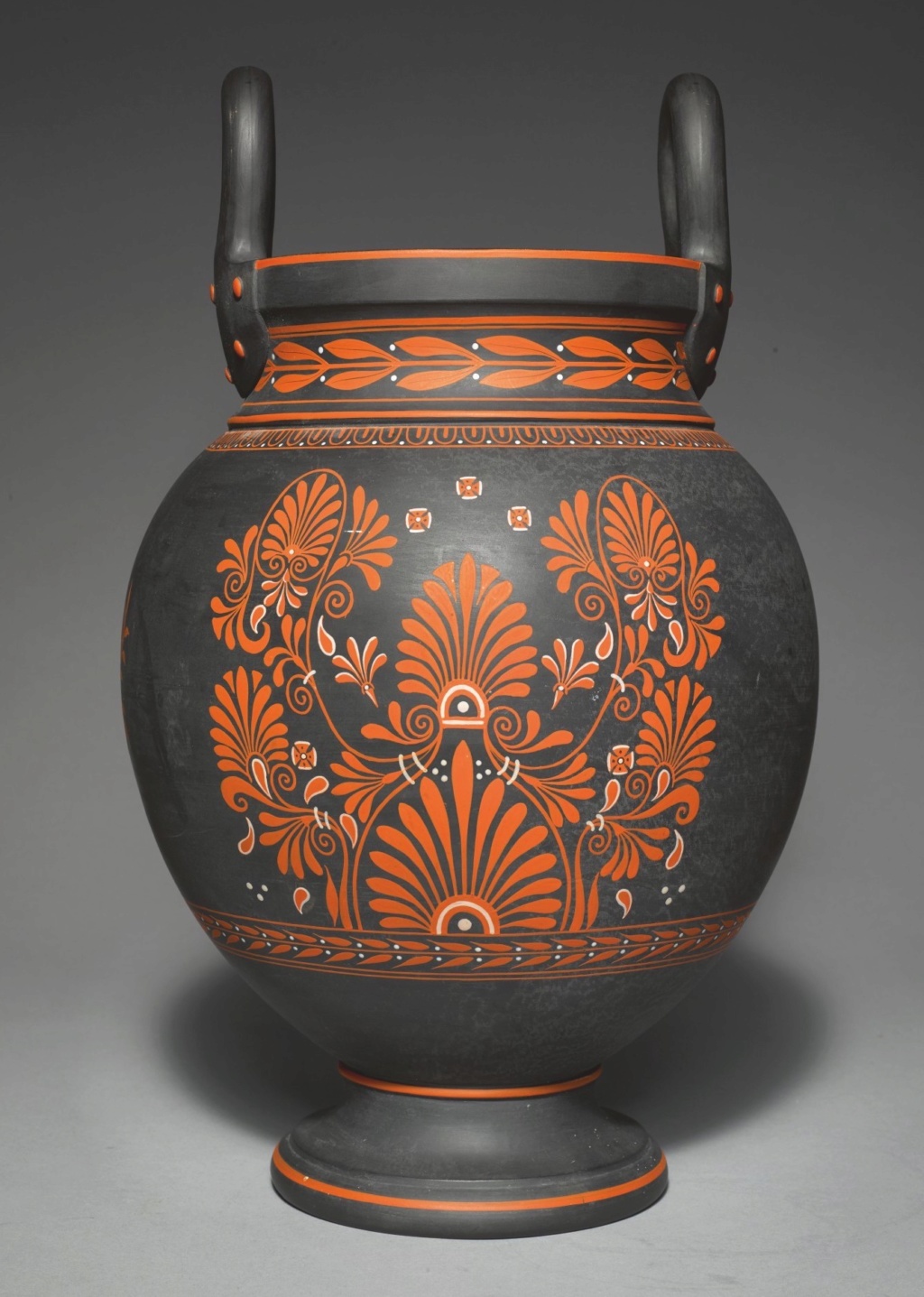
A WEDGWOOD BLACK BASALT 'ENCAUSTIC'-DECORATED TWO-HANDLED VASE, COVER AND PIERCED COVER
LATE 18TH CENTURY
of classical form with a waisted trumpet neck, the loop handles with molded 'studded' terminals to simulate metalwork and the bulbous body painted in terracotta-red and white on the front with three figures, on the reverse with a large anthemion and on each side with a leafy branch, with classical ornament bands, the interior glazed, impressed uppercase WEDGWOOD.
Height 16⅝ in. 42.23 cm
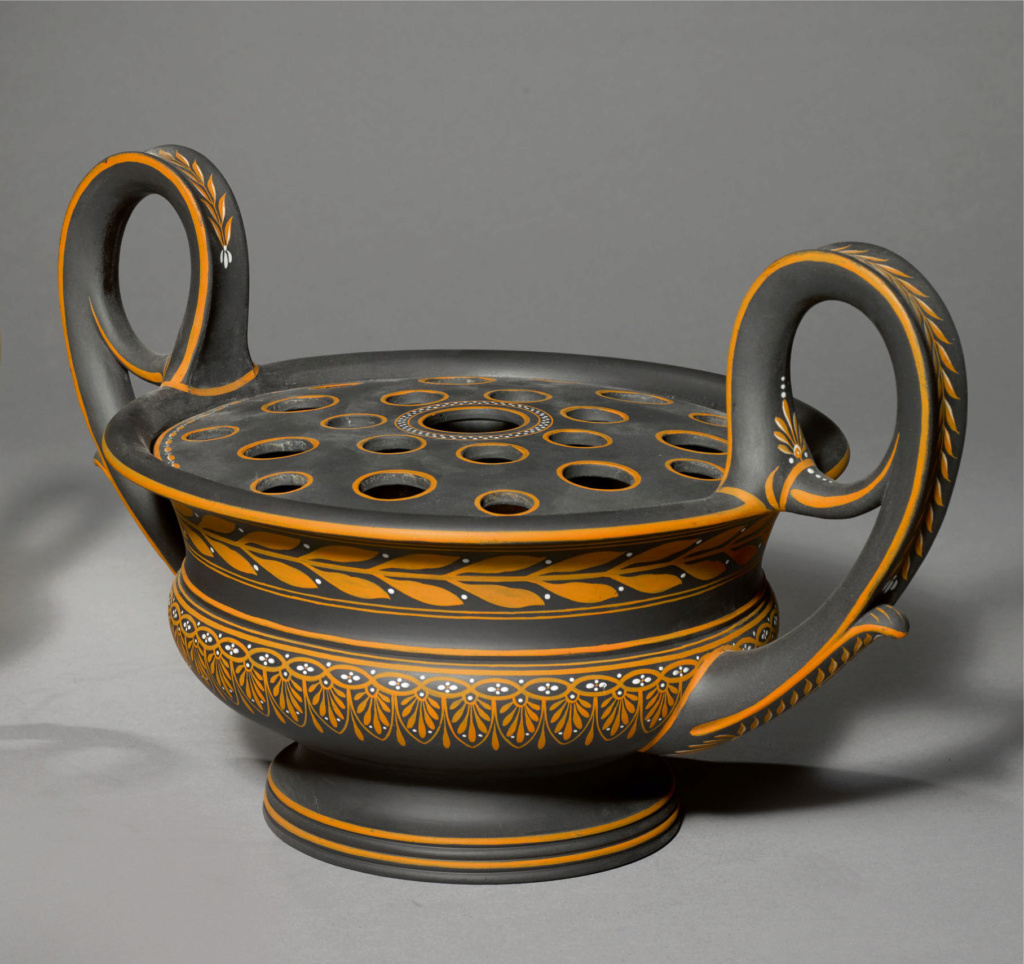
A WEDGWOOD BLACK BASALT ENCAUSTIC-DECORATED KRATER VASE AND PIERCED COVER
LATE 18TH CENTURY
painted around the exterior with stylized foliate borders and affixed on either side with a loop handle, the interior glazed, impressed uppercase WEDGWOOD.
Width across handles 11⅞ in. 30 cm
Et enfin le style reconnaissable entre tous, à couverte de "jaspe", décliné en nombre de couleurs...
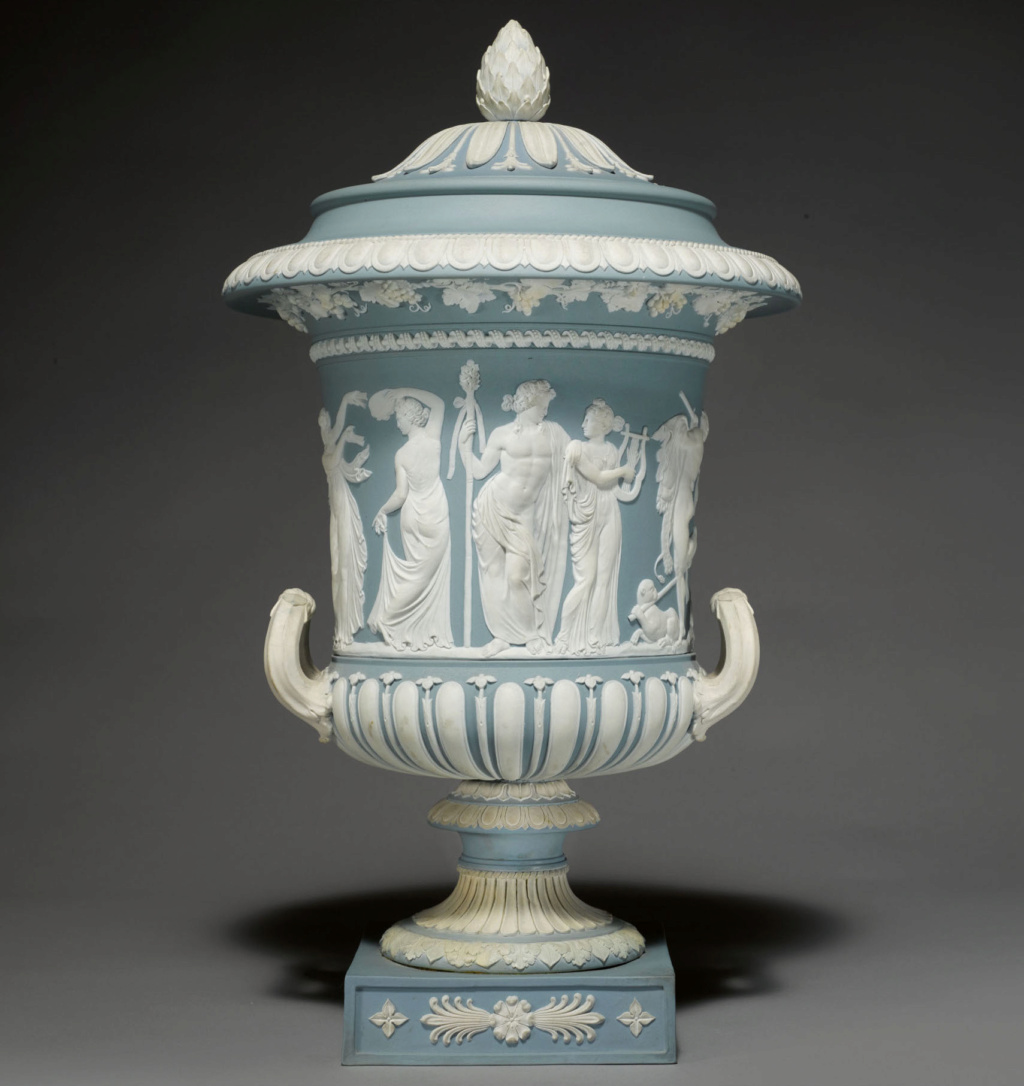
A WEDGWOOD BLUE AND WHITE JASPERWARE TWO-HANDLED 'BORGHESE' VASE LATE 18TH CENTURY
modeled by John Devaere, the solid-blue body applied in white relief around the exterior with a bacchanalian scene, raised on a circular foot and square base, impressed uppercase WEDGWOOD, numeral 2.
Height 19⅜ in. 49.2 cm
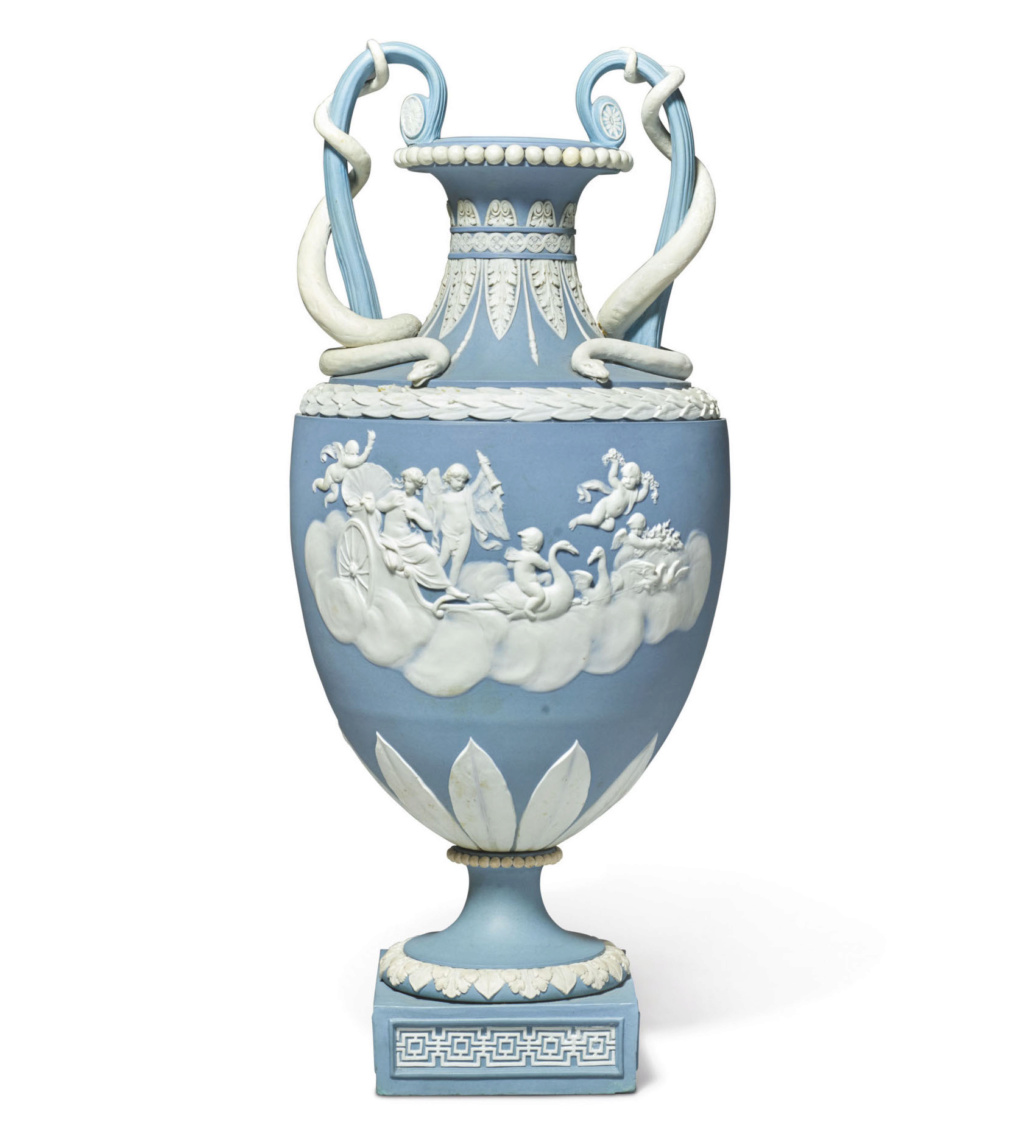
A WEDGWOOD BLUE AND WHITE JASPERWARE TWO HANDLED VASE
CIRCA 1785
vase no. 266, of campana shape, the solid-blue body applied in relief with sprigged figures of Venus in her chariot drawn by swans, the reverse with cupids watering swans, affixed on either side with a snake-entwined handle, impressed uppercase WEDGWOOD.
Height 15⅞ in. 40.3 cm
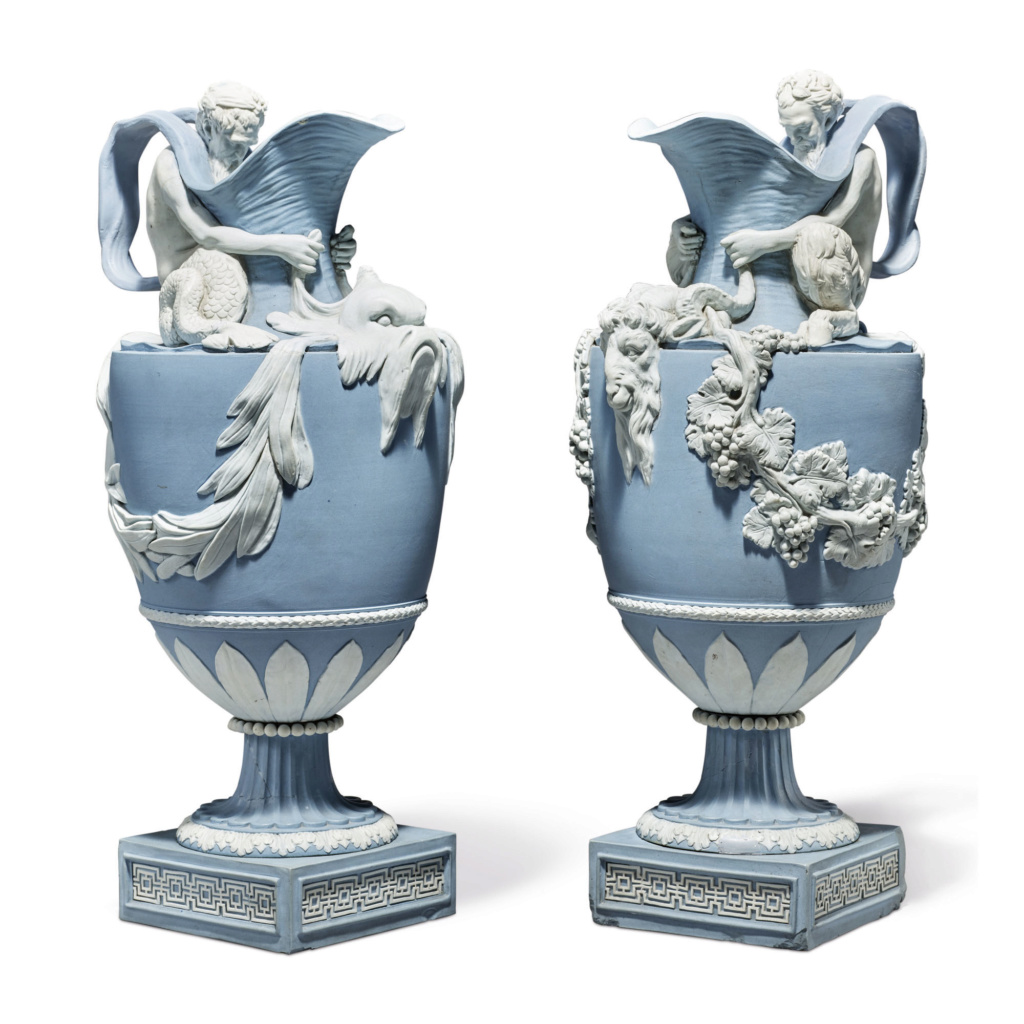
A PAIR OF WEDGWOOD BLUE AND WHITE JASPERWARE 'WATER' AND 'WINE' EWERS
CIRCA 1785-90
with a solid-blue body, each modeled with either a white jasper satyr or triton. representative of Bacchus or Neptune, seated upon the shoulder of the shield-shaped body, arms extending around its neck and grasping either the horns of a goat or the fins of a dolphin, above swags of either fruiting grapevine or waterweed, raised on a fluted stem and square base, both impressed uppercase WEDGWOOD, letter K.
Heights 15⅛ and 15⅜ in. 38.4 and 39 cm

A PAIR OF WEDGWOOD DARK-BLUE AND WHITE JASPER-DIP BOUGH POTS
CIRCA 1785-90
shape no. 369, of square form, the solid-blue jasper body dipped in dark blue and applied in white relief on each side with classical figurative subjects including the 'Dipping of Achilles', impressed uppercase WEDGWOOD, letter O or circle.
Height 6⅛ in. 15.5 cm
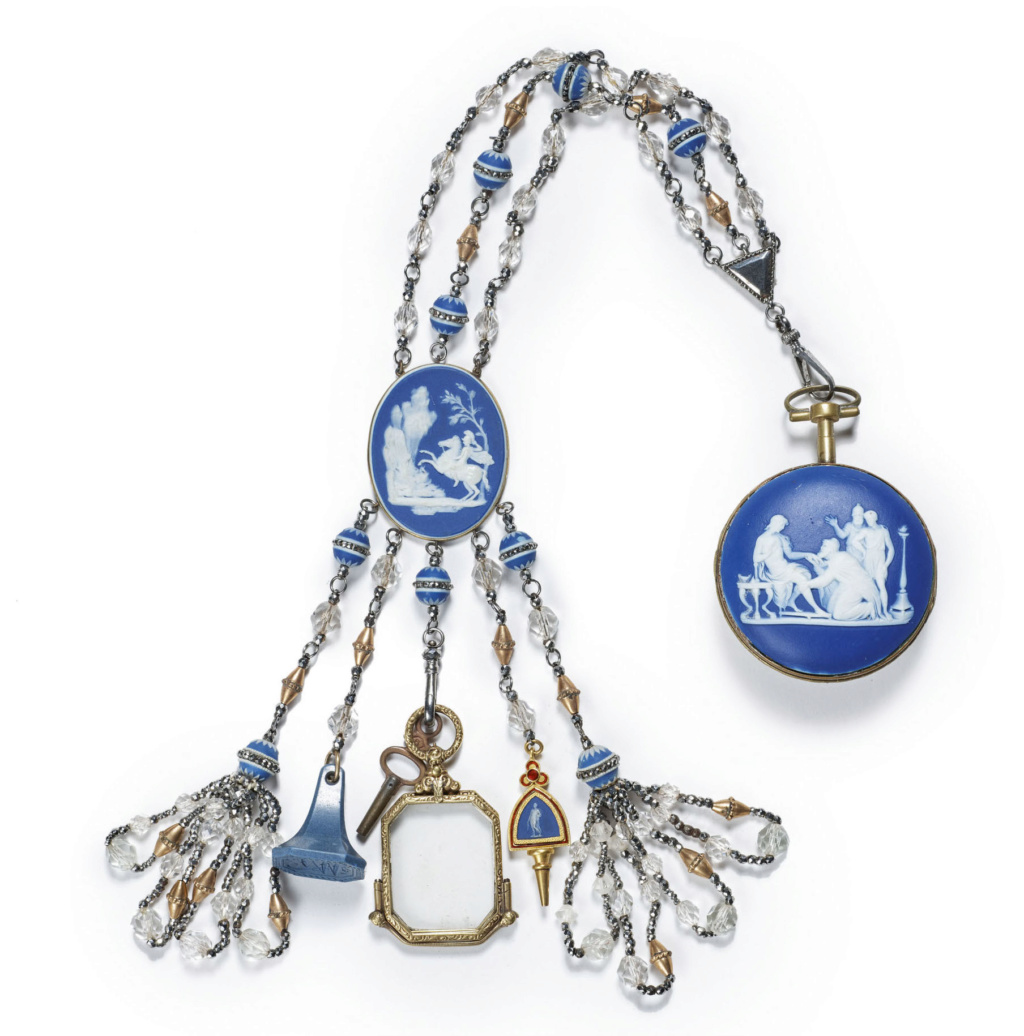
A WEDGWOOD BLUE AND WHITE JASPERWARE AND STEEL-CUT CHATELAINE
CIRCA 1800
the watch case with a dark-blue jasper back with white classical figures in low-relief, the enamel watch dial signed Philippe Terrot, with three chains of cut-steel, cut glass and jasper beads, with a small oval dark-blue jasper plaque, impressed WEDGWOOD, the lower section with various attachments, including clusters of glass beads, two keys and a seal.
Length 16½ in.
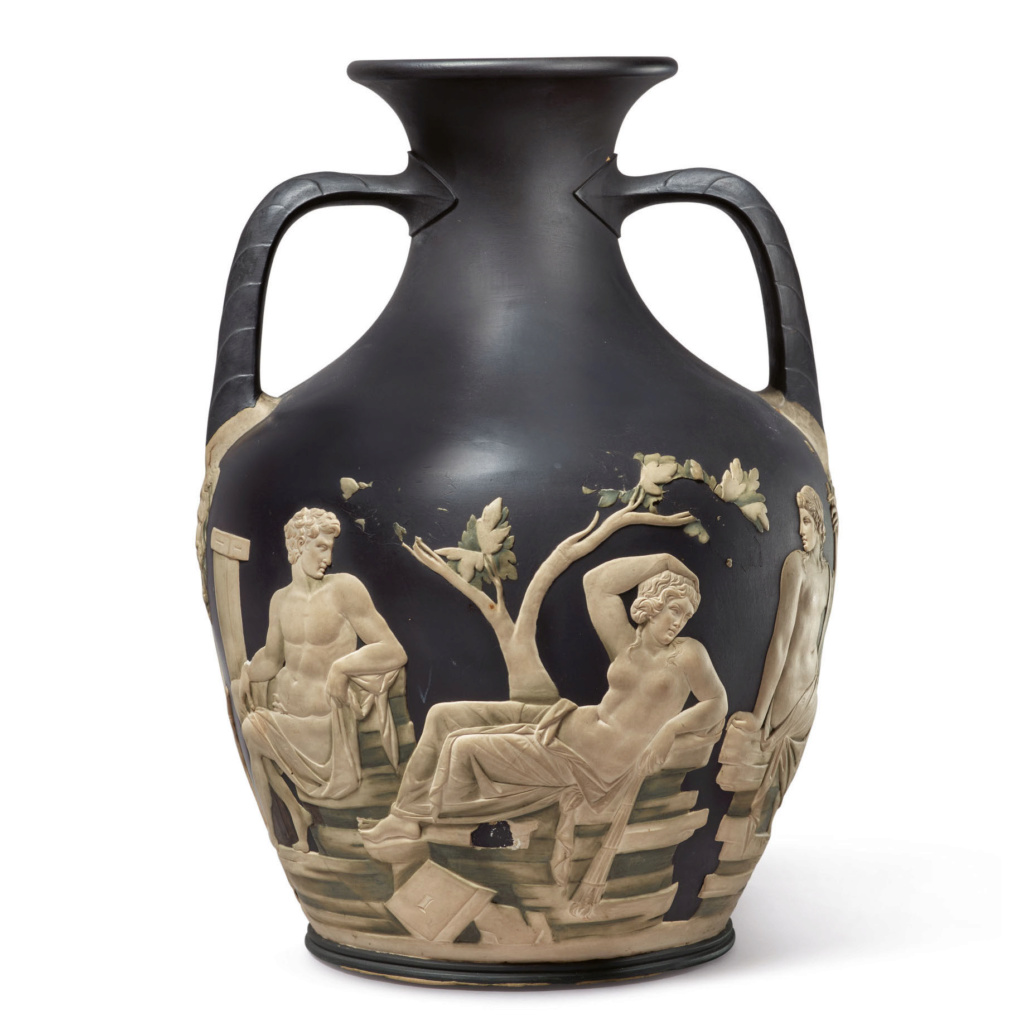
A WEDGWOOD BLACK AND WHITE JASPERWARE 'PORTLAND VASE'
LATE 18TH CENTURY
after the antique, of amphora form, with two molded scaled handles affixed at the shoulder with a flaring trumpet neck, applied in white relief with a continuous scene around the body with six classical figures and a cupid and on the underside with a roundel of Pan, embellished in tones of green-blue and brown.
Together with a ticket inscribed Admission/to see Mr. Wedgwood's Copy of/ THE PORTLAND VASE/ Greek Street, Soho/ between 12 o' Clock and 5. 2 pieces.
Height 10¼ in. 26 cm
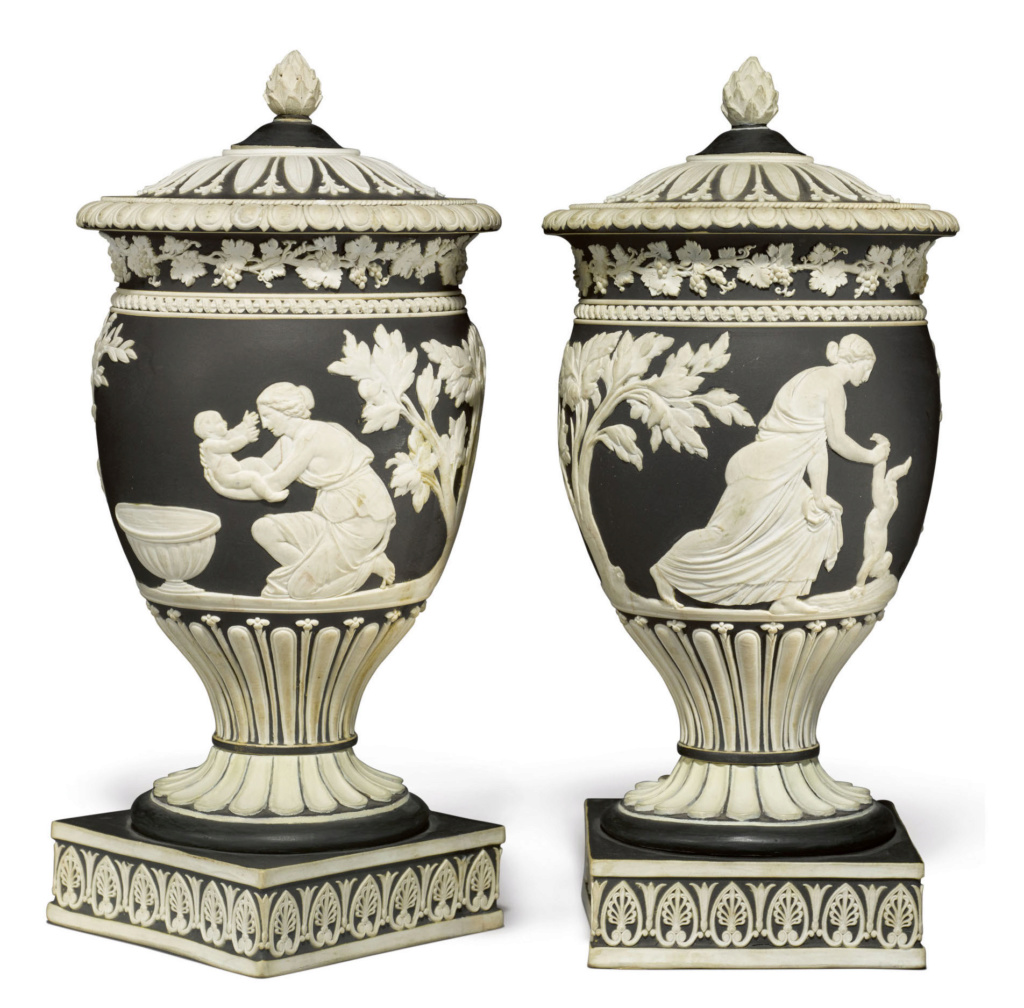
A PAIR OF WEDGWOOD BLACK JASPER-DIP VASES AND TWO COVERS
CIRCA 1785
each decorated in white relief with 'The Birth of Achilles' on one side and 'The Dipping of Achilles' on the other, impressed uppercase WEDGWOOD marks.
Height 9¾ in.24.7 cm
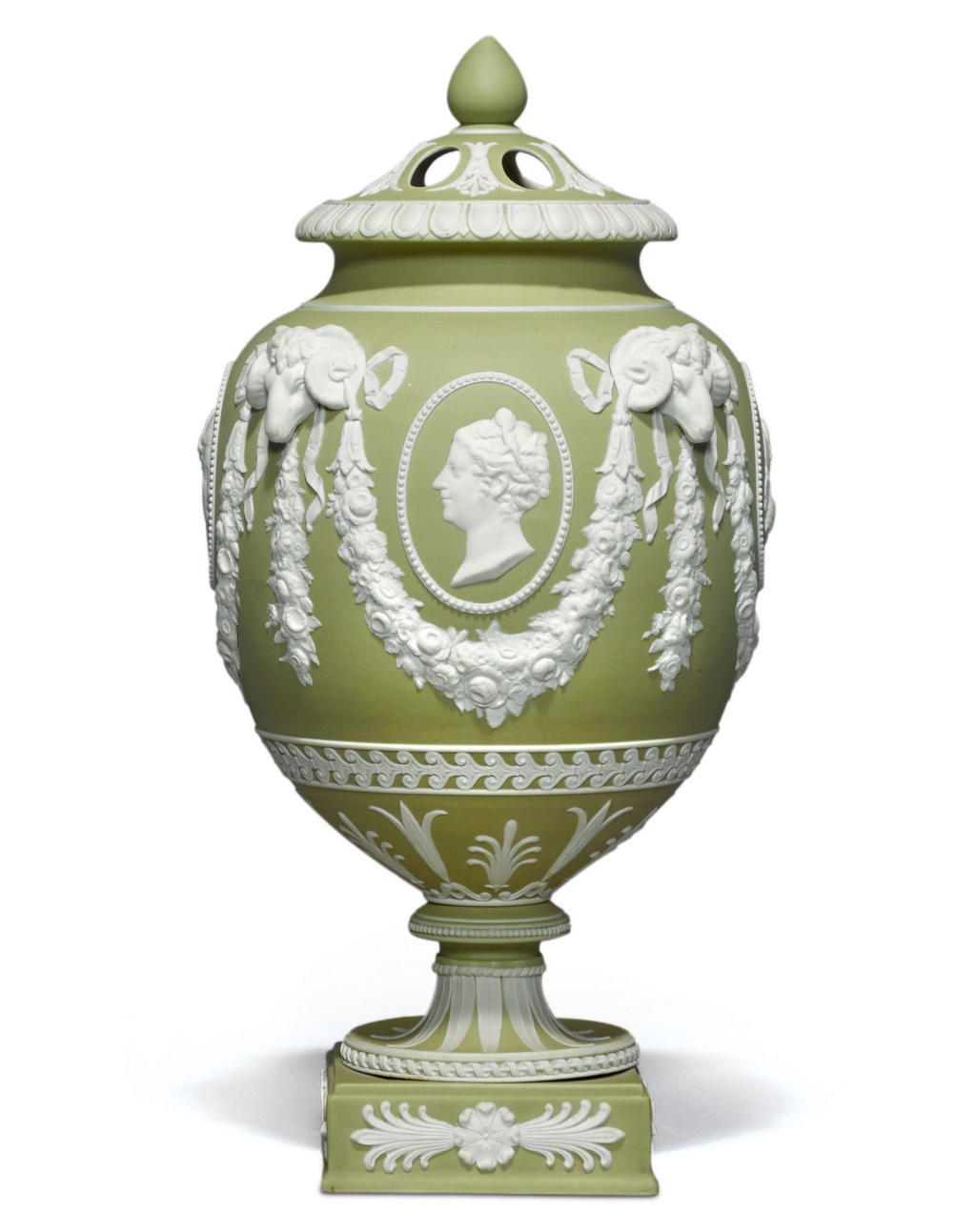
A WEDGWOOD GREEN JASPERWARE POT-POURRI VASE AND PIERCED COVER
CIRCA 1800
of ovoid form, the green-dipped body enriched in white, the shoulder affixed with four rams' heads suspending flower garlands reserving four portraits within oval frames of two Roman Emperors, Queen Marie Antoinette of France

impressed uppercase WEDGWOOD.
Height 14⅛ in. 36 cm
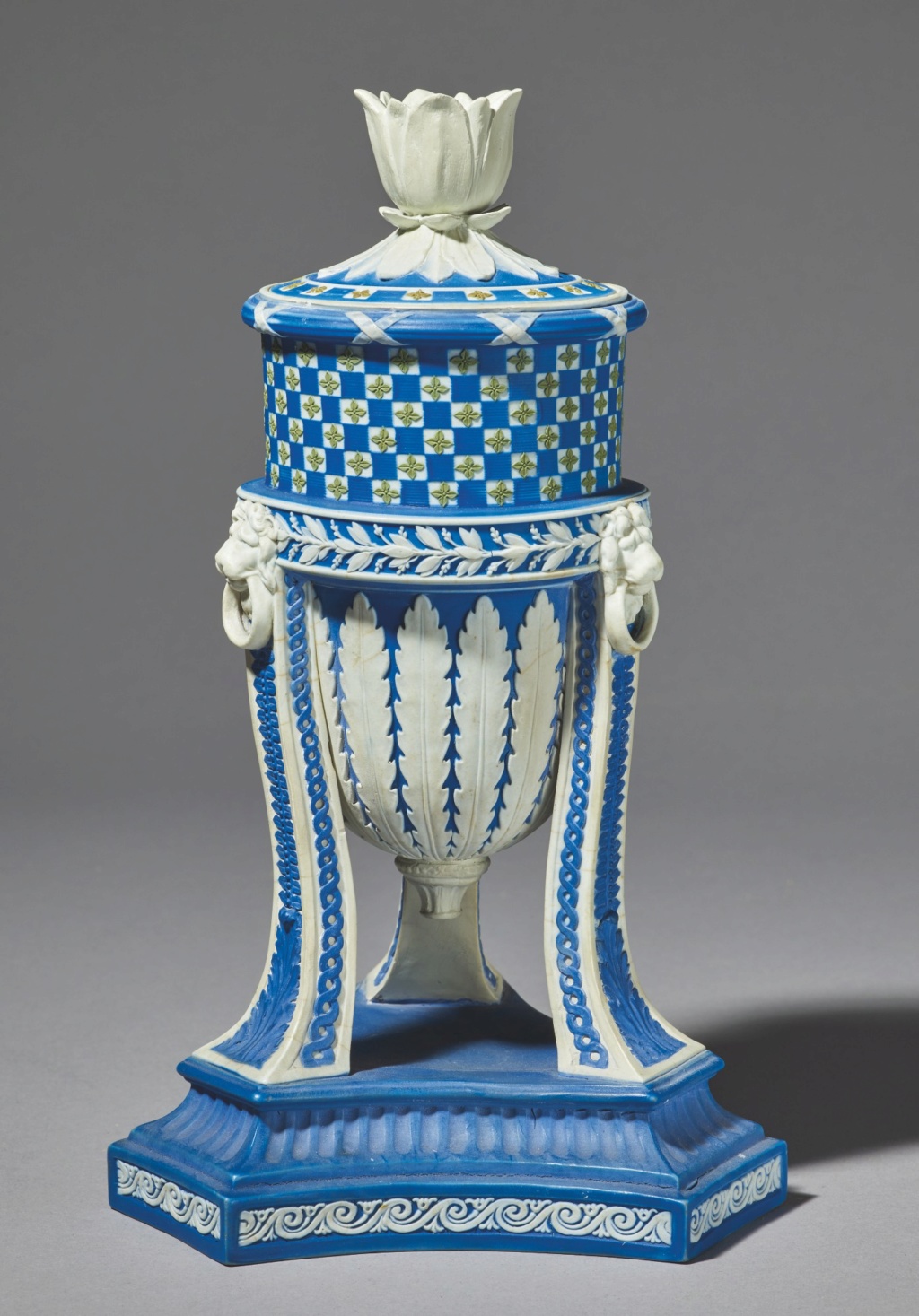 A WEDGWOOD THREE COLOUR JASPER-DIP CASSOLETTE VASE AND COVER
A WEDGWOOD THREE COLOUR JASPER-DIP CASSOLETTE VASE AND COVER CIRCA 1790
vase shape no. 255, the dark-blue ground decorated with a 'diced' pattern and green florets around the upper body, the lower section with stiff leaves, raised on three tall feet with lion and ring mask terminals, the rotatable cover with a floriform knop and sconce, impressed uppercase WEDGWOOD mark.
Height 10⅛ in. 25.8 cm

A WEDGWOOD FOUR-COLOR JASPER-DIP CIRCULAR BASKET AND THREE-COLOR STAND
CIRCA 1790
the blue-dipped basket decorated with shoots of white bamboo entwined with yellow rope work, the stand with the same pattern, the underside of the basket rim with an additional green entwined band, impressed uppercase WEDGWOOD, incised letter Z.
Diameter of stand 8¾ in. 22.2 cm
* Source, infos complémentaires, et de nombreux autres exemplaires de la manufacture, ici :

La nuit, la neige- Messages : 17807
Date d'inscription : 21/12/2013
 Re: La manufacture Wedgwood et sa production du XVIIIe siècle
Re: La manufacture Wedgwood et sa production du XVIIIe siècle
La nuit, la neige a écrit:
A PAIR OF WEDGWOOD BLUE AND WHITE JASPERWARE 'WATER' AND 'WINE' EWERS
CIRCA 1785-90
with a solid-blue body, each modeled with either a white jasper satyr or triton. representative of Bacchus or Neptune, seated upon the shoulder of the shield-shaped body, arms extending around its neck and grasping either the horns of a goat or the fins of a dolphin, above swags of either fruiting grapevine or waterweed, raised on a fluted stem and square base, both impressed uppercase WEDGWOOD, letter K.
Heights 15⅛ and 15⅜ in. 38.4 and 39 cm
C'est admirable.

Je les veux.



Duc d'Ostrogothie- Messages : 3182
Date d'inscription : 04/11/2017
 Re: La manufacture Wedgwood et sa production du XVIIIe siècle
Re: La manufacture Wedgwood et sa production du XVIIIe siècle
Les créations Wedgwood ne sont pas si chères (appréciation toute relative, bien entendu  ), y compris celles du XVIIIe siècle.
), y compris celles du XVIIIe siècle.
Déjà, à l'époque, elles étaient produites et commercialisées de façon bien moins élitistes que celles de la manufacture de Sèvres par exemple.
Le projet de Wedgwood et de ses associés était beaucoup plus "industriel", et voulait intéresser la "middle class" anglaise désireuse d'acquérir de jolies pièces sans pour autant dépenser des fortunes.
A l'exception, notamment, de l'un des quatre exemplaires produits du "First day vase", qui avait été mis en enchères par Christie's en 2016, et qui avait atteint la somme record d'environ 550 000 euros.
Mais bon c'est une pièce exceptionnelle, rarissime, et historique.
 Je recopie ici sa présentation au catalogue lors de sa vente aux enchères.
Je recopie ici sa présentation au catalogue lors de sa vente aux enchères.
C'est un peu long, en anglais, mais bon...c'est intéressant.
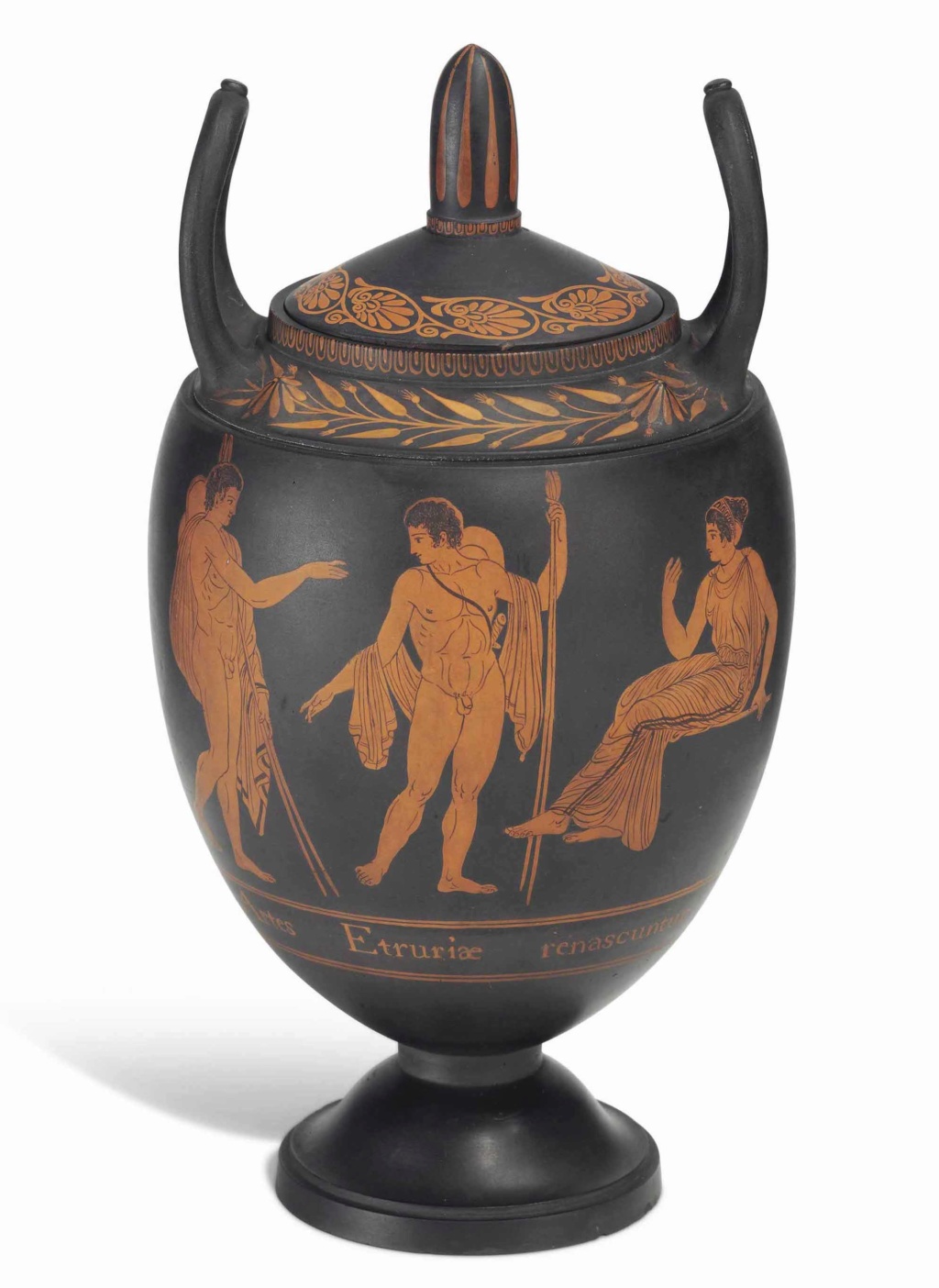
A WEDGWOOD BLACK ‘BASALTES’ ENCAUSTIC-DECORATED ‘FIRST DAY’S VASE’
1769
Oviform with curved upright loop handles, decorated in orange-red encaustic enamel with three classical figures above a titled frieze inscribed Artes Etruriae and renascuntur., the other side inscribed in encaustic enamel JUNE XIII .MDCC.LXIX./One of the first Days Productions/at/Etruria in Staffordshire,/by/Wedgwood and Bentley., above a band of palmettes, the neck moulded with bosses and decorated with a band of grass, the cover with a band of anthemion around a knop finial (finial cracked and restuck, minute chipping to rims)
10 in. (25.4 cm.) high
Image : Christie's
Provenance : Josiah Wedgwood I (1730-1795) ; Josiah Wedgwood II (1769-1843) ; Francis Wedgwood (1800-1888) ; Godfrey Wedgwood (1833-1905),
Cecil Wedgwod (1863-1916) ; Doris Audrey Wedgwood (1894-1968) who married Thomas Geoffrey Rowland Makeig-Jones (m.1928) ; Anne Makeig-Jones (b.1934)
Catalogue Note
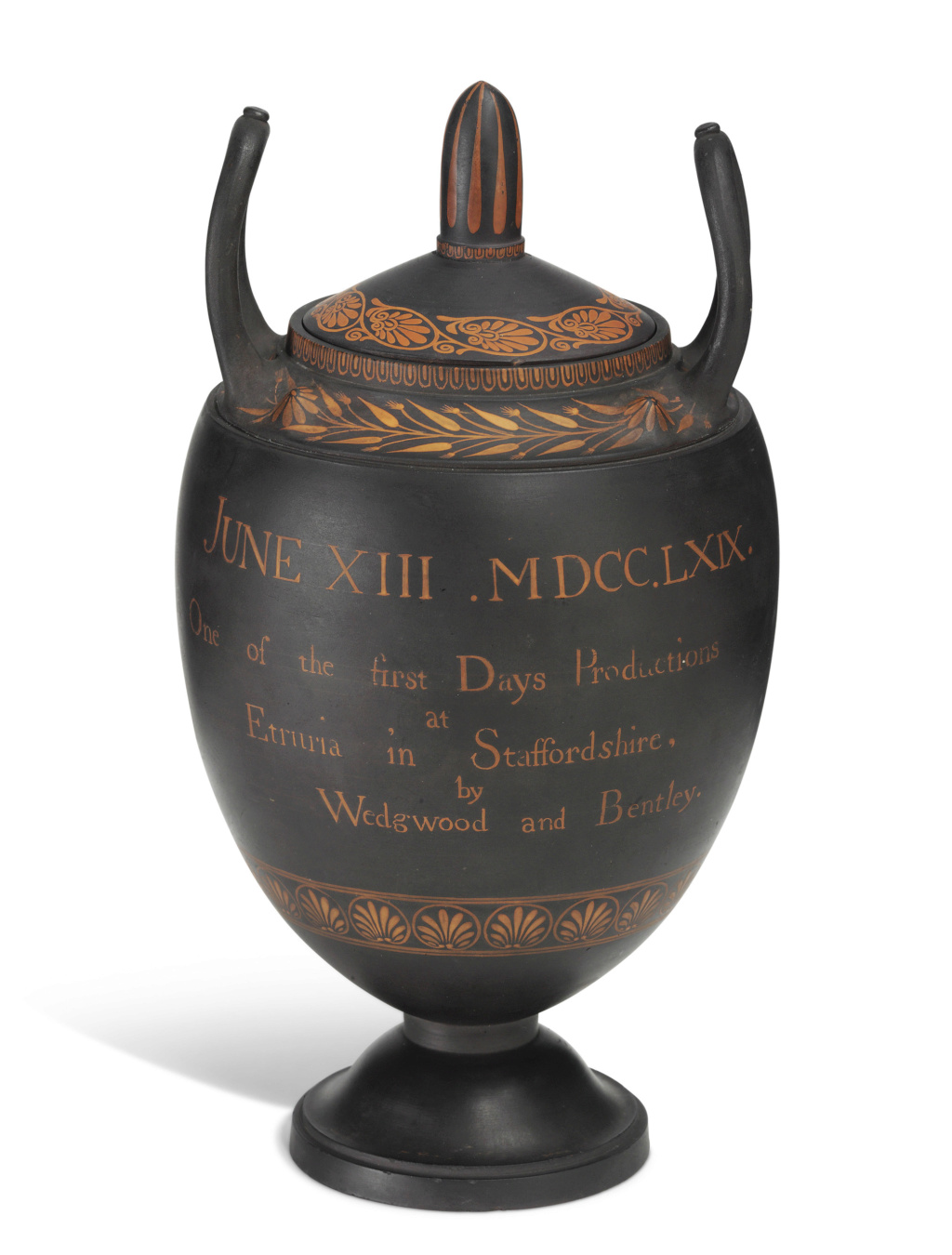
The opening of the new Etruria factory was celebrated on 13 June 1769 when Josiah Wedgwood threw six ‘First Day’s Vases’ with the help of his partner Thomas Bentley who turned the potters’ wheel.
Shortly after, the six vases were delivered to Bentley’s decorating workshop in Chelsea, where Wedgwood warned ‘The six Etruscan Vases, three handled sent to you a fortnight since were those we threw & turn’d the first at Etruria and sho’d be finish’d as high as you please but not sold, they being the first fruits of Etruria’.
Fanning the flames of a growing obsession with the classical world, Wedgwood was quick to take advantage of the commercial possibilities of producing wares in the fashionable ‘Antique’ style.
The shape of the First Day’s Vase was copied directly from an ancient vase in the collection of Sir William Hamilton and the classical red-figure decoration was taken from a plate in the first Volume of Hamilton’s catalogue, depicting Hercules in the Garden of Hesperides.
Only four of the vases survived the firing process and of these two are in the Wedgwood Museum in Stoke-on-Trent and a fourth is in a private collection.
Excitingly, the present First Day’s Vase has passed through generations of the Wedgwood family and is now offered for sale from the collection of the granddaughter of Cecil Wedgwood.
Each of the four surviving documentary vases proudly proclaim: Artes Etrurae Renascuntur, the Arts of Etruria are Reborn and they celebrate the beginning of one of the most important entrepreneurial and creative partnerships in the history of British art and manufacturing.
Josiah Wedgwood (1730-95) is arguably the most revered of British potters.
Coming from a large family of well-established potters in Staffordshire, he was the youngest child of Thomas and Mary Wedgwood of the Churchyard pottery in Burslem. Although his upbringing was modest, he was well-connected to important figures in the pottery industry. This included his cousins Thomas and John Wedgwood of the Big House who were successful manufacturers of saltglaze stoneware.
Following the death of his father, Josiah Wedgwood was apprenticed to his older brother Thomas where he was contracted ‘to learn…the said Art of Throwing and Handleing’.
Throwing was acknowledged as one of the most esteemed of a potter’s skills and only those who were to become master potters were allowed apprenticeships to develop these coveted skills. Josiah Wedgwood proved an ambitious and successful young man, moving to take advantage of several new partnerships, the first at Cliff Bank near Stoke and the second with Thomas Whieldon at Fenton Vivian.
It was with Whieldon, who was one of the leading potters in the region that Wedgwood began his celebrated ‘Experiment Book’ in which he recorded his scientific developments with glazes, clay slip and firing temperatures. These early experiments were key to his later commercial successes and the development of new types of pottery bodies and innovative decoration.
Josiah Wedgwood established his own manufactory, the Ivy House Works with his cousin Thomas in around 1759.
Building on early successes, he moved shortly after this to the Brick House Works. During this time he continually carried out experiments to finesse his creamware body and lead glaze.
It was with his creamware body that Wedgwood achieved wide acclaim and commercial success. Josiah was a great publicist of his own wares and during the 1760s he had a growing list of aristocratic patrons, all of whom sought his fashionable creamware.
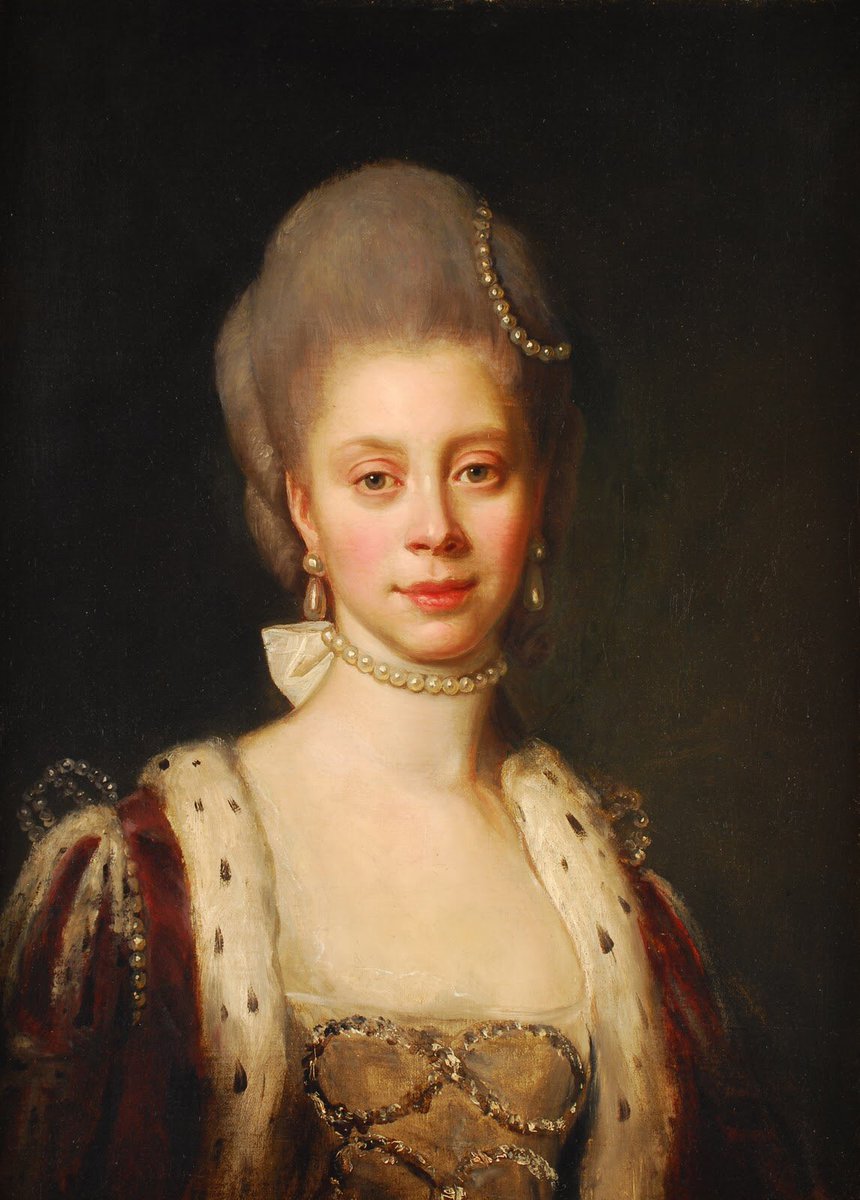
Charlotte of Mecklenburg-Strelitz (1744-1818)
Queen consort of Great Britain and Ireland, Electress, Queen consort of Hanover
By Nathaniel Dance-Holland
Oil on canvas, 1768
Image : Wikipedia
Wedgwood had also keenly courted the patronage of Queen Charlotte who had already commissioned a service from the Chelsea factory in 1762.
He gave gifts of creamware (and possibly a ‘caudle service’) to the Queen which culminated in an important royal commission in the form of an elaborate creamware tea-service decorated with raised green flowers on a gilt ground.
Following delivery of this service in 1766 Wedgwood became ‘Potter to Her Majesty’ and was permitted to call his creamware ‘Queen’s Ware’.
Wedgwood was quick to market his new ‘royal’ creamware and his fame rapidly spread enabling him to develop a flourishing export trade.
The Wedgwood and Bentley Partnership (1768 -1780)
It was on a visit to Liverpool in 1762 (where he was probably going to see the printers Sadler and Green3) that Wedgwood had a chance meeting with Thomas Bentley.
Following an attack of smallpox as an apprentice, Wedgwood had reoccurring problems with his right leg. During his trip to Liverpool, Wedgwood further damaged his right knee and was treated by the surgeon Matthew Turner who was a scholarly man of varied interests. Turner bought his friend Thomas Bentley (1730-80), a shipping agent for a Manchester merchant to meet Wedgwood.
A deep and long-lasting friendship was to develop between the two men which is well-documented as many of the letters that Wedgwood wrote to Bentley survive.
Writing his first letter to Bentley on 13 May 1762, Wedgwood’s warm regard for his new friend is evident ‘My much esteemed friend…there is not a day passes but I reflect with a pleasing gratitude upon the many kind offices I receiv’d in my confinement at your hospitable town. My good doctor and you in particular have my warmest gratitude for the share you both had in promoteing my recovery’.

Thomas Bentley
after Joachim Smith
Modern cast from original Wedgwood mould, white jasper on black dip, based on a work of circa 1773
Given by Josiah Wedgwood & Sons Ltd, 1922
Primary Collection
Image : National Portrait Gallery
Thomas Bentley was a well-travelled and cultivated man who had taken the Grand Tour in 1753. He was a man of refined tastes who had considerable knowledge of classical and renaissance art.
As a business partner Bentley offered Wedgwood not only essential commercial experience but also a deep understanding of changing tastes and market trends.
In combination with Wedgwood’s inventiveness and deep technical understanding of the art of pottery, Bentley was able to help shape and guide the direction of production.
Wedgwood wrote to Bentley ‘In the distribution of our employment between us the manufacturing has fallen to my lot and the sales to yours’.
In reality the partnership was much more than a business arrangement and Wedgwood sought Bentley’s opinion on every subject, writing ‘I fancy I can do anything with your help, and have been so much used to it, that when you are not with me upon these occasions I seem to have lost my right arm.’
Together Wedgwood and Bentley played an important part in the development and expansion of the Trent and Mersey Canal.
Such public activities brought both partners into contact with an array of important future patrons.
The success of the canal scheme allowed Wedgwood to expand his manufactory and he purchased a 350 acre estate through which the canal would pass.
This new advantageous position meant that it was much easier and cheaper to transport raw materials into the factory and to transport finished wares out.
The new purpose-built factory and the surrounding estate became known as Etruria, named after the ancient central state in Italy whose arts, most notably pottery, were being rediscovered in archaeological digs at the time.

Wedgwood Factory, Etruria
By John Wakefield
Wedgwood Museum
Image : ArtUK
The opening of the Etruria factory was momentarily interrupted when Wedgwood’s knee problem worsened, becoming so severe that he required an amputation.
He was later supplied with a wooden leg and under the care of his wife, Sarah, and with Bentley’s loyal companionship, his recovery was rapid.7
The production of the ‘First Day’s Vases’ at Etruria marked the beginning of the manufacturing of ‘ornamental’ wares by the Wedgwood and Bentley partnership which was formally agreed in 1769.
The Etruria factory was also key to the later successful mass production of ‘Useful’ wares which were produced under the partnership between Josiah and his cousin Thomas.
Josiah and his family were to reside on the estate in Etruria Hall and Bentley was given Bank House nearby.
Bentley did not choose to reside in Staffordshire however, but preferred to take up residence in London where he could oversee the establishment of a London warehouse and showrooms in St. Martin’s Lane (near the cabinet makers Chippendale, and Vile and Cobb) and later at No. 12 Greek Street in Soho.
Bentley also chose to live in the decorating workshop in Chelsea where he could supervise the artists. In London he could keep up to date with changing tastes and styles, manage orders and meet important customers, collect debts and deal with their ever expanding export trade.
Josiah Wedgwood was working in the pottery industry at a time of great change as a result of industrialisation.
The purpose-built Etruria factory was equipped with the latest technology including a water-wheel (supplying power by water drawn from the canal) and eight ‘hovels’ which contained ovens or kilns. There were wide gateways which were used for the delivery of clay and coal and the removal of waste.
Wedgwood claimed to be the first to introduce an engine-turning lathe into the pottery industry in 1763. Following experiments and improvements to the design of the lathe, Wedgwood was able to exploit its potential for use on a ‘basaltes’ body.
Wedgwood’s invention of the pyrometer, a thermometer which gave an accurate estimate of firing temperatures in a kiln further advanced ceramic production but it could also be used for other scientific purposes.
Through continual experimentation and refinement of manufacturing processes Wedgwood was able to stream-line production to a consistently high standard at a relatively low cost in order to meet the huge demand for his fashionable ornamental wares.
Amongst Wedgwood’s wide circle of gifted friends were members of the Lunar Society of Birmingham.
The society was established in 1765 with 14 members, all of whom met once a month (as close to a full moon as possible, which would enable a safe journey home) to attend discussions or practical demonstrations.
Members included Erasmus Darwin, Wedgwood’s family doctor and poet, Matthew Boulton, the metalworker, ‘toymaker’ and silversmith, James Watt the engineer and inventor, Joseph Priestly a preacher and chemist, and John Whitehurst, horologist and maker of scientific instruments.
Wedgwood would have benefitted greatly from discussions with such a creative and innovative group of individuals. He was at the forefront of new scientific developments during an age of enlightenment, discovery and enquiry.
Wedgwood and ‘The Antique’
Wedgwood’s fascination with the ‘Antique’ and rediscovery of the classical world was in part fuelled by the discoveries and excavations at Herculaneum in 1738 and Pompeii in 1763.
By the mid-18th century both Rome, and to a lesser extent Naples, had become essential destinations on the Grand Tour. Rome in particular became a place in which artists, collectors and intellectuals could meet and exchange ideas and admire new archaeological discoveries. Piranesi’s publications of views of Rome in the 1740s and Robert Adam’s Ruins of the Palace of Diocletian at Spalato, published in 1764, were widely disseminated, which both popularised classical architecture and lead to a reappraisal of ancient civilisations.
This obsession with the neo-classical was also a reaction against the extravagances of late Baroque and Rococo designs of the mid-18th century.
The neo-classical was deemed elegant, academic and ‘pure’ and Wedgwood was quick to realise the commercial possibilities of this movement.
His new stoneware was perfectly suited to the neo-classical ideals of restraint. Always with an eye on the commercial opportunities, many of the shapes of Wedgwood’s vases were based on classical forms, but they were often altered or exaggerated to appeal to his late 18th century cosmopolitan clientele.
It was not long before Wedgwood noticed that great queues of people had gathered outside his showrooms in London and ‘Vases was all the cry’.
Wedgwood’s showrooms in Great Newport Street had become a fashionable meeting place where ‘a violent Vase Madness (was) breaking out’.

The showrooms of Wedgwood & Byerley in St James's Square, London, 1809.
Image : Wedgwood Museum
Wedgwood creamware and basaltes were not confined to the mantlepieces of fashionable high society; they had become ‘a universal passion’.
Wedgwood took advantage of this fashion when formulating plans for his new Etruria factory. In a letter to Bentley in 1766 he claimed that he wanted to make a great ‘Vase work’ which would ‘Surprise the World’.
Wedgwood consulted Sir William Chambers in an attempt to establish the difference between ‘Urns & Vases’.
He concluded that the characteristic of an urn should be ‘simplicity, to have covers but no handles, nor spouts…ornamental…either high or low, but sho’d not seem to be Vessels for culinary, or sacred uses.’ Whereas ‘Vases were such as might be used for libations & other sacrificial, festive & culinary uses, such as Ewers, open vessels &c’.
This categorisation was important in the publication of future factory catalogues and his Ornamental Shapes Book.15
Sir William Hamilton
Sir William Hamilton was Ambassador to the court of Naples (1764-1800) and during his time in Italy he took a close interest in the excavations taking place at Herculaneum and Pompeii.
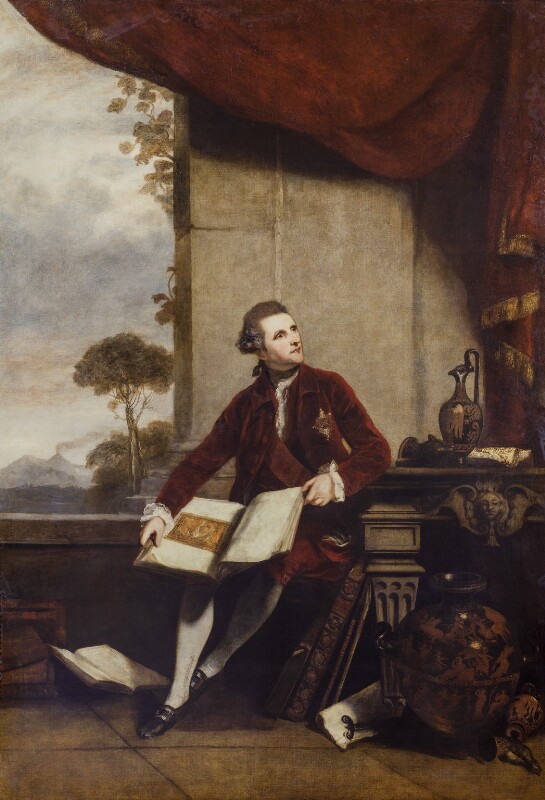
Sir William Hamilton
by Sir Joshua Reynolds
oil on canvas, 1777
Transferred from Tate Gallery, 1957
Image : National Portrait Gallery
He formed an important collection of ancient Greek and Italian vases which were sold to the British Museum in 1772.
Between 1766 and 1769 a four volume publication by d’Hancarville of Sir William Hamilton’s collection of antique vases ‘Antiquitiés, Etrusques, Grecques et Romaines’ appeared at a time when interest in the classical world was at its height.
The publication also helped to popularise the use of decorative garnitures of vases to adorn mantlepieces.
Wedgwood had formed an important friendship with Hamilton, who advised him on matters of taste and design while also helping to promote Wedgwood’s pottery amongst royal and aristocratic circles.
Wedgwood had access to early proofs of illustrations from Hamilton’s publication which were leant to him by Lord Cathcart and he was also presented with the first published volume of the catalogue.
The red figure decoration on the First Day’s Vases were taken from a vase in Hamilton’s collection, the Meidias Hydra of circa 420-400 BC, which was subsequently sold with the majority of Hamilton’s collection of ancient vases to the British Museum.
The figural decoration also appears on plate 129 in the first volume of Hamilton’s catalogue; the subject is titled Hercules in the garden of Hesperides and the three figures which appear on this particular version of the First Day’s Vase are Oineus, Demophon and Chrysis.

The Meidias Hydria
Attributed to The Meidias Painter
420BC-400BC (circa)
Purchased from Sir William Hamilton (1772)
Image : Trustees of the British Museum
The form of the vase was copied precisely from a vase which appears as part of an engraving in the preface to Volume I of Hamilton’s catalogue. Hamilton offered Wedgwood valuable advice on the design and interpretation of his antique vase collection, ‘Continue to be very attentive to the simplicity and elegance of the form, which is the chief article…You cannot consult the originals in the museum too often’.
Wedgwood and Bentley also had a vast library of reference books of engravings, from which they copied a number of shapes and bas-reliefs.
Amongst these were Jacques Stella’s Livre de Vases and James ‘Athenian’ Stuart’s Antiquities of Athens. Inspiration for vase shapes was drawn from a wide variety of sources including vases seen in London shops, or from the private collections of important patrons.
This included Hamilton’s famed Barberini vase, which he sold to the Duchess of Portland, who in turn leant it to Wedgwood who produced celebrated copies of it.
Wedgwood owed much to Hamilton for providing an extensive source of design inspiration for vase shapes, decoration and (later) for bas-relief ornament.
By 1768 Wedgwood had vases of three different types in production: creamware, variegated ware and black ‘basaltes’.
Whilst he had achieved great commercial success and market dominance with his production of creamware, interest in this was waning and new products were required to retain his patrons’ custom. Wedgwood was keen to replicate the look of ‘Egyptian black’ ware which was already in production at other Staffordshire potteries.
In order to recreate this black stoneware body, Wedgwood carried out countless experiments on local clay impregnated with carr, an oxide derived from iron residue taken from the local coal mines.
He found that he could create a ‘superior’ quality basaltes body by using magnesium to obtain a richer black colour together with west-country clay to give a finer texture.
Great care was taken in the purification of the cleansing of the local carr. Wedgwood was so excited by this new fashionable basaltes stoneware that he chose to use it for the production of his First Day’s Vases, rather than use his tried and tested creamware body, as basaltes was perfectly suited for vases in the neo-classical taste.
The first trials with black basaltes were probably carried out in July 1766 and in 1768 Wedgwood informed Bentley of the dispatch of twelve crates of wares including ‘a basket containing 2 Etruscan bronze Vases’.
This is the first mention of the basaltes body as ‘Etruscan’ which may perhaps have been a misunderstanding by Wedgwood as the pottery which was being excavated in Italy was predominately not Etruscan but had been imported from Greece.
Wedgwood had also seen illustrations of Etruscan bucchero nero from the 8th century BC which is a black pottery which is moulded or incised with ornament, and this may have inspired his use of the term. Either way, Wedgwood marketed all wares of this type as ‘Etruscan’.
The black surface could be polished with leather and then finished to look like simulated bronze, or as in the case of the present vase, decorated with encaustic painting.
In 1769 Wedgwood took out a patent for both his new bronzing process and for his red-orange encaustic-style decoration.
These processes were perfected to emulate the look of ancient bronze vessels and to recreate the Greek red-figure decoration which was seen on black-ground vases painted in Athens in circa 530-400 BC.
On receiving the first of his encaustic vases which were returned from his London decorating workshop, Wedgwood proclaimed ‘I have seen the vases Encaustick & like them exceedingly’.
The encaustic decoration on the present vase is most likely to be by the painter William Hopkins Craft, and not by David Rhodes of Leeds, as previously thought.
Craft was one of the most skilled painters employed by Wedgwood in their London decorating workshop, and he worked mainly on encaustic decoration of basaltes vases.
However, Craft demanded £200 a year, which Wedgwood considered ‘too extravagant to be lasting’ and their working relationship ended in 1771 when Craft became an independent enameller.
The death of Thomas Bentley in 1780 was a major loss for Josiah and he proved irreplaceable.
A year after Bentley’s death, Wedgwood decided to sell the stock and trade owned under their partnership at Christie’s & Ansell in Pall Mall.
The eleven day sale which included 1200 lots caused great excitement and was a huge commercial success.
(...)
* Source texte : Christie's - The Exceptional Sale, London 7 July 2016
 ), y compris celles du XVIIIe siècle.
), y compris celles du XVIIIe siècle. Déjà, à l'époque, elles étaient produites et commercialisées de façon bien moins élitistes que celles de la manufacture de Sèvres par exemple.
Le projet de Wedgwood et de ses associés était beaucoup plus "industriel", et voulait intéresser la "middle class" anglaise désireuse d'acquérir de jolies pièces sans pour autant dépenser des fortunes.
A l'exception, notamment, de l'un des quatre exemplaires produits du "First day vase", qui avait été mis en enchères par Christie's en 2016, et qui avait atteint la somme record d'environ 550 000 euros.

Mais bon c'est une pièce exceptionnelle, rarissime, et historique.
C'est un peu long, en anglais, mais bon...c'est intéressant.

A WEDGWOOD BLACK ‘BASALTES’ ENCAUSTIC-DECORATED ‘FIRST DAY’S VASE’
1769
Oviform with curved upright loop handles, decorated in orange-red encaustic enamel with three classical figures above a titled frieze inscribed Artes Etruriae and renascuntur., the other side inscribed in encaustic enamel JUNE XIII .MDCC.LXIX./One of the first Days Productions/at/Etruria in Staffordshire,/by/Wedgwood and Bentley., above a band of palmettes, the neck moulded with bosses and decorated with a band of grass, the cover with a band of anthemion around a knop finial (finial cracked and restuck, minute chipping to rims)
10 in. (25.4 cm.) high
Image : Christie's
Provenance : Josiah Wedgwood I (1730-1795) ; Josiah Wedgwood II (1769-1843) ; Francis Wedgwood (1800-1888) ; Godfrey Wedgwood (1833-1905),
Cecil Wedgwod (1863-1916) ; Doris Audrey Wedgwood (1894-1968) who married Thomas Geoffrey Rowland Makeig-Jones (m.1928) ; Anne Makeig-Jones (b.1934)
Catalogue Note

The opening of the new Etruria factory was celebrated on 13 June 1769 when Josiah Wedgwood threw six ‘First Day’s Vases’ with the help of his partner Thomas Bentley who turned the potters’ wheel.
Shortly after, the six vases were delivered to Bentley’s decorating workshop in Chelsea, where Wedgwood warned ‘The six Etruscan Vases, three handled sent to you a fortnight since were those we threw & turn’d the first at Etruria and sho’d be finish’d as high as you please but not sold, they being the first fruits of Etruria’.
Fanning the flames of a growing obsession with the classical world, Wedgwood was quick to take advantage of the commercial possibilities of producing wares in the fashionable ‘Antique’ style.
The shape of the First Day’s Vase was copied directly from an ancient vase in the collection of Sir William Hamilton and the classical red-figure decoration was taken from a plate in the first Volume of Hamilton’s catalogue, depicting Hercules in the Garden of Hesperides.
Only four of the vases survived the firing process and of these two are in the Wedgwood Museum in Stoke-on-Trent and a fourth is in a private collection.
Excitingly, the present First Day’s Vase has passed through generations of the Wedgwood family and is now offered for sale from the collection of the granddaughter of Cecil Wedgwood.
Each of the four surviving documentary vases proudly proclaim: Artes Etrurae Renascuntur, the Arts of Etruria are Reborn and they celebrate the beginning of one of the most important entrepreneurial and creative partnerships in the history of British art and manufacturing.
Josiah Wedgwood (1730-95) is arguably the most revered of British potters.
Coming from a large family of well-established potters in Staffordshire, he was the youngest child of Thomas and Mary Wedgwood of the Churchyard pottery in Burslem. Although his upbringing was modest, he was well-connected to important figures in the pottery industry. This included his cousins Thomas and John Wedgwood of the Big House who were successful manufacturers of saltglaze stoneware.
Following the death of his father, Josiah Wedgwood was apprenticed to his older brother Thomas where he was contracted ‘to learn…the said Art of Throwing and Handleing’.
Throwing was acknowledged as one of the most esteemed of a potter’s skills and only those who were to become master potters were allowed apprenticeships to develop these coveted skills. Josiah Wedgwood proved an ambitious and successful young man, moving to take advantage of several new partnerships, the first at Cliff Bank near Stoke and the second with Thomas Whieldon at Fenton Vivian.
It was with Whieldon, who was one of the leading potters in the region that Wedgwood began his celebrated ‘Experiment Book’ in which he recorded his scientific developments with glazes, clay slip and firing temperatures. These early experiments were key to his later commercial successes and the development of new types of pottery bodies and innovative decoration.
Josiah Wedgwood established his own manufactory, the Ivy House Works with his cousin Thomas in around 1759.
Building on early successes, he moved shortly after this to the Brick House Works. During this time he continually carried out experiments to finesse his creamware body and lead glaze.
It was with his creamware body that Wedgwood achieved wide acclaim and commercial success. Josiah was a great publicist of his own wares and during the 1760s he had a growing list of aristocratic patrons, all of whom sought his fashionable creamware.

Charlotte of Mecklenburg-Strelitz (1744-1818)
Queen consort of Great Britain and Ireland, Electress, Queen consort of Hanover
By Nathaniel Dance-Holland
Oil on canvas, 1768
Image : Wikipedia
Wedgwood had also keenly courted the patronage of Queen Charlotte who had already commissioned a service from the Chelsea factory in 1762.
He gave gifts of creamware (and possibly a ‘caudle service’) to the Queen which culminated in an important royal commission in the form of an elaborate creamware tea-service decorated with raised green flowers on a gilt ground.
Following delivery of this service in 1766 Wedgwood became ‘Potter to Her Majesty’ and was permitted to call his creamware ‘Queen’s Ware’.
Wedgwood was quick to market his new ‘royal’ creamware and his fame rapidly spread enabling him to develop a flourishing export trade.
The Wedgwood and Bentley Partnership (1768 -1780)
It was on a visit to Liverpool in 1762 (where he was probably going to see the printers Sadler and Green3) that Wedgwood had a chance meeting with Thomas Bentley.
Following an attack of smallpox as an apprentice, Wedgwood had reoccurring problems with his right leg. During his trip to Liverpool, Wedgwood further damaged his right knee and was treated by the surgeon Matthew Turner who was a scholarly man of varied interests. Turner bought his friend Thomas Bentley (1730-80), a shipping agent for a Manchester merchant to meet Wedgwood.
A deep and long-lasting friendship was to develop between the two men which is well-documented as many of the letters that Wedgwood wrote to Bentley survive.
Writing his first letter to Bentley on 13 May 1762, Wedgwood’s warm regard for his new friend is evident ‘My much esteemed friend…there is not a day passes but I reflect with a pleasing gratitude upon the many kind offices I receiv’d in my confinement at your hospitable town. My good doctor and you in particular have my warmest gratitude for the share you both had in promoteing my recovery’.

Thomas Bentley
after Joachim Smith
Modern cast from original Wedgwood mould, white jasper on black dip, based on a work of circa 1773
Given by Josiah Wedgwood & Sons Ltd, 1922
Primary Collection
Image : National Portrait Gallery
Thomas Bentley was a well-travelled and cultivated man who had taken the Grand Tour in 1753. He was a man of refined tastes who had considerable knowledge of classical and renaissance art.
As a business partner Bentley offered Wedgwood not only essential commercial experience but also a deep understanding of changing tastes and market trends.
In combination with Wedgwood’s inventiveness and deep technical understanding of the art of pottery, Bentley was able to help shape and guide the direction of production.
Wedgwood wrote to Bentley ‘In the distribution of our employment between us the manufacturing has fallen to my lot and the sales to yours’.
In reality the partnership was much more than a business arrangement and Wedgwood sought Bentley’s opinion on every subject, writing ‘I fancy I can do anything with your help, and have been so much used to it, that when you are not with me upon these occasions I seem to have lost my right arm.’
Together Wedgwood and Bentley played an important part in the development and expansion of the Trent and Mersey Canal.
Such public activities brought both partners into contact with an array of important future patrons.
The success of the canal scheme allowed Wedgwood to expand his manufactory and he purchased a 350 acre estate through which the canal would pass.
This new advantageous position meant that it was much easier and cheaper to transport raw materials into the factory and to transport finished wares out.
The new purpose-built factory and the surrounding estate became known as Etruria, named after the ancient central state in Italy whose arts, most notably pottery, were being rediscovered in archaeological digs at the time.

Wedgwood Factory, Etruria
By John Wakefield
Wedgwood Museum
Image : ArtUK
The opening of the Etruria factory was momentarily interrupted when Wedgwood’s knee problem worsened, becoming so severe that he required an amputation.
He was later supplied with a wooden leg and under the care of his wife, Sarah, and with Bentley’s loyal companionship, his recovery was rapid.7
The production of the ‘First Day’s Vases’ at Etruria marked the beginning of the manufacturing of ‘ornamental’ wares by the Wedgwood and Bentley partnership which was formally agreed in 1769.
The Etruria factory was also key to the later successful mass production of ‘Useful’ wares which were produced under the partnership between Josiah and his cousin Thomas.
Josiah and his family were to reside on the estate in Etruria Hall and Bentley was given Bank House nearby.
Bentley did not choose to reside in Staffordshire however, but preferred to take up residence in London where he could oversee the establishment of a London warehouse and showrooms in St. Martin’s Lane (near the cabinet makers Chippendale, and Vile and Cobb) and later at No. 12 Greek Street in Soho.
Bentley also chose to live in the decorating workshop in Chelsea where he could supervise the artists. In London he could keep up to date with changing tastes and styles, manage orders and meet important customers, collect debts and deal with their ever expanding export trade.
Josiah Wedgwood was working in the pottery industry at a time of great change as a result of industrialisation.
The purpose-built Etruria factory was equipped with the latest technology including a water-wheel (supplying power by water drawn from the canal) and eight ‘hovels’ which contained ovens or kilns. There were wide gateways which were used for the delivery of clay and coal and the removal of waste.
Wedgwood claimed to be the first to introduce an engine-turning lathe into the pottery industry in 1763. Following experiments and improvements to the design of the lathe, Wedgwood was able to exploit its potential for use on a ‘basaltes’ body.
Wedgwood’s invention of the pyrometer, a thermometer which gave an accurate estimate of firing temperatures in a kiln further advanced ceramic production but it could also be used for other scientific purposes.
Through continual experimentation and refinement of manufacturing processes Wedgwood was able to stream-line production to a consistently high standard at a relatively low cost in order to meet the huge demand for his fashionable ornamental wares.
Amongst Wedgwood’s wide circle of gifted friends were members of the Lunar Society of Birmingham.
The society was established in 1765 with 14 members, all of whom met once a month (as close to a full moon as possible, which would enable a safe journey home) to attend discussions or practical demonstrations.
Members included Erasmus Darwin, Wedgwood’s family doctor and poet, Matthew Boulton, the metalworker, ‘toymaker’ and silversmith, James Watt the engineer and inventor, Joseph Priestly a preacher and chemist, and John Whitehurst, horologist and maker of scientific instruments.
Wedgwood would have benefitted greatly from discussions with such a creative and innovative group of individuals. He was at the forefront of new scientific developments during an age of enlightenment, discovery and enquiry.
Wedgwood and ‘The Antique’
Wedgwood’s fascination with the ‘Antique’ and rediscovery of the classical world was in part fuelled by the discoveries and excavations at Herculaneum in 1738 and Pompeii in 1763.
By the mid-18th century both Rome, and to a lesser extent Naples, had become essential destinations on the Grand Tour. Rome in particular became a place in which artists, collectors and intellectuals could meet and exchange ideas and admire new archaeological discoveries. Piranesi’s publications of views of Rome in the 1740s and Robert Adam’s Ruins of the Palace of Diocletian at Spalato, published in 1764, were widely disseminated, which both popularised classical architecture and lead to a reappraisal of ancient civilisations.
This obsession with the neo-classical was also a reaction against the extravagances of late Baroque and Rococo designs of the mid-18th century.
The neo-classical was deemed elegant, academic and ‘pure’ and Wedgwood was quick to realise the commercial possibilities of this movement.
His new stoneware was perfectly suited to the neo-classical ideals of restraint. Always with an eye on the commercial opportunities, many of the shapes of Wedgwood’s vases were based on classical forms, but they were often altered or exaggerated to appeal to his late 18th century cosmopolitan clientele.
It was not long before Wedgwood noticed that great queues of people had gathered outside his showrooms in London and ‘Vases was all the cry’.
Wedgwood’s showrooms in Great Newport Street had become a fashionable meeting place where ‘a violent Vase Madness (was) breaking out’.

The showrooms of Wedgwood & Byerley in St James's Square, London, 1809.
Image : Wedgwood Museum
Wedgwood creamware and basaltes were not confined to the mantlepieces of fashionable high society; they had become ‘a universal passion’.
Wedgwood took advantage of this fashion when formulating plans for his new Etruria factory. In a letter to Bentley in 1766 he claimed that he wanted to make a great ‘Vase work’ which would ‘Surprise the World’.
Wedgwood consulted Sir William Chambers in an attempt to establish the difference between ‘Urns & Vases’.
He concluded that the characteristic of an urn should be ‘simplicity, to have covers but no handles, nor spouts…ornamental…either high or low, but sho’d not seem to be Vessels for culinary, or sacred uses.’ Whereas ‘Vases were such as might be used for libations & other sacrificial, festive & culinary uses, such as Ewers, open vessels &c’.
This categorisation was important in the publication of future factory catalogues and his Ornamental Shapes Book.15
Sir William Hamilton
Sir William Hamilton was Ambassador to the court of Naples (1764-1800) and during his time in Italy he took a close interest in the excavations taking place at Herculaneum and Pompeii.

Sir William Hamilton
by Sir Joshua Reynolds
oil on canvas, 1777
Transferred from Tate Gallery, 1957
Image : National Portrait Gallery
He formed an important collection of ancient Greek and Italian vases which were sold to the British Museum in 1772.
Between 1766 and 1769 a four volume publication by d’Hancarville of Sir William Hamilton’s collection of antique vases ‘Antiquitiés, Etrusques, Grecques et Romaines’ appeared at a time when interest in the classical world was at its height.
The publication also helped to popularise the use of decorative garnitures of vases to adorn mantlepieces.
Wedgwood had formed an important friendship with Hamilton, who advised him on matters of taste and design while also helping to promote Wedgwood’s pottery amongst royal and aristocratic circles.
Wedgwood had access to early proofs of illustrations from Hamilton’s publication which were leant to him by Lord Cathcart and he was also presented with the first published volume of the catalogue.
The red figure decoration on the First Day’s Vases were taken from a vase in Hamilton’s collection, the Meidias Hydra of circa 420-400 BC, which was subsequently sold with the majority of Hamilton’s collection of ancient vases to the British Museum.
The figural decoration also appears on plate 129 in the first volume of Hamilton’s catalogue; the subject is titled Hercules in the garden of Hesperides and the three figures which appear on this particular version of the First Day’s Vase are Oineus, Demophon and Chrysis.

The Meidias Hydria
Attributed to The Meidias Painter
420BC-400BC (circa)
Purchased from Sir William Hamilton (1772)
Image : Trustees of the British Museum
The form of the vase was copied precisely from a vase which appears as part of an engraving in the preface to Volume I of Hamilton’s catalogue. Hamilton offered Wedgwood valuable advice on the design and interpretation of his antique vase collection, ‘Continue to be very attentive to the simplicity and elegance of the form, which is the chief article…You cannot consult the originals in the museum too often’.
Wedgwood and Bentley also had a vast library of reference books of engravings, from which they copied a number of shapes and bas-reliefs.
Amongst these were Jacques Stella’s Livre de Vases and James ‘Athenian’ Stuart’s Antiquities of Athens. Inspiration for vase shapes was drawn from a wide variety of sources including vases seen in London shops, or from the private collections of important patrons.
This included Hamilton’s famed Barberini vase, which he sold to the Duchess of Portland, who in turn leant it to Wedgwood who produced celebrated copies of it.
Wedgwood owed much to Hamilton for providing an extensive source of design inspiration for vase shapes, decoration and (later) for bas-relief ornament.
By 1768 Wedgwood had vases of three different types in production: creamware, variegated ware and black ‘basaltes’.
Whilst he had achieved great commercial success and market dominance with his production of creamware, interest in this was waning and new products were required to retain his patrons’ custom. Wedgwood was keen to replicate the look of ‘Egyptian black’ ware which was already in production at other Staffordshire potteries.
In order to recreate this black stoneware body, Wedgwood carried out countless experiments on local clay impregnated with carr, an oxide derived from iron residue taken from the local coal mines.
He found that he could create a ‘superior’ quality basaltes body by using magnesium to obtain a richer black colour together with west-country clay to give a finer texture.
Great care was taken in the purification of the cleansing of the local carr. Wedgwood was so excited by this new fashionable basaltes stoneware that he chose to use it for the production of his First Day’s Vases, rather than use his tried and tested creamware body, as basaltes was perfectly suited for vases in the neo-classical taste.
The first trials with black basaltes were probably carried out in July 1766 and in 1768 Wedgwood informed Bentley of the dispatch of twelve crates of wares including ‘a basket containing 2 Etruscan bronze Vases’.
This is the first mention of the basaltes body as ‘Etruscan’ which may perhaps have been a misunderstanding by Wedgwood as the pottery which was being excavated in Italy was predominately not Etruscan but had been imported from Greece.
Wedgwood had also seen illustrations of Etruscan bucchero nero from the 8th century BC which is a black pottery which is moulded or incised with ornament, and this may have inspired his use of the term. Either way, Wedgwood marketed all wares of this type as ‘Etruscan’.
The black surface could be polished with leather and then finished to look like simulated bronze, or as in the case of the present vase, decorated with encaustic painting.
In 1769 Wedgwood took out a patent for both his new bronzing process and for his red-orange encaustic-style decoration.
These processes were perfected to emulate the look of ancient bronze vessels and to recreate the Greek red-figure decoration which was seen on black-ground vases painted in Athens in circa 530-400 BC.
On receiving the first of his encaustic vases which were returned from his London decorating workshop, Wedgwood proclaimed ‘I have seen the vases Encaustick & like them exceedingly’.
The encaustic decoration on the present vase is most likely to be by the painter William Hopkins Craft, and not by David Rhodes of Leeds, as previously thought.
Craft was one of the most skilled painters employed by Wedgwood in their London decorating workshop, and he worked mainly on encaustic decoration of basaltes vases.
However, Craft demanded £200 a year, which Wedgwood considered ‘too extravagant to be lasting’ and their working relationship ended in 1771 when Craft became an independent enameller.
The death of Thomas Bentley in 1780 was a major loss for Josiah and he proved irreplaceable.
A year after Bentley’s death, Wedgwood decided to sell the stock and trade owned under their partnership at Christie’s & Ansell in Pall Mall.
The eleven day sale which included 1200 lots caused great excitement and was a huge commercial success.
(...)
* Source texte : Christie's - The Exceptional Sale, London 7 July 2016

La nuit, la neige- Messages : 17807
Date d'inscription : 21/12/2013
 Re: La manufacture Wedgwood et sa production du XVIIIe siècle
Re: La manufacture Wedgwood et sa production du XVIIIe siècle
Merci LNLN pour ce magnifique et riche article 

Quelques autres pièces du service, vues en 2015 à l'Hermitage Amsterdam dans le cadre de l'exposition "Dining with the Tsars" - copie de mon post sur CDV en 2015 :
Il ne s'agit plus ici d'un présent mais bien d'une commande passée directement par l'Impératrice Catherine. Le choix d'une manufacture anglaise apparaît comme évident lorsque l'on sait que ce service était destiné au pavillon/relais de Kekerekeksinen ("grenouille verte" en finlandais, et donc représentée de manière héraldique sur les plats), merveille du premier néo-gothique cher à Walpole, et situé sur la route de Tsarkoie-Tselo :

http://www.encspb.ru/object/2855717501?lc=en
Ce service de 944 pièces (dîner et dessert) fut commandé à Joshuah Wedgwood en 1773. Il arbore 1 222 vues toutes différentes de monuments anglais. Il est présenté accompagné d'un surtout de Thomire, acquis à Paris vers 1810. Au vrai, la confrontation n'est pas très heureuse.


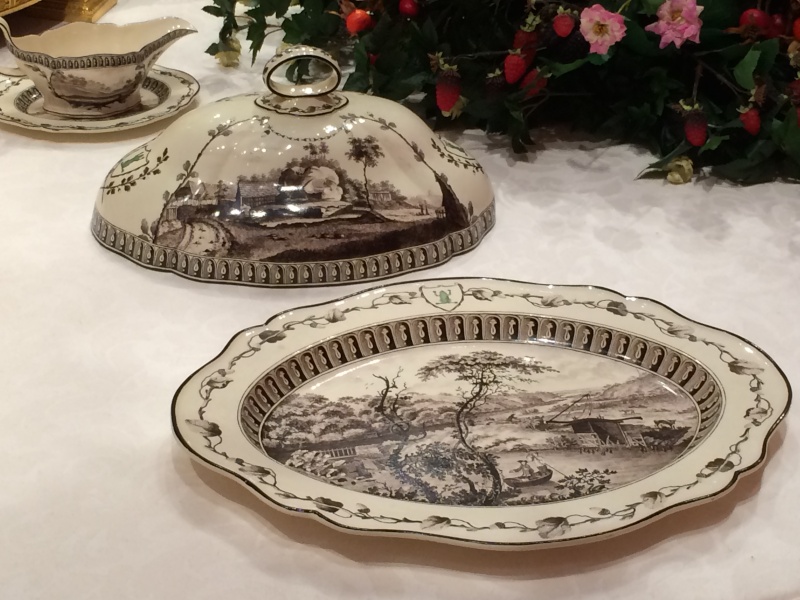
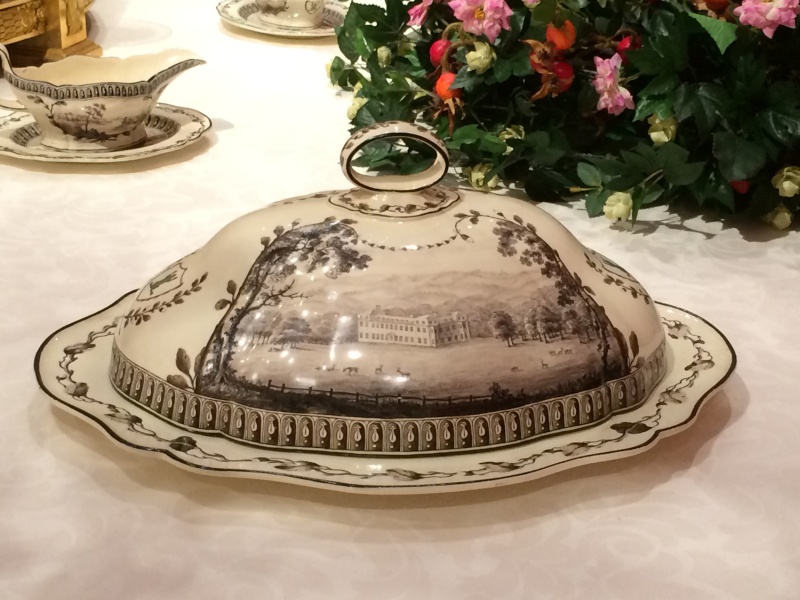
Clichés personnels


La nuit, la neige a écrit:
Pieces from the Green Frog Service, ordered by Catherine II of Russia, 1773
The Green Frog Service is considered one of the masterpieces of the Wedgwood Collection.
It was produced under commission for Catherine II in 1773, who requested a 952-piece dinner and dessert service – each to be hand-painted with a view of Britain.
The set was intended for her home at Kekerekeksinensky Palace – the name of which translates as 'frog marsh' in Finnish – explaining the green enamel amphibian crest that features in the design. Josiah employed artists to work up the sketches and also used a camera obscura to capture some scenes.
The set cost Catherine £2,290,12s.4d and was dispatched to St Petersburg by sea in 11 crates.
Source et image : Artfund.org
Quelques autres pièces du service, vues en 2015 à l'Hermitage Amsterdam dans le cadre de l'exposition "Dining with the Tsars" - copie de mon post sur CDV en 2015 :
Il ne s'agit plus ici d'un présent mais bien d'une commande passée directement par l'Impératrice Catherine. Le choix d'une manufacture anglaise apparaît comme évident lorsque l'on sait que ce service était destiné au pavillon/relais de Kekerekeksinen ("grenouille verte" en finlandais, et donc représentée de manière héraldique sur les plats), merveille du premier néo-gothique cher à Walpole, et situé sur la route de Tsarkoie-Tselo :

http://www.encspb.ru/object/2855717501?lc=en
Ce service de 944 pièces (dîner et dessert) fut commandé à Joshuah Wedgwood en 1773. Il arbore 1 222 vues toutes différentes de monuments anglais. Il est présenté accompagné d'un surtout de Thomire, acquis à Paris vers 1810. Au vrai, la confrontation n'est pas très heureuse.




Clichés personnels
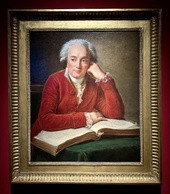
Gouverneur Morris- Messages : 11387
Date d'inscription : 21/12/2013
 Re: La manufacture Wedgwood et sa production du XVIIIe siècle
Re: La manufacture Wedgwood et sa production du XVIIIe siècle
Merci beaucoup pour ces images ! 
 Nous nous souvenons que tu nous avais présenté un autre service de Catherine II vu lors de cette même exposition : en l'occurence celui de l'ordre de Saint-Georges (qui n'est pas de Wedgwood).
Nous nous souvenons que tu nous avais présenté un autre service de Catherine II vu lors de cette même exposition : en l'occurence celui de l'ordre de Saint-Georges (qui n'est pas de Wedgwood).
 C'était ici : Les services en porcelaine aux ordres impériaux de Catherine II
C'était ici : Les services en porcelaine aux ordres impériaux de Catherine II

La nuit, la neige- Messages : 17807
Date d'inscription : 21/12/2013
 Re: La manufacture Wedgwood et sa production du XVIIIe siècle
Re: La manufacture Wedgwood et sa production du XVIIIe siècle
Il neige sur ce magnifique surtout de table ?!

Merci à tous les deux !!!

_________________
... demain est un autre jour .

Mme de Sabran- Messages : 54725
Date d'inscription : 21/12/2013
Localisation : l'Ouest sauvage
 Re: La manufacture Wedgwood et sa production du XVIIIe siècle
Re: La manufacture Wedgwood et sa production du XVIIIe siècle
Mme de Sabran a écrit:Il neige sur ce magnifique surtout de table ?!
C'était juste une décoration de fleurs en papier, destinée à rendre moins effrayants les barreaux entourant chaque table reconstituée pour l'exposition

Voici les cartels de l'expo le concernant :
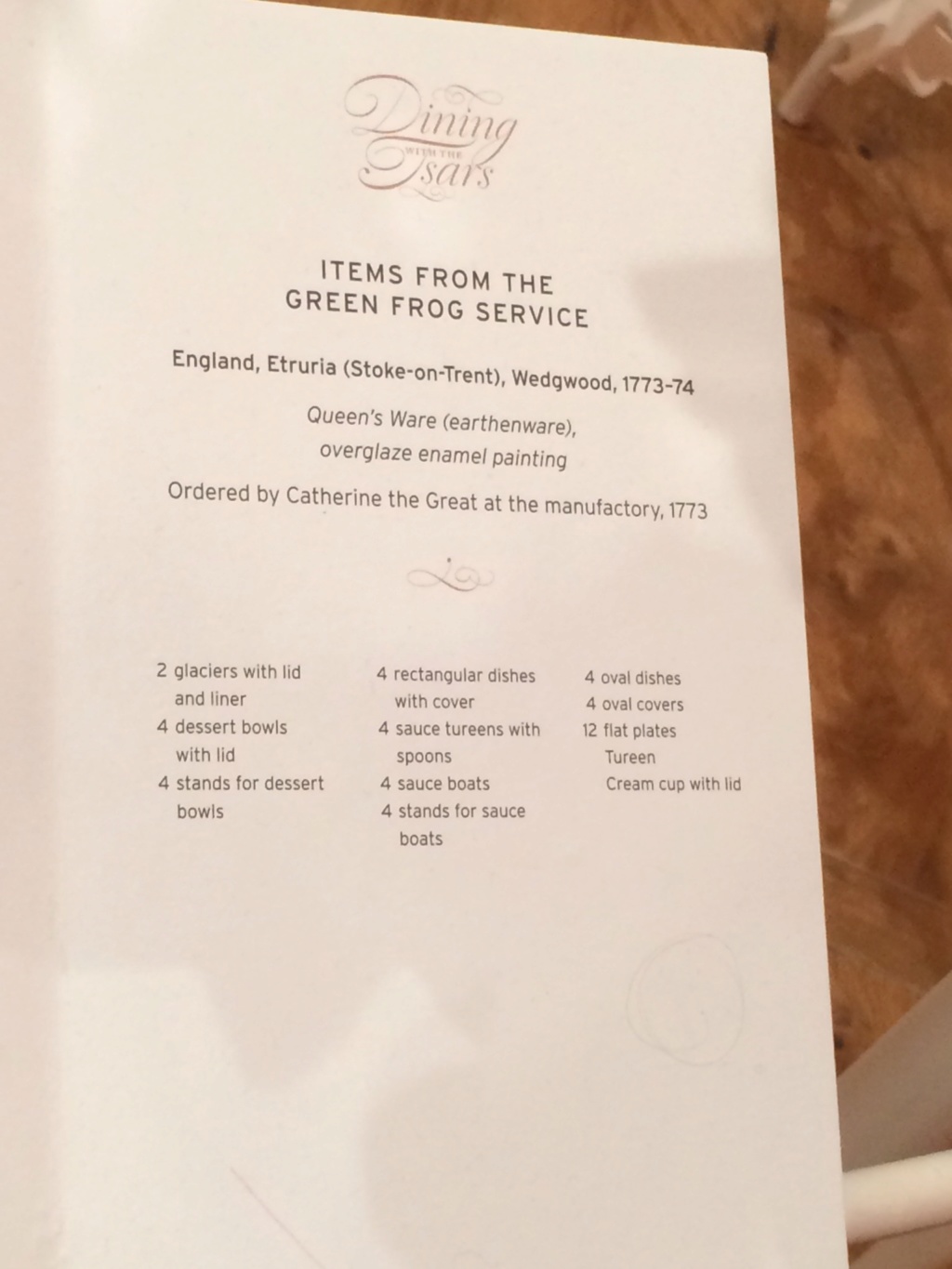
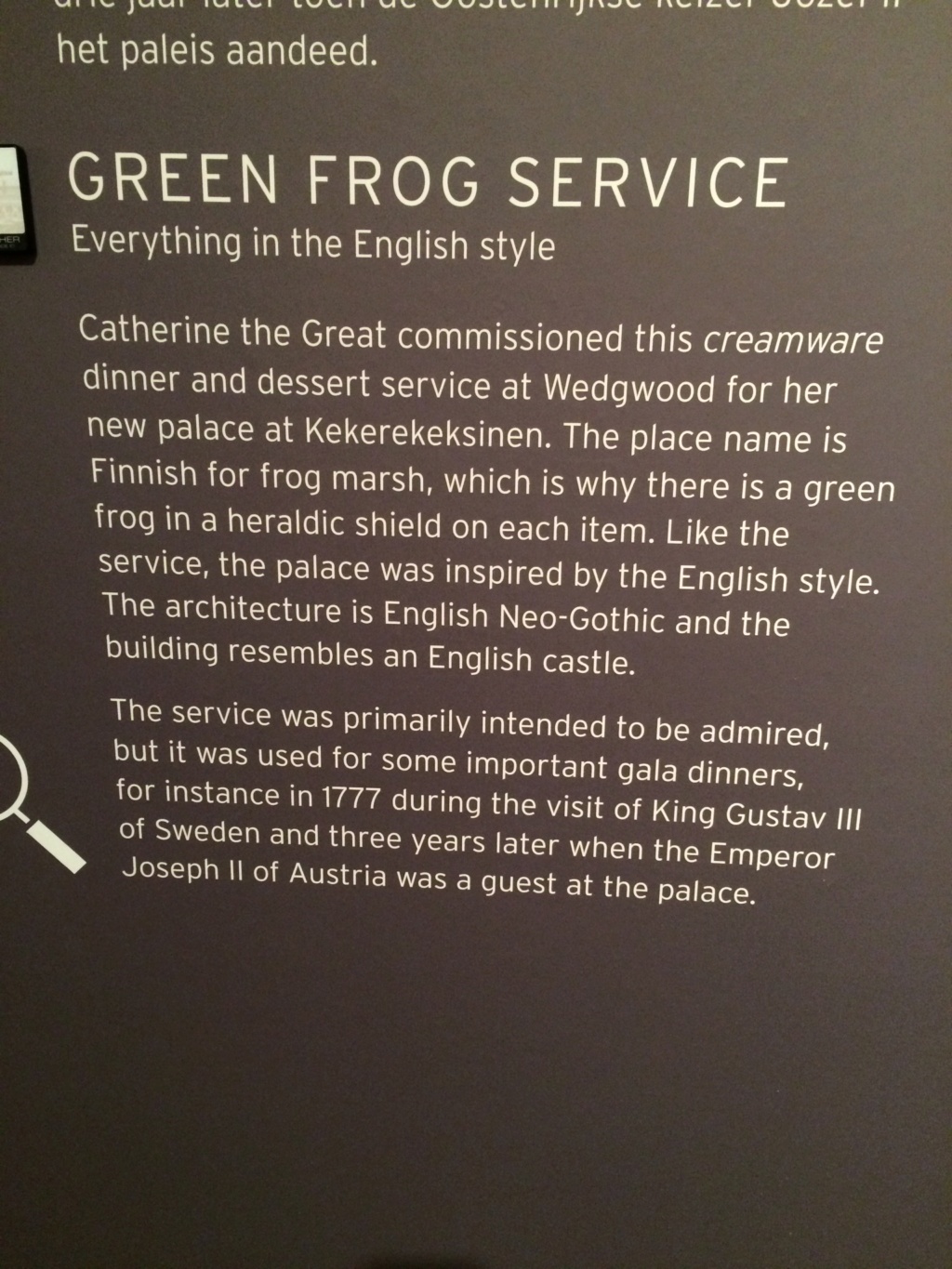
Gustave III en 1777 et Joseph II en 1780 ont donc mangé dans ce service


Gouverneur Morris- Messages : 11387
Date d'inscription : 21/12/2013
 Le vase Portland
Le vase Portland
Le vase antique original
Ce vase romain de la fin du Ier siècle av. J.-C, en pâte de verre bleu nuit rehaussée de scènes en camée de verre blanc est, depuis 1810, conservé au British Museum de Londres.

The Portland Vase
Amphora in translucent dark cobalt blue and opaque white cameo glass carved.
Rome (probably), c. 1-25
Imagery possibly related to the story of Peleus and Thetis.
Height: 24.5 centimetres ; Diameter: 17.7 centimetres (maximum) ; Diameter: 9.3 centimetres (mouth)
Image : The Trustees of the British Museum
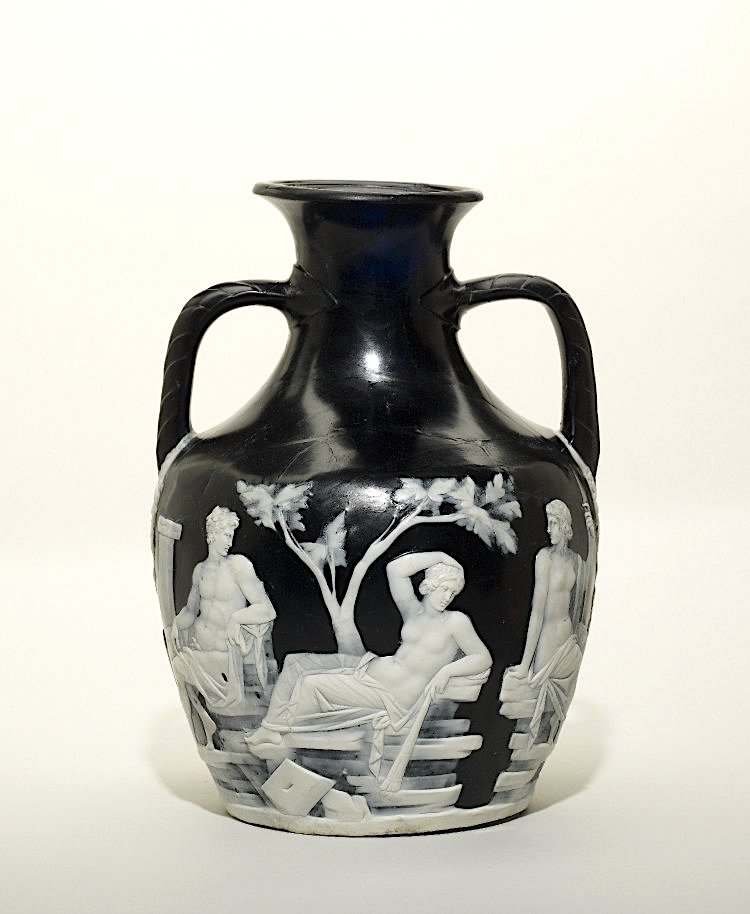
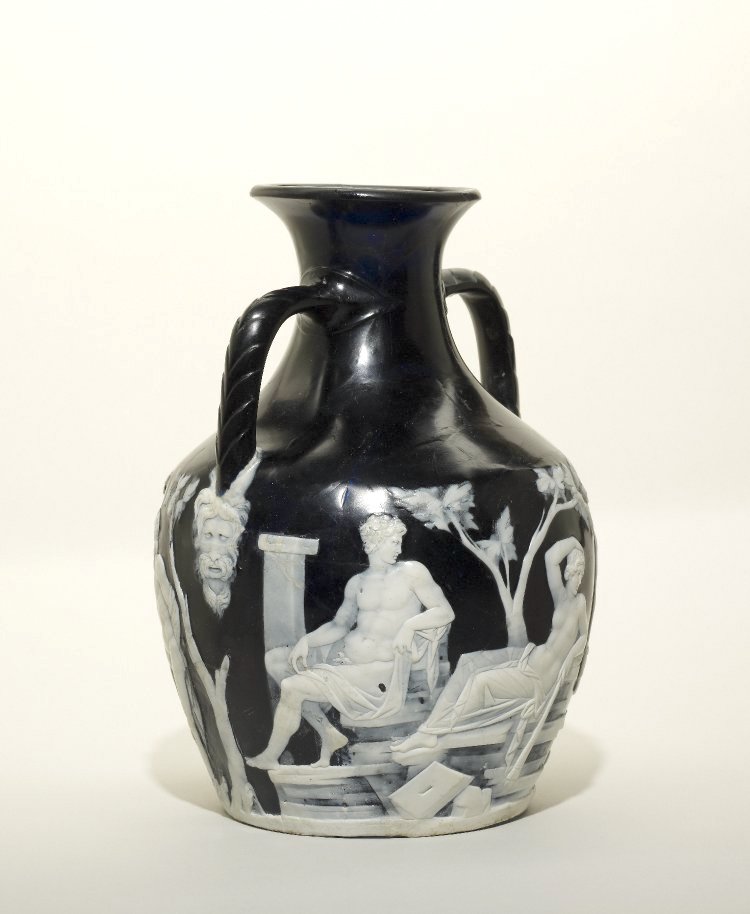


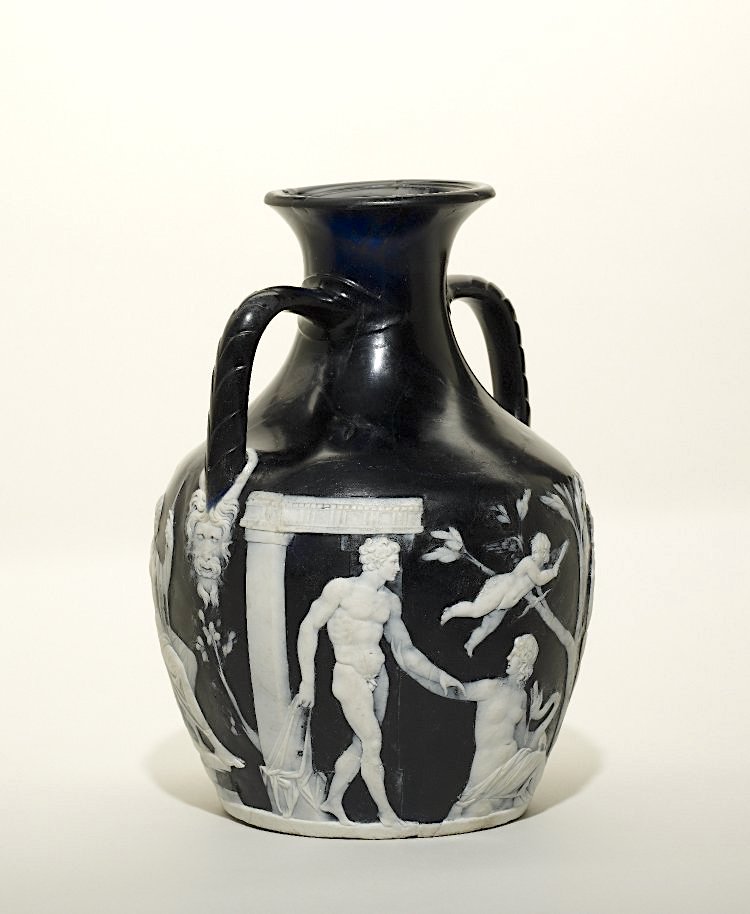
Image : The Trustees of the British Museum
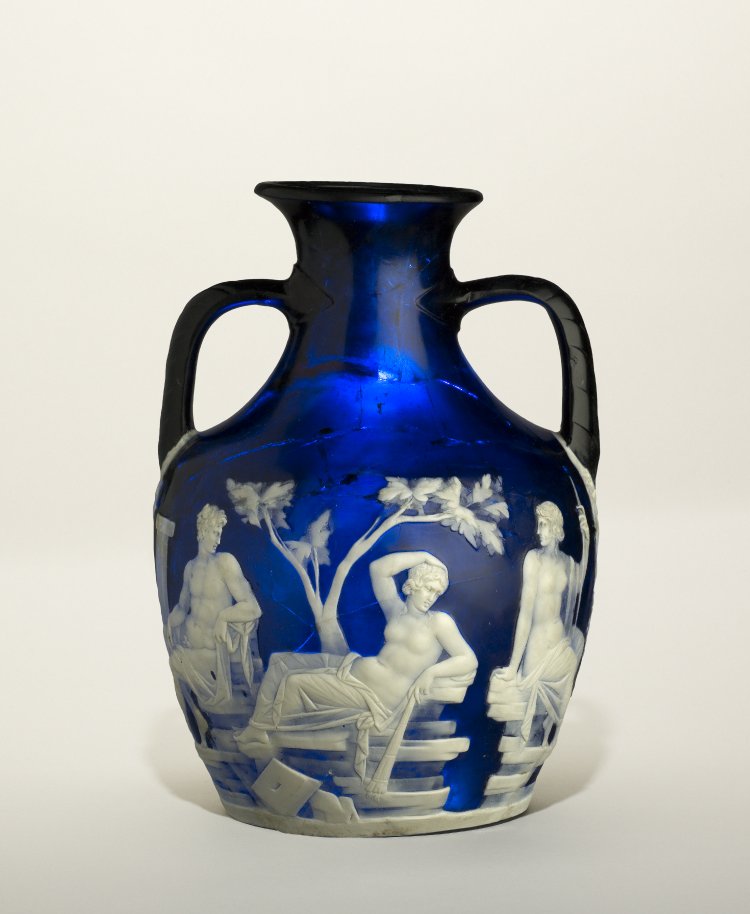
Image : The Trustees of the British Museum
Sur le fond du vase était apposé un disque, lui-même en camée de verre bleu et blanc représentant le visage de Pâris ou de Priam.
Ce disque, qui n'appartient visiblement pas au vase, est exposé à part depuis 1845.
Il a pu être ajouté dès l'Antiquité pour réparer un accident : la forme originale du vase a très bien pu être celle d'une amphore, comme celle d'un autre vase pompéien de même facture.
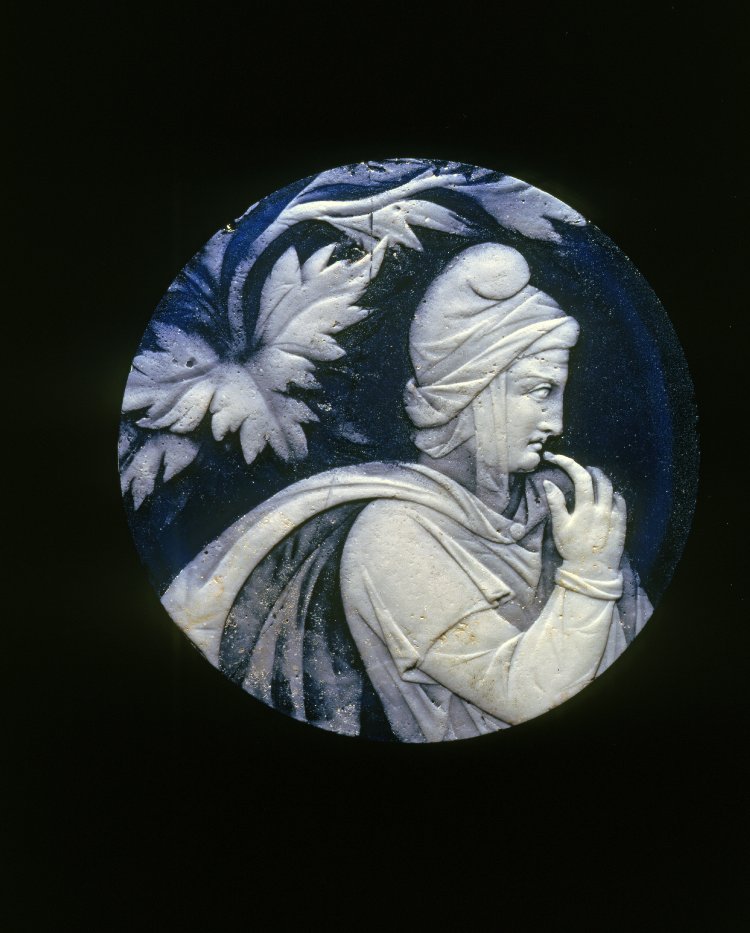
The Portland Vase Disc (Base)
A disc in translucent blue and opaque white cameo glass.
Rome (probably), circa 1-25
The disc does not belong, but was cut down from a larger piece.This was added as a new base to the truncated Portland Vase, perhaps even in antiquity.
The two pieces have been associated since at least the early 17th century.
However, they evidently do not belong together, since they differ in color, composition and style, and the disc was cut down from a larger composition.
Image : The Trustees of the British Museum
Origine et technique de fabrication
Le style des scènes et de l'œuvre elle-même incitent à dater le vase de -30/-203. Les vases-camées furent probablement tous réalisés en l'espace de deux générations, quelques décennies seulement après l'invention du soufflage du verre, vers -50.
De récentes recherches font état d'une méthode par immersion d'un vase de verre dans une autre masse de verre blanc en fusion. Après quoi on procédait à la gravure des figures par retrait progressif des parties blanches.
Des essais menés au XIXe siècle ont montré que l'exécution d'un vase de la dimension et de la qualité du vase Portland devait demander à un artisan au moins deux ans d'un travail d'une extrême minutie. Ce travail était probablement accompli par d'habiles tailleurs de pierres précieuses.
On pense que le graveur pourrait être Dioscoride (Dioskourides), au vu de pièces de joaillerie signées de son nom durant la même période.
Découverte
La légende lie le vase au tombeau de Monte del Grano, près de Rome. Celui-ci est fouillé en 1581 ou au début de 1582, par Fabrizio Lazzaro, son propriétaire, qui met au jour un sarcophage représentant Alexandre Sévère et sa mère.
Pietro Santi Bartoli, premier auteur à mentionner le contexte de la découverte, précise dans la légende d'une planche de Gli antichi sepolcri (Tombes anciennes) que le vase a été trouvé dans le sarcophage.
Quelques années auparavant, Girolamo Teti avait suggéré dans son Aedes Barberinae que le vase était l'urne funéraire de l'empereur romain.
La première référence connue au vase est une lettre de 1633 de l'intellectuel français Nicolas Claude Fabri de Peiresc au peintre Pierre Paul Rubens : Peiresc témoigne l'avoir vu dans les collections du cardinal Francesco Maria del Monte, lors de son voyage à Rome en 1600.
À la mort du cardinal, le vase est vendu au cardinal Francesco Barberini et demeure pour environ deux siècles dans les collections de la famille, qui comptaient aussi des sculptures comme le faune Barberini et l'Apollon Barberini.
Depuis 1778
Sir William Hamilton, ambassadeur à Naples, l’acheta en 1778 à James Byres, marchand d’art écossais, qui en avait fait l’acquisition auprès de Cornelia Barberini-Colonna, princesse de Palestrina, qui le tenait par héritage de la famille Barberini.
Hamilton l’emmena en Angleterre et le revendit en 1784 à Margaret Cavendish-Harley, veuve de William Bentinck, 2e duc de Portland.
Il passa en 1786 à son fils, William Cavendish-Bentinck, 3e duc de Portland.
Celui-ci le prêta à Josiah Wedgwood, qui en fit une copie, exposée au Victoria and Albert Museum, puis en confia la garde au British Museum, où il reçut son nom actuel de « Portland Vase ».
En 1810, le 4e duc de Portland le confia en dépôt au British Museum, après qu’un de ses amis en eut brisé le fond.

Il y est resté depuis ce temps, sauf durant une période de trois ans, en 1929-1932, quand William Cavendish-Bentinck, 6e duc de Portland, le mit en vente chez Christie's, où il ne réussit pas à atteindre son prix de réserve.
Finalement, le British Museum en fit l’acquisition auprès de William Cavendish-Bentinck, 7e duc de Portland, en 1945.
Vandalisme et reconstitutions
Le 7 février 1845, un vandale projeta sur le vase une sculpture qui se trouvait à proximité, brisant les deux pièces en de multiples fragments.
Le vase fut immédiatement reconstitué, mis à part 37 petits éclats dont on ne sut que faire dans l'immédiat et dont on finit par perdre la trace.
En 1948, ces éclats furent remis à un gardien par une personne qui les avait retrouvés sans les identifier.
Lors d'une nouvelle restauration, la même année, trois d'entre eux purent être remis en place.
Enfin, une troisième restauration a été entreprise en 1987, avec tous les progrès techniques de l'époque.
Ce fut l'occasion d'une étude poussée et d'un relevé photographique exhaustif des différents fragments du vase. Une exposition de portée internationale eut lieu et la BBC produisit des émissions documentaires sur le vase, son démontage et sa nouvelle reconstitution.
On considère que le vase se trouve maintenant en état d'être exposé dans les meilleures conditions pour de très longues années.
Les pièces sont liées entre elles par une résine epoxy convenablement colorée et les traces de l'accident sont peu visibles, sans pour autant être totalement effacées ou dissimulées aux regards des visiteurs.
* Source texte (extraits) : Wikipedia - Vase Portland
The Portland Vase is the most famous of all objects to have passed through Sir William Hamilton's hands.
It was already well known when he acquired it from the Scottish dealer James Byres between 1780 and 1783, and it was discussed by d'Hancarville in the second volume of AEGR (p. 74), which appeared in 1770.
In the eighteenth century it was accepted that the Portland Vase had been discovered in a funerary monument known as the Monte del Grano, a few miles southeast of the old city wall of Rome.
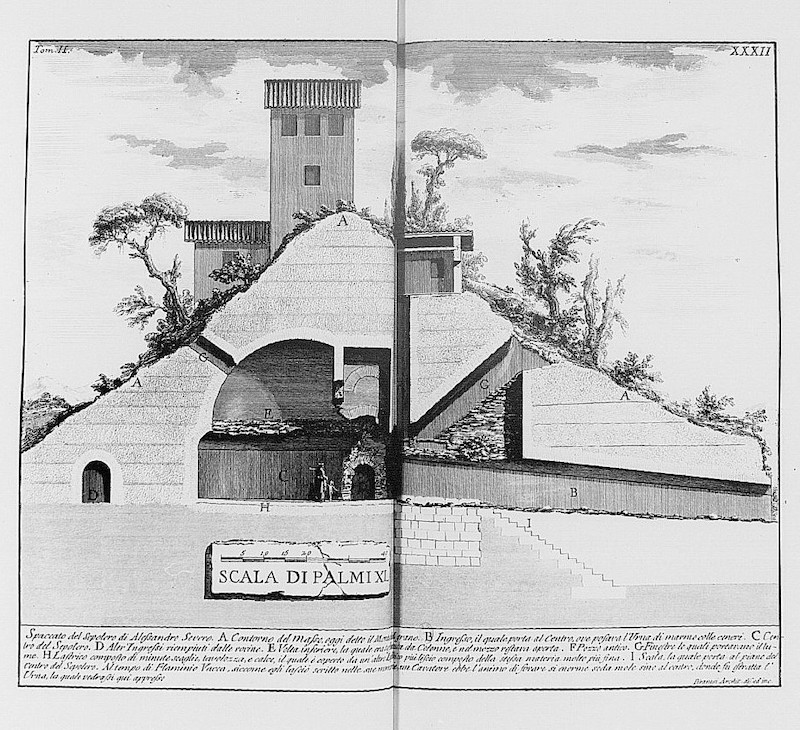
Coupe du mausolée d'Alexandre Sévère
Giovanni Battista Piranèse (1720-1778); dess. et grav. ; aut. du texte.
Illustration de Antichita Romanae. 1756
Volume II. Le Antichita Romane. Pl.XXXII double
Image : Bibliothèque Nationale de France
The Vase was said to have been found in a large marble sarcophagus, thought to have been that of the third-century Roman emperor Alexander Severus and his mother, Julia Mammaea. That the Vase came from the funerary monument has recently been upheld in a thorough review of the evidence as 'probable, but not certain'. What is doubtful is that it contained the ashes of the emperor himself; nor is it likely that the sarcophagus is that of Alexander Severus.
The first recorded mention of the Portland Vase is by the French antiquary Nicolas-Claude Fabri de Peiresc, who saw it in Rome during the winter of 1600-1, when it was in the collection of Cardinal del Monte.
The seventeenth-century 'Republic of Letters', including Peiresc, the Flemish painter Peter Paul Rubens and the Italian antiquary Cassiano dal Pozzo, exchanged correspondence about the Vase and drawings and casts of it. They were fascinated by every aspect, from its beauty, the technique of its manufacture and the interpretation of its iconography down to its capacity.
Cassiano dal Pozzo (1588-1657), whose so-called 'Paper Museum' contained more than one drawing of the Vase, was secretary to Cardinal Francesco Barberini.
In 1626, following the death of Cardinal Del Monte, the Vase passed into the hands of Francesco's brother, Antonio. These two were nephews of the Barberini Pope, who was elected as Urban VIII in 1623.

Portrait of Cardinal Francesco Barberini
By Ottavio Leoni (1578-1630)
Oil on canvas
Image : Mutualart
Now the property of the most powerful family in Rome, and placed at the heart of the city's most important artistic circle, the Barberini Vase, as it was known before it entered the Portland collection, became even more famous.
By the end of the seventeenth century it was one of the most important 'sights' of Rome, its fame increasing with the rise in the number of printed books on antiquarian subjects.
In 1697 it was discussed and copiously illustrated in Gli antichi sepolchri, P. S. Bartoli's book on ancient tombs and mausolea in Rome, which repeated the claim that it had been found inside the sarcophagus in the Monte del Grano. It was published again by Bernard de Montfaucon in his substantial and influential encyclopaedia, L'Antiquite expliquée, the author repeating an erroneous claim, already made by M. A. de la Chausse in his Romanum Museum of 1690, that the Vase was made of agate.
G. B. Piranesi engraved the tomb, sarcophagus and Vase for his Antichita Romane (1756, pls 31-5).
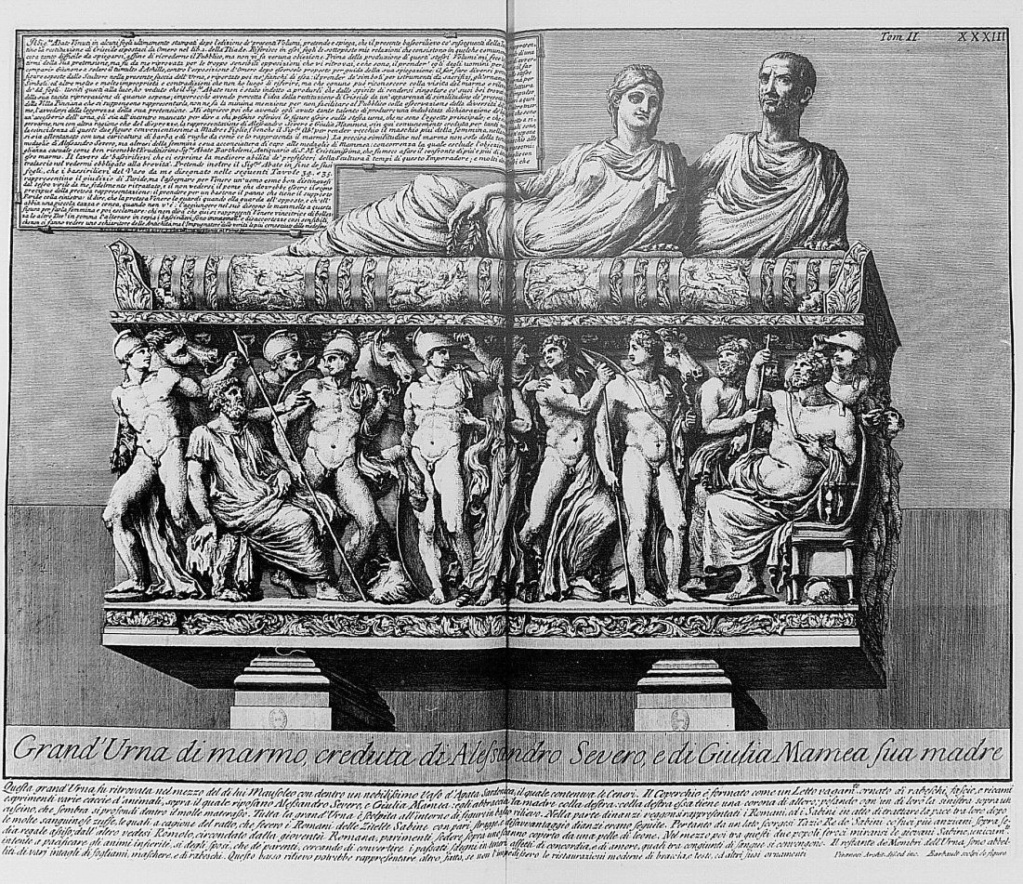
Décor du sarcophage d'Alexandre Sévère
Giovanni Battista Piranèse (1720-1778); dess. et grav. ; aut. du texte.
Illustration de Antichita Romanae. 1756
Volume II. Le Antichita Romane. Pl.XXXIII double
Image : Bibliothèque Nationale de France
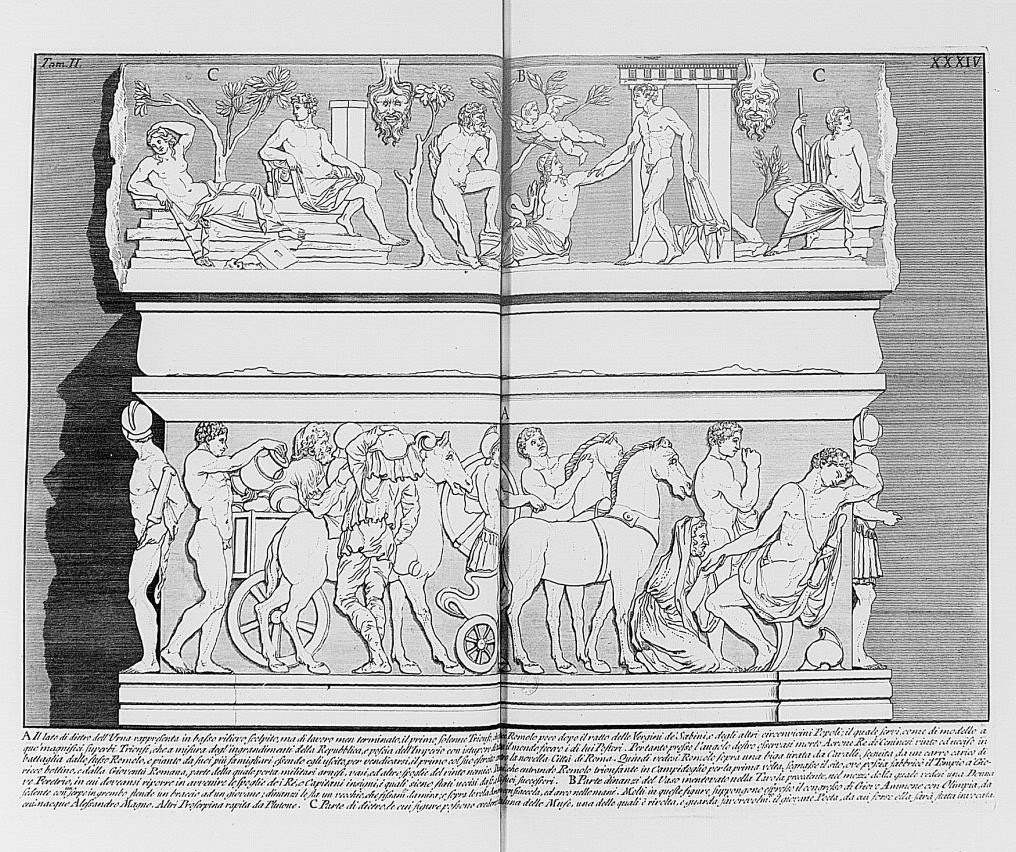
Scènes et décor du sarcophage d'Alexandre Sévère
Giovanni Battista Piranèse (1720-1778); dess. et grav. ; aut. du texte.
Illustration de Antichita Romanae. 1756
Volume II. Le Antichita Romane. Pl.XXXIV double
Image : Bibliothèque Nationale de France
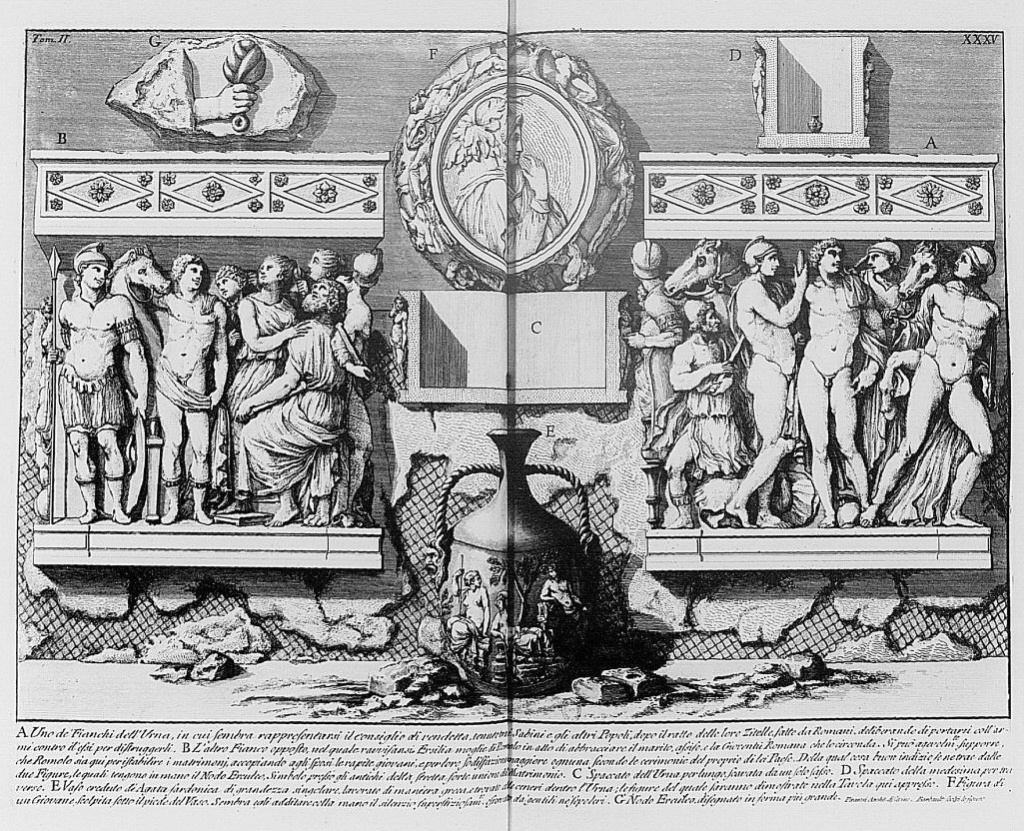
Scènes et décor du sarcophage d'Alexandre Sévère
Giovanni Battista Piranèse (1720-1778); dess. et grav. ; aut. du texte.
Illustration de Antichita Romanae. 1756
Volume II. Le Antichita Romane. Pl.XXXV double
Image : Bibliothèque Nationale de France
The Vase was in the possession of the Barberini family for more than 150 years, but their fortune was declining and around 1780 Donna Cordelia Barberini-Colonna, having had a bad run at cards
 , was forced to sell off the family heirlooms.
, was forced to sell off the family heirlooms. In a letter dated 24 July 1786, Hamilton described how he reacted when he first saw the Vase with James Byres:
'The person I bought it of at Rome will do me the justice to say, that the superior excellence of this exquisite masterpiece struck me so much at first sight, that I eagerly asked : Is it yours ? Will you sell it ?
He answered, Yes, but never under £1000.'

Sir William and the first Lady Hamilton in their villa in Naples
By David Allen
Oil on copper, 1770
Image : Compton Verney
Sir William Hamilton, British Envoy in Naples from 1764, and his wife, Catherine Barlow, are seen here in the room off the terrace in their summer villa in Posillipo, surrounded by many of Sir William’s favourite items: his violin, a classical bust of Zeus and a small-scale copy of his favourite painting, Correggio’s Venus Disarming Cupid.
The view of Vesuvius is a reference to Sir William’s passion for vulcanology and he frequently accompanied tourists to view the eruptions.
He greatly admired Scottish artist Allan, whom he met in Naples, describing him as one of the greatest geniuses he had ever known.
Hamilton offered Byres that sum, but only in the form of a bond on which there was 5 per cent interest. Hamilton could not resist the purchase, even though he could hardly afford it.
The precise date at which he actually came into possession of the Vase has not previously been known, but an unpublished letter of James Byres to Charles Townley, dated 13 October 1782, informs us that Byres visited Hamilton in Naples in the summer of that year. It seems likely that he took the Vase with him, unable to entrust the transport of so valuable a cargo to another pair of hands.
Hamilton probably never intended to keep the Vase for long and, when he returned to England on leave in August 1783, it was included with a number of things he took with him to sell.
Among these were other antiquities and the painting Hamilton himself attributed to Correggio (See Jenkins & Sloan 1996, 176).
With the assistance as go-between of his niece Mary Hamilton, he attempted to interest the Duchess of Portland in a block purchase of the painting and the antiquities.
Horace Walpole described the duchess as 'a simple woman, but perfectly sober, and intoxicated only by empty vases'.

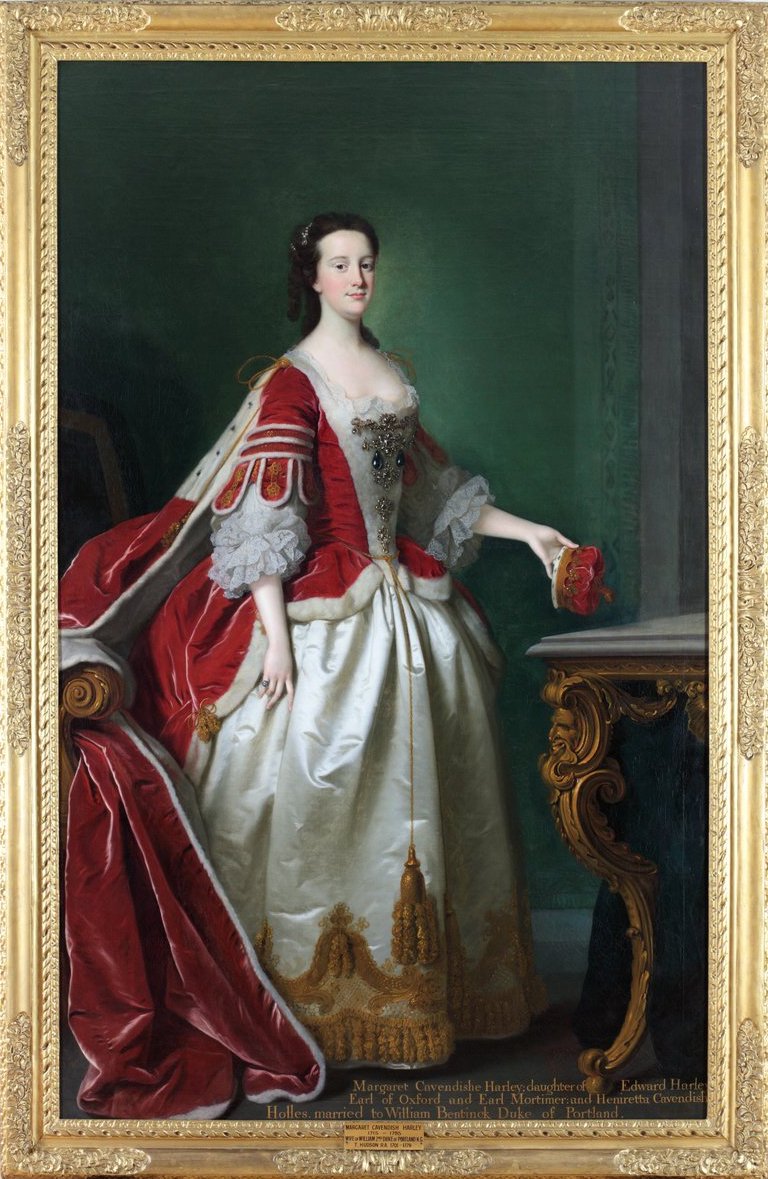
Lady Margaret Cavendish-Holles-Harley, Duchess of Portland(1715-1785)
By Thomas Hudson
Oil on canvas, 1744
Image : Twitter
The duchess, who already had a substantial collection of antiquities and specimens of natural history, was not tempted by the painting, but she and Hamilton were able to settle, in secrecy at her request, on the Vase, together with a select group of antiquities.
The purchase negotiations were completed by the end of January 1784, but some months elapsed before the Vase entered the duchess's museum at her house in the Privy-Gardens, Whitehall.
In March, without disclosing its true ownership, Hamilton showed the Vase to the Society of Antiquaries, of which he was a Fellow. He had already arranged for G. B. Cipriani to 'borrow' the Vase in order to make drawings from it. It was not returned until 13 July, when Cipriani handed it over to Mary Hamilton.
The duchess had only a year in which to enjoy her purchase, for she died in July 1785, and the Portland Museum, as it became known, was sold.
The sale ran for six weeks

Auction sale of the private collection assembled by Margaret Cavendish Bentinck, Duchess of Portland
Catalogue frontispiece showing view of contents of the Portland Museum, including the Portland Vase, 8 April 1786.
Image : Historytoday
Not surprisingly, previous discussions of the Portland sale have focused on the Vase, with little mention of the small group of objects also bought by the duchess from Hamilton.
These appear in the catalogue immediately before the Vase and comprise the following: a mosaic ring, described in the sale catalogue as :
'A small chimera of fine antique mosaic, set in gold as a ring, and turns upon a swivel. The figure has the wings and feet of a bird, with a human face and seems to be an Hieroglyphic' ; a cornelian intaglio of Hercules, who is described as sitting in a boat and using the lion skin as a sail, set in gold for a ring. This was followed by a sardonyx cameo of the head of Augustus, said to come from Malta, and a head of Sarapis, described in the sale catalogue as green basalt, as coming from the Barberini cabinet, and about four inches high.
The purchaser of the Vase and the cameo was the 3rd Duke of Portland, while Horace Walpole bought the Sarapis.
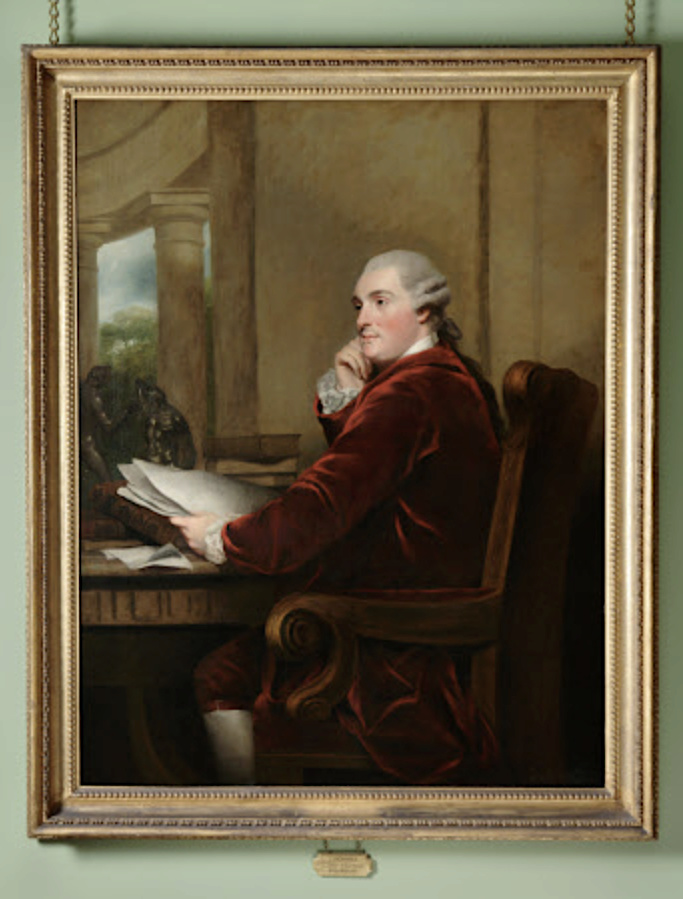
William Henry Cavendish-Bentinck, 3rd Duke of Portland (1738-1809)
John Powell after Joshua Reynolds
Oil on canvas, 1782
Collection Dunham Massey, Cheshire (Accredited Museum)
Image : National Trust Collection
(...)
Hardly was the Portland sale over than Josiah Wedgwood was applying to borrow the Vase with a view to copying it in jasper-ware.
On 10 June 1786, he signed a receipt for both the Vase and the cameo of Augustus. Wedgwood's copies of the Vase, first in black and later in the lighter blue version, spread its fame still further.
In 1810 the 4th Duke of Portland deposited it in the British Museum for safe-keeping, where it went on public display.
Alas, thirty-five years later, at 3.45 p.m. on 7 February 1845, a young man named William Lloyd, suffering from acute paranoia brought on a by a week-long bout of drinking, picked up a sculpted stone in the room where the Vase was displayed and smashed both it and the showcase into fragments.

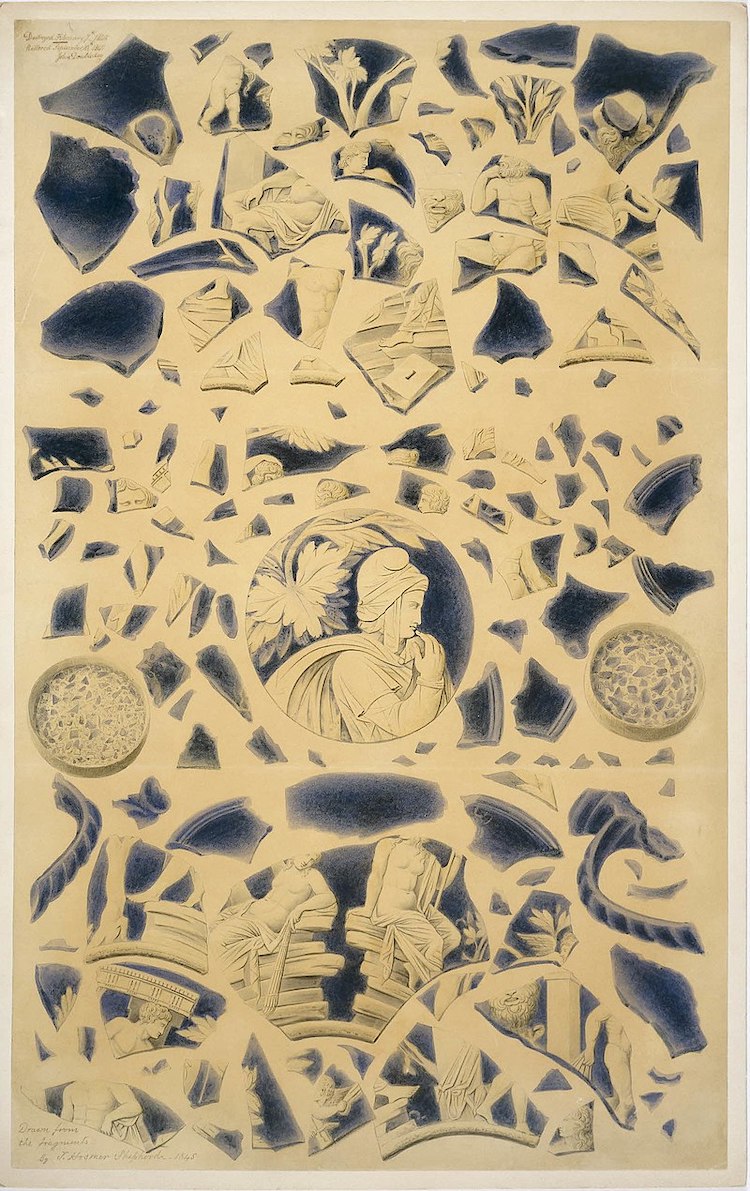
Fragments of the Portland Vase
Watercolour by Thomas H. Shepherd
March 1st 1845
Image : British Museum - Commons Wikimedia
In spite of the damage, the event and the ensuing trial of the culprit served only to increase the celebrity of the Vase, which was restored soon afterwards by John Doubleday.
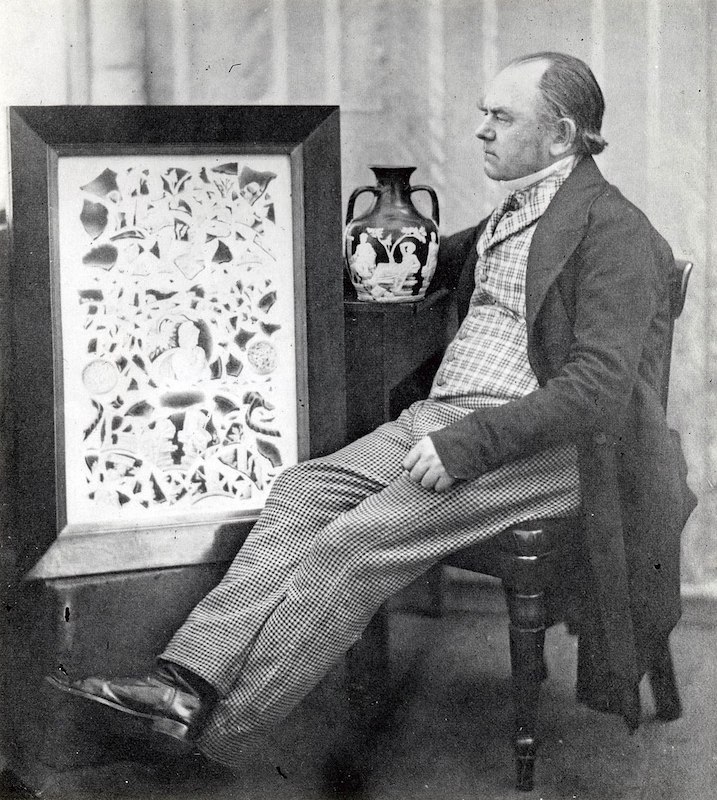
Black & white photograph of John Doubleday with the Portland Vase
British Museum - Commons Wikimedia
A hundred years after its destruction, the Portland Vase was bought for the British Museum, since when it has twice been dismantled and restored, the second restoration being by the late Nigel Williams in 1989.
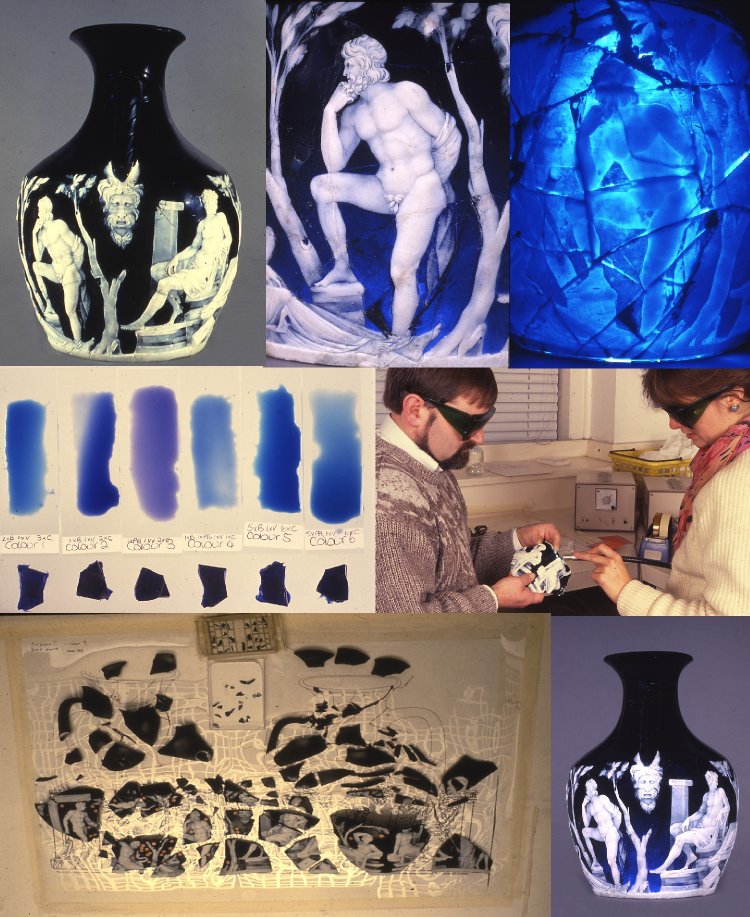
Image : 2019 Trustees of the British Museum
* Source texte (extraits) : British Museum - Portland Vase
A suivre, les répliques Wedgwood...


La nuit, la neige- Messages : 17807
Date d'inscription : 21/12/2013
 Re: La manufacture Wedgwood et sa production du XVIIIe siècle
Re: La manufacture Wedgwood et sa production du XVIIIe siècle
La nuit, la neige a écrit:Le 7 février 1845, un vandale projeta sur le vase une sculpture qui se trouvait à proximité, brisant les deux pièces en de multiples fragments.
Le vase fut immédiatement reconstitué, mis à part 37 petits éclats dont on ne sut que faire dans l'immédiat et dont on finit par perdre la trace.
En 1948, ces éclats furent remis à un gardien par une personne qui les avait retrouvés sans les identifier.
Lors d'une nouvelle restauration, la même année, trois d'entre eux purent être remis en place.
... s'amuser à faire voler en éclats un vase inestimable !
 Il faut vraiment être complètement taré .
Il faut vraiment être complètement taré .Le vase fut immédiatement reconstitué !

C'est inimaginable une histoire pareille.
Le vandale fut donc pris sur le fait ? Quelle fut sa condamnation ?
_________________
... demain est un autre jour .

Mme de Sabran- Messages : 54725
Date d'inscription : 21/12/2013
Localisation : l'Ouest sauvage
 Re: La manufacture Wedgwood et sa production du XVIIIe siècle
Re: La manufacture Wedgwood et sa production du XVIIIe siècle
Mme de Sabran a écrit:
... s'amuser à faire voler en éclats un vase inestimable ! Il faut vraiment être complètement taré .
Le vandale fut donc pris sur le fait ? Quelle fut sa condamnation ?
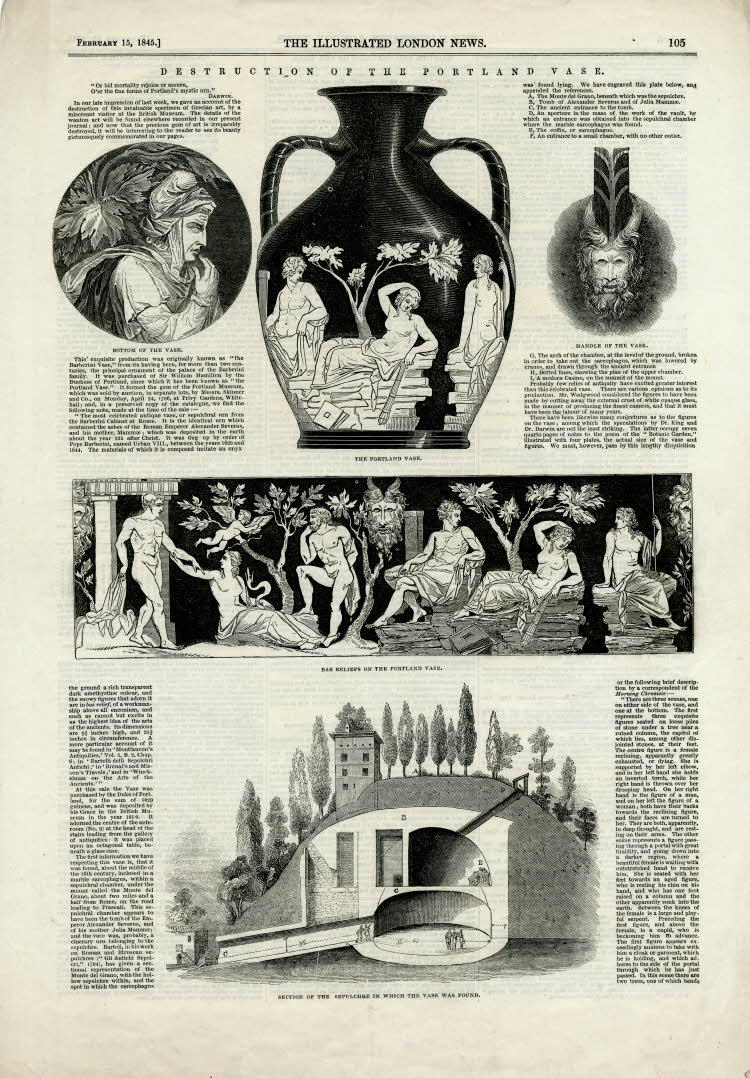
Destruction of the Portland Vase - Page from the 'Illustrated London News'
15 February 1845
Image : The Trustees of the British Museum
Le vandale, un certain William Lloyd (un pseudonyme, de son vrai nom William Mulcahy), sans doute à l'esprit dérangé, été prétendument ivre lors de son pétage de plombs (il a déclaré avoir bu de l'alcool durant une semaine). Il fut immédiatement arrêté.
Lors de son procès, son avocat a habilement mis en avant une erreur dans le libellé de l'acte d'accusation, qui semblait limiter son application à la destruction d'objets ne dépassant pas cinq livres sterling.

Grâce à cette erreur de procédure, le prévenu ne fut pas condamné pour la destruction du vase, mais pour celle de la vitrine en verre dans laquelle la précieuse antiquité était exposée !!!

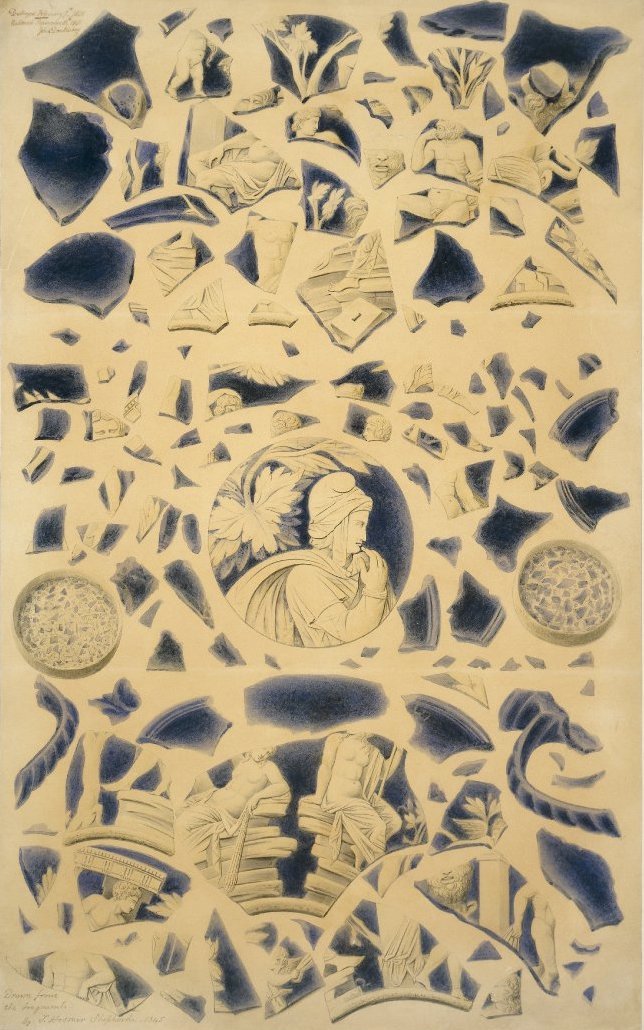
Drawing of the Fragments of the Portland Vase
Pen and ink and watercolour
by Thomas Hosmer Shepherd
Drawing, 1845
This drawing was commissioned by the British Museum's restorer John Doubleday who restored the Portland Vase after it was smashed in 1845.
Image : The Trustees of the British Museum
Il fut donc condamné à "seulement" payer une amende de trois livres sterling (de l'époque), ou à passer deux mois en prison. Ce qu'il choisit, étant sans fortune.
Il restera en prison quelques jours seulement, jusqu'à qu'un donateur anonyme paye l'amende à sa place.
A noter que William Bentinck, 4eme duc de Portland, héritier et propriétaire du vase (à cette date encore, le vase était seulement prêté au British Museum), n'a pas souhaité lancer une procédure en justice, estimant que la famille du jeune homme n'avait pas à payer les conséquences d'un acte de folie.

J'ignore si le British Museum et sa compagnie d'assurance ont cependant "dédommagé" le duc de Portland ? Et je rappelle que le vase fut finalement acheté par le musée un siècle plus tard, en 1945.

La nuit, la neige- Messages : 17807
Date d'inscription : 21/12/2013
 Re: La manufacture Wedgwood et sa production du XVIIIe siècle
Re: La manufacture Wedgwood et sa production du XVIIIe siècle
Non mais franchement, c'est dingue ! On croit rêver !!!
Alors comme ça, sous prétexte de " pétage des plombs " , tu peux tout te permettre ?!
J'en reste comme deux ronds de flan ...
Alors comme ça, sous prétexte de " pétage des plombs " , tu peux tout te permettre ?!

J'en reste comme deux ronds de flan ...
_________________
... demain est un autre jour .

Mme de Sabran- Messages : 54725
Date d'inscription : 21/12/2013
Localisation : l'Ouest sauvage
 Re: La manufacture Wedgwood et sa production du XVIIIe siècle
Re: La manufacture Wedgwood et sa production du XVIIIe siècle
3£ de 1845 = 355£ actuelles. Effectivement même aujourd'hui cela représenterait beaucoup ! Deux mois de prison ou 6£ de jour-amende pour 60 jours, il faut choisir...

Gouverneur Morris- Messages : 11387
Date d'inscription : 21/12/2013
 Re: La manufacture Wedgwood et sa production du XVIIIe siècle
Re: La manufacture Wedgwood et sa production du XVIIIe siècle
Ce n'est pas ce que j'ai dit, bien sûr que non, mais enfin je n'ai pas d'explication.Mme de Sabran a écrit:Non mais franchement, c'est dingue ! On croit rêver !!!
Alors comme ça, sous prétexte de " pétage des plombs " , tu peux tout te permettre ?!
Il a bénéficié d'un vice de procédure lors de son procès, que veux-tu que je te dise ?
Ceci dit, il ne fallait pas non plus le brûler vif en place publique ou l'enfermer à vie pour...un vase.

Le voleur de la Joconde fut condamné à une peine de prison d'un an, réduite à sept mois. Bon.
Rappelons qu'avant de commettre ce délit, Vincenzo Peruggia était employé par l'entreprise qui fabriquait alors, sur mesure, les protections en verre des oeuvres du Louvre que l'on souhaitait protéger d'éventuels actes de vandalisme.
Comme quoi...

Le crime est partout, ma bonne amie !!


La nuit, la neige- Messages : 17807
Date d'inscription : 21/12/2013
 Re: La manufacture Wedgwood et sa production du XVIIIe siècle
Re: La manufacture Wedgwood et sa production du XVIIIe siècle
...

Eh bien, tout de même, cela me laisse pantoise !
_________________
... demain est un autre jour .

Mme de Sabran- Messages : 54725
Date d'inscription : 21/12/2013
Localisation : l'Ouest sauvage
 Le vase Portland par Wedgwood
Le vase Portland par Wedgwood
Revenons donc au XVIIIe siècle, avec les répliques de la manufacture Wedgwood... 
En 1786, l'annonce de la vente aux enchères du "museum" de la duchesse de Portland était un évènement. Le fameux vase antique faisait partie des lots parmi ceux les plus convoités.
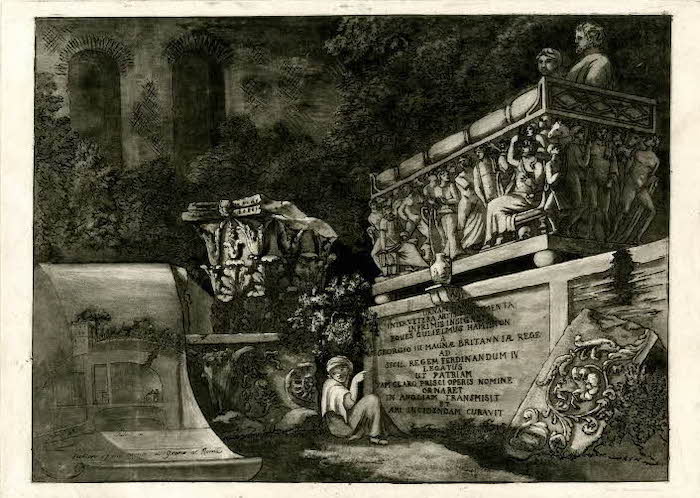
Title plate to the set of prints of the Portland Vase
A seated figure pointing towards an inscription along a wall, above which is the Portland vase on a socle below a Roman sarcophagus; to the left a bucranium and a Corinthian capital, and an unfurled scroll showing the interior of the tomb in which the vase was discovered.
Print made by : Charles Francis Greville
London, Etching and aquatint, c. 1786
Image : Trustees of the British Museum
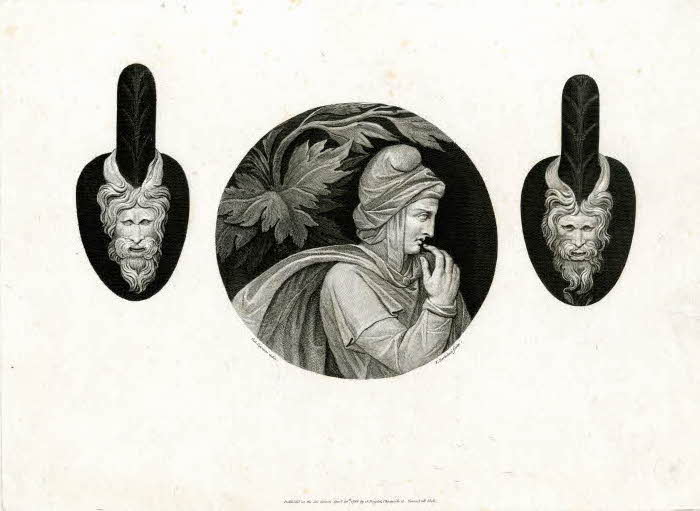
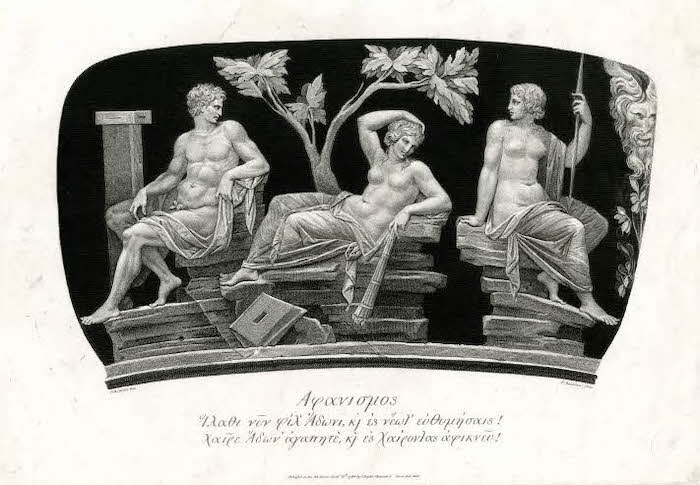
Details of the Portland Vase
Etching on paper, 1786
Print made by Francesco Bartolozzi after Giovanni Battista Cipriani
Image : Trustees of the British Museum
Josiah Wedgwood aurait souhaité se porter acquéreur du vase, mais il resta finalement entre les mains du duc de Portland qui accepta de prêter le vase à Wedgwood afin qu'il en fasse des copies en céramique.
Josiah Wedgwood, aidé de son fils, d'Henry Webber et de William Hackwood travaillèrent durant plus de trois ans afin de parfaire cette reproduction.
Après de nombreux échecs, la première copie jugée satisfaisante fut produite en octobre 1789.
Dès 1790, Josiah Wedgwood organisa la promotion et la vente de la très recherchée aujourd'hui "première édition du vase Portland".
La campagne de marketing de Wedgwood comprenait une exposition publique à Londres, une exposition privée animée par Sir Joseph Banks et une tournée promotionnelle dans les principales capitales d'Europe.

Admission ticket
Ticket inscribed Admission to see Mr. Wedgwood's Copy of THE PORTLAND VASE, Greek Street, Soho / between 12 o' Clock and 5. 2 pieces.
Image : Sotheby's

Portland Vase Black Jasper with White Reliefs
1790
Image : World of Wedgwood, museum highlights
Il est dit que le projet initial était de commercialiser une quarantaine d'exemplaires de cette première édition (les chiffres varient selon les sources).
Les copies du vase, dites de la première édition, furent produites jusqu'en 1796, mais leur nombre exact n'est pas certain, même si quelqu'uns d'entre-eux sont numérotés à l'intérieur du vase (tous ne le seraient pas, cependant ).
).
 Voir notamment cette intéressante vidéo de présentation d'un antiquaire qui proposait à la vente un de ces rares vases "première édition", numérotés
Voir notamment cette intéressante vidéo de présentation d'un antiquaire qui proposait à la vente un de ces rares vases "première édition", numérotés
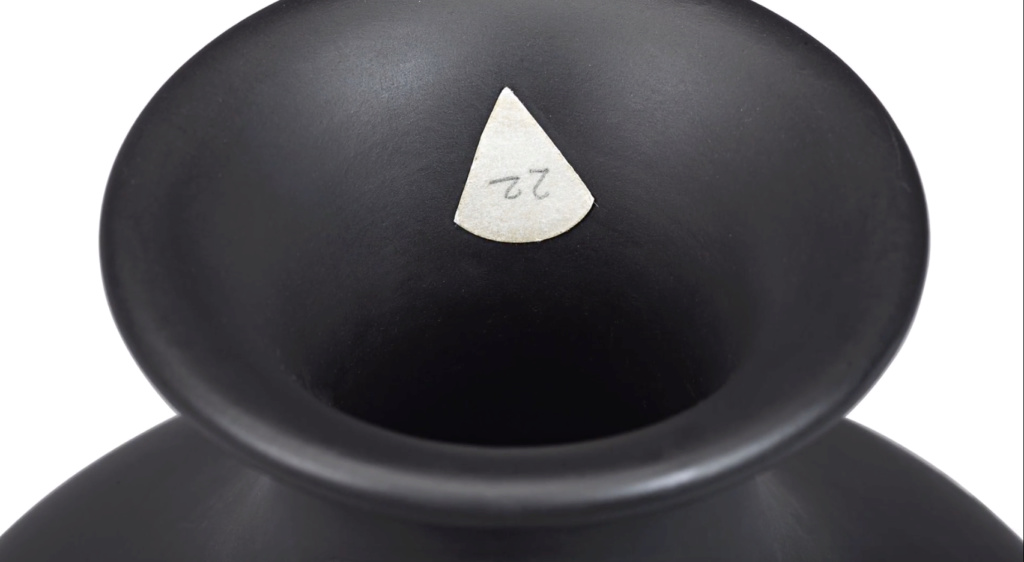
Image : MS Rau Antiques
 Ci-après quelques exemples de vases, "première édition", conservés dans divers musées.
Ci-après quelques exemples de vases, "première édition", conservés dans divers musées.
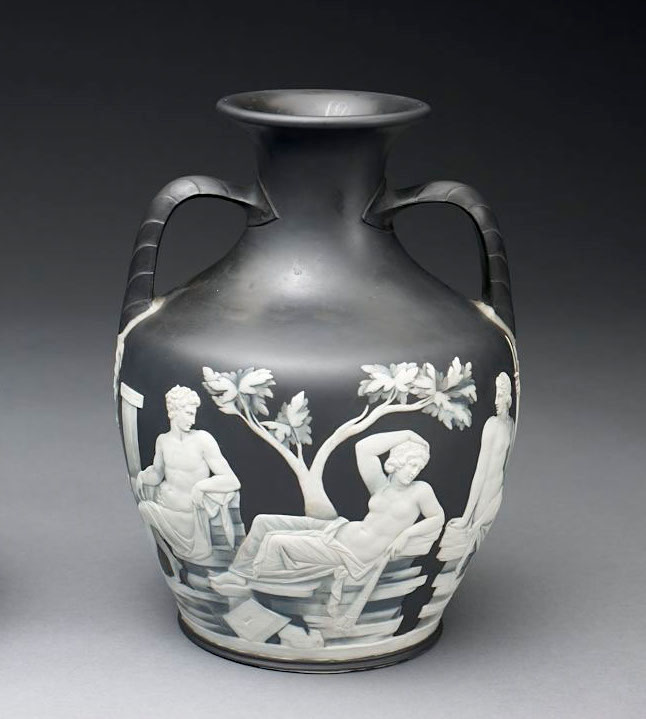
Portland vase copy
Wedgwood, England, est. 1759
Stoneware, about 1790
Handwritten on interior rim in graphite: 12
Provenance : Josiah Wedgwood; Josiah Wedgwood II; by descent to Emma Darwin (nee Wedgwood); by descent to Sir Robin Darwin (then on loan to the Victoria & Albert Museum, London); purchased 1965 by Dwight and Lucille Beeson; Birmingham Museum of Art
Image : ArtsBMA
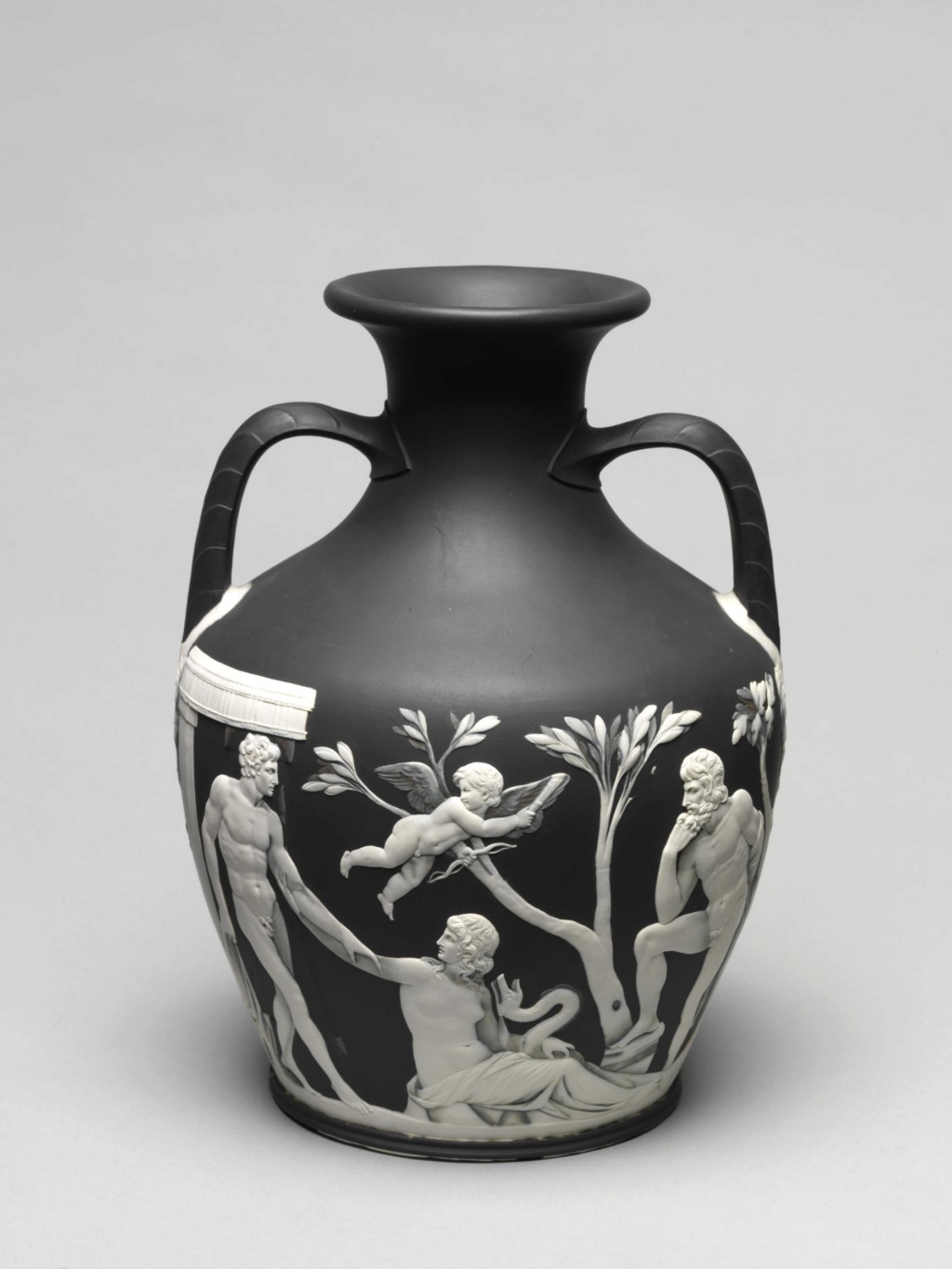
'First Edition' copy of the Portland Vase
Jasper with black 'dip' and white reliefs
Staffordshire (made), Wedgwood, ca 1790
Hackwood, William (modeller)
Webber, Henry (modeller)
Staffordshire, Josiah Wedgwood's factory, c. 1790
Image : Victoria and Albert Museum
He first attempted to reproduce it in 1786, and he spent over three years matching the subtlety of the lapidary-worked reliefs of the original.
His copies were made in Jasper, the stoneware body he developed following thousands of experiments in the 1770s and which is still in production today. This can be stained a range of colours to provide a background for applied moulded reliefs.
Having obtained the approval of leading connoisseurs and taste-makers, such as the artist Sir Joshua Reynolds, Wedgwood exhibited his perfected ‘First Edition’ copy in London in 1790, showing it to a select audience who had applied for admission tickets in advance.




Images : Victoria and Albert Museum
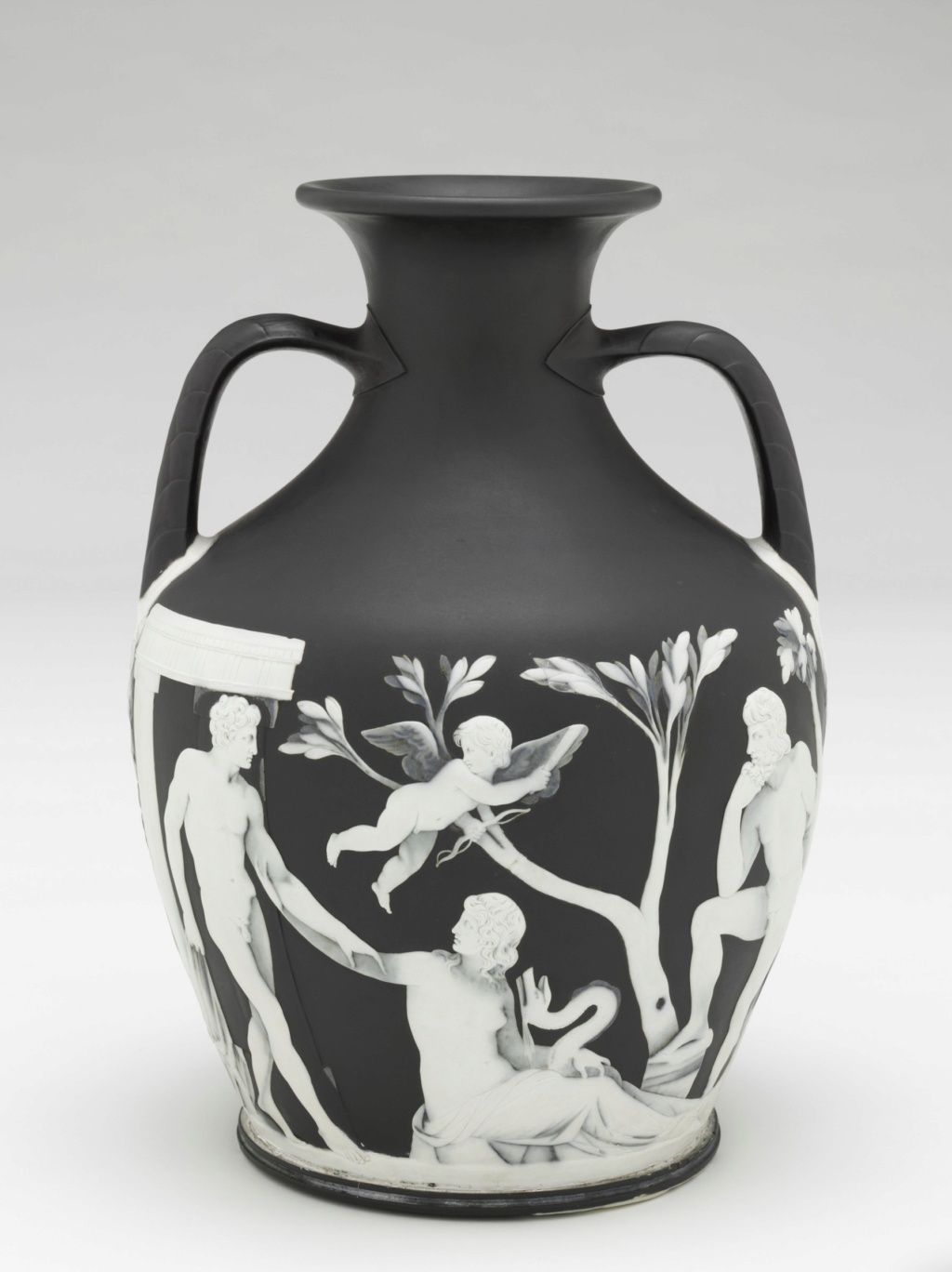
Copy of the Portland Vase, first edition
Inscription: inner lip, manganese pencil, handwritten: 9
Josiah Wedgwood & Sons
Jasperware, c. 1795
Dimensions : 25.8 x 18.5 cm diam
Gallery text :
In 1786, the Duke of Portland lent the original Greco-Roman Portland Vase to Josiah Wedgwood, who promptly set his artists to copying it and manufacturing meticulous replicas.
Early versions of the vase cracked in the firing process or failed to achieve the desired appearance. Wedgwood’s artisans struggled for four years to perfect their material and techniques, developing a blue-black clay to evoke the dark opaque glass of the original.
Ultimately a limited edition — of which this is number nine — was sold, mostly through special viewings at the Wedgwood showroom.
The name of John Trevor, who acquired this example from the manufacturer in 1797, is written inside the lip of the vase. One of Wedgwood’s most celebrated works, this was the first example from the subscription edition to enter an American collection.
 Le vase proposé aux enchères chez Sotheby's, le 23 octobre prochain, a la particularité d'être composé d'une couverte de jaspe à 4 couleurs.
Le vase proposé aux enchères chez Sotheby's, le 23 octobre prochain, a la particularité d'être composé d'une couverte de jaspe à 4 couleurs.
Daté fin XVIIIe siècle, les experts de la vente reviennent sur les incertitudes quant au nombre de pièces produites pour la "première édition" :

A WEDGWOOD BLACK AND WHITE JASPERWARE 'PORTLAND VASE'
LATE 18TH CENTURY
after the antique, of amphora form, with two molded scaled handles affixed at the shoulder with a flaring trumpet neck, applied in white relief with a continuous scene around the body with six classical figures and a cupid and on the underside with a roundel of Pan, embellished in tones of green-blue and brown.
Height 10¼ in. - 26 cm
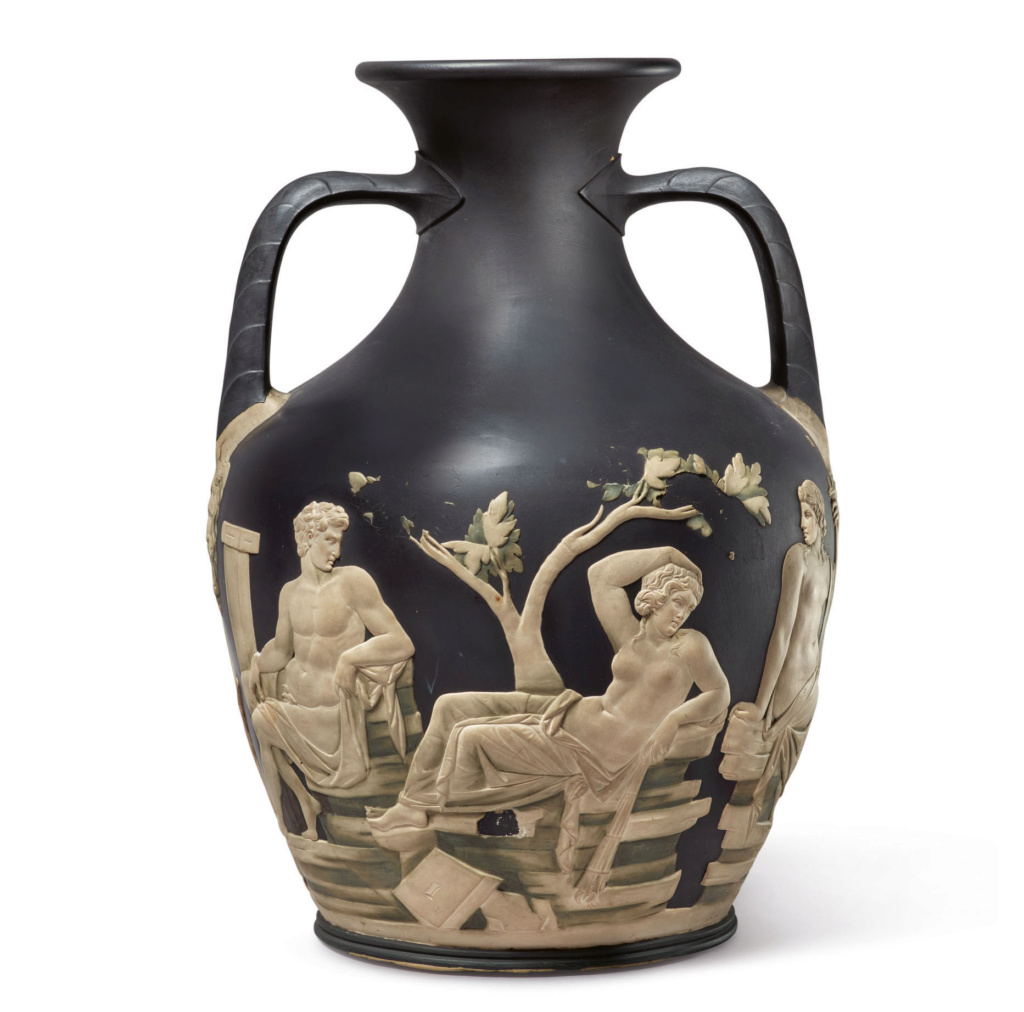
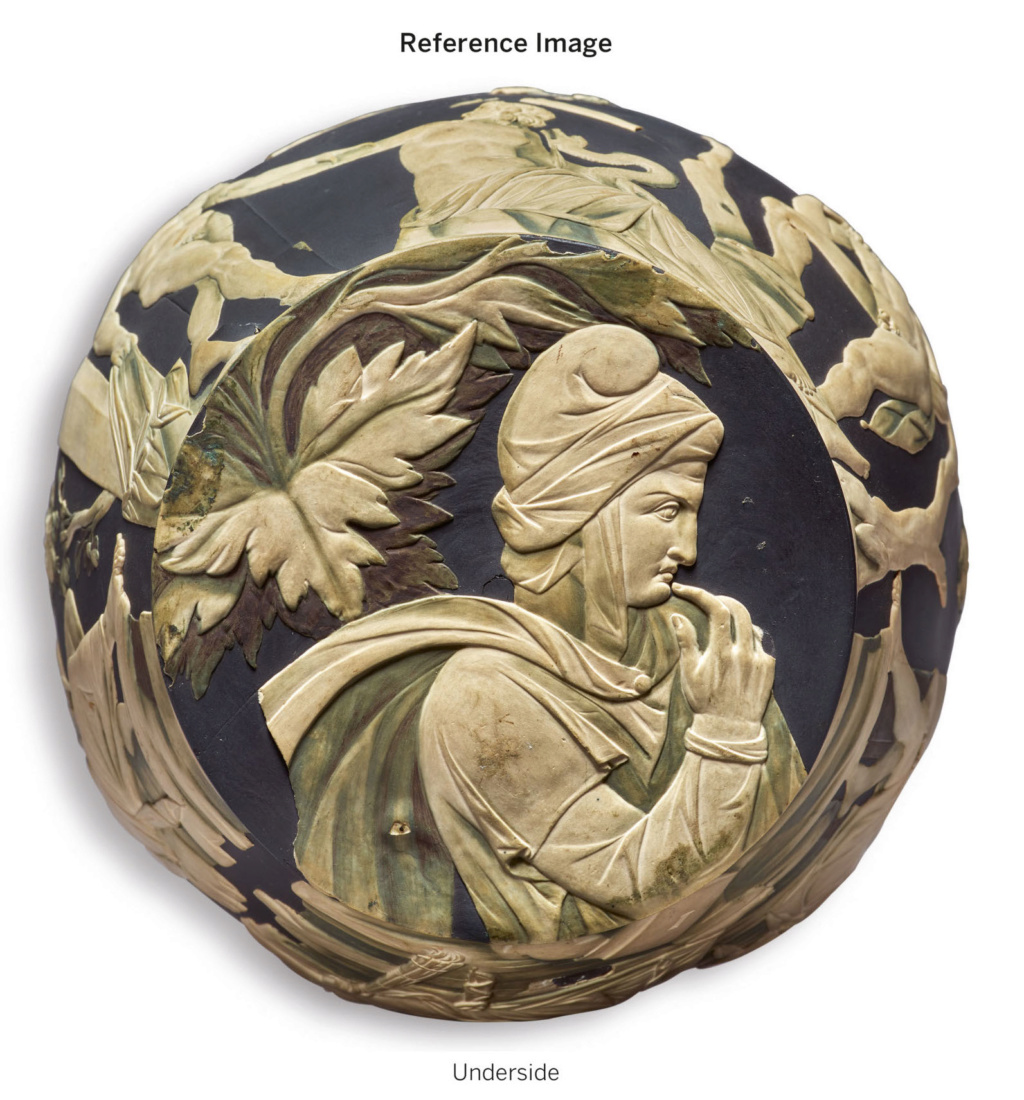
Images : Sotheby's
Note au catalogue (extraits) :
Exactly how many Portland vases were made in this first edition is unclear and has been much debated.
The Wedgwood 'oven books', or record of kiln firings which may be incomplete documents forty-five copies (Aileen Dawson, Masterpieces of Wedgwood in the Btritish Museum, London, 1984, op.cit., p. 124).
Some of the first editions are numbered and the highest number recorded so far is '30' on the example in the collection of the Art Institute in Chicago. 'Number 3' or 'The Barker Copy', was sold at Sotheby's London, October 22, 1974, lot 182, and 'Number 22' from the Oster Collection was sold in the same rooms, November 30, 1977, lot 112.
The most comprehensive listing of early numbered and unnumbered 'first edition' vases is compiled Ann Eatwell and Aileen Dawson and is published in Dawson, op. cit., pp. 149-150, where the present vase is included with nineteen other unnumbered examples.
 Le British Museum conserve également une version bleue, datée approximativement de la fin du XVIIIe siècle.
Le British Museum conserve également une version bleue, datée approximativement de la fin du XVIIIe siècle.
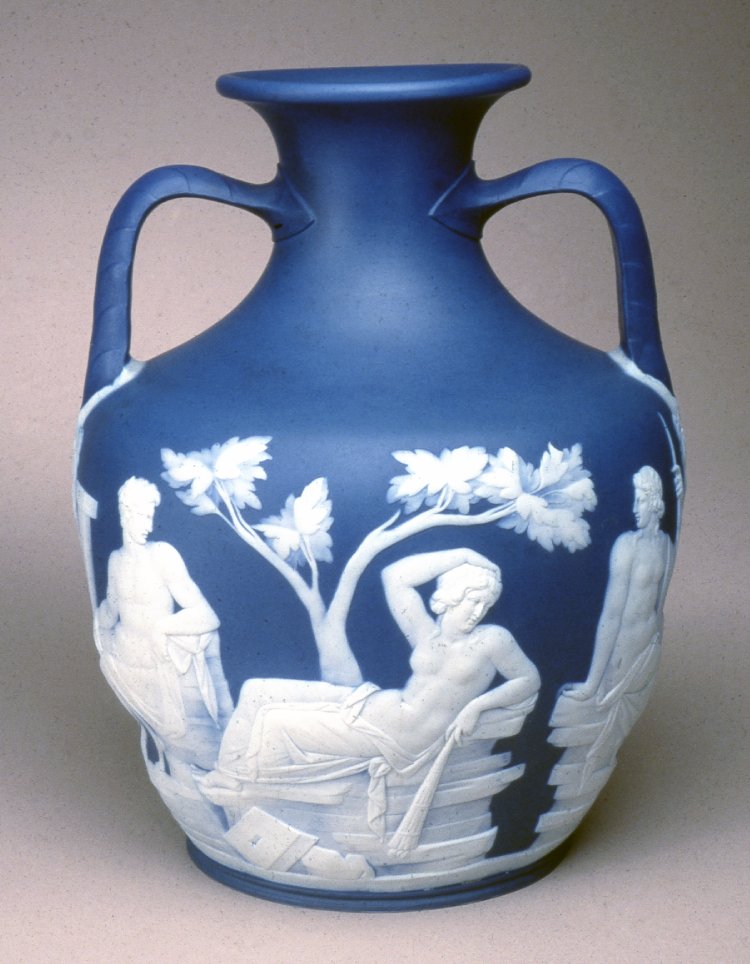
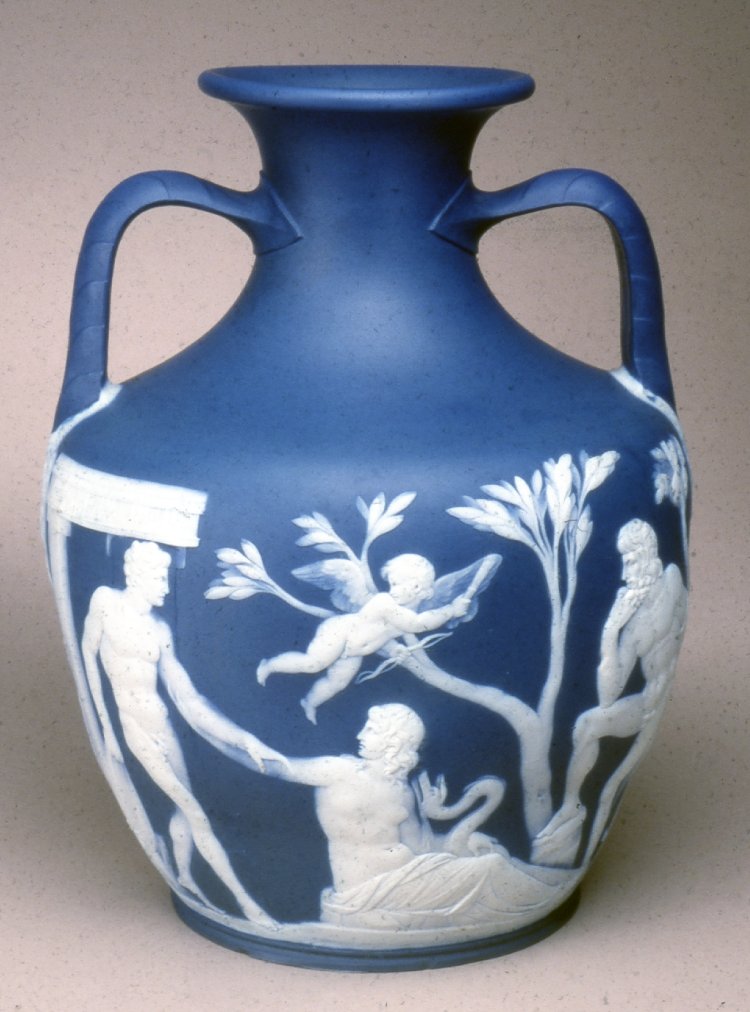

Copy of the Portland Vase
Jasper ware coloured blue and ornamented with applied white reliefs subjects the myth of Peleus and Thetis; disc on the base shows the upper part of the figure of Paris, son of King Priam of Troy.
Modelled by: William Hackwood (fl.1770)
Modelled by: Henry Webber (fl.1782)
Factory of: Wedgwood (under Wedgwood, Josiah I)
Modelled by: William Wood
Factory in Etruria, circa 1785-1795
Image : Trustees of the British Museum
 Il est dit que la manufacture ne reprendra la production des copies Portland qu'à partir de 1839, et une fois encore avec différentes séries que seuls les experts sont capables d'identifier.
Il est dit que la manufacture ne reprendra la production des copies Portland qu'à partir de 1839, et une fois encore avec différentes séries que seuls les experts sont capables d'identifier.
Je n'entrerai pas dans les détails (que j'ignore, d'ailleurs ! ).
).
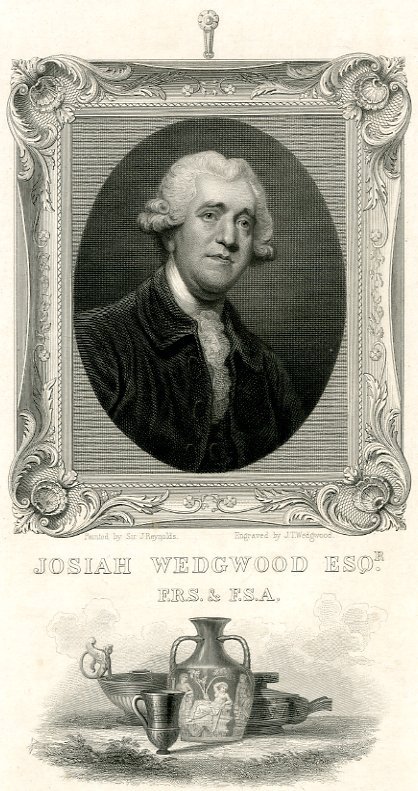
Portrait after Reynolds below, specimens of Wedgwood ware, including a copy of the Portland vase; sixth state, after publication line added. 1841
Etching and engraving, printed on chine collé
Painted by Sir J. Reynolds", "Engraved by J.T.Wedgwood", with publication line: "London. Published June 18th 1841 by Jno
 Retenons seulement que le succès est au rendez-vous depuis la première édition.
Retenons seulement que le succès est au rendez-vous depuis la première édition.
Et ce sont de multiples copies qui ont été produites depuis, et qui diffèrent par l'emploi de matériau, les couleurs, les dimensions, et jusqu'aux décors !
Avec notamment des exemplaires dont la nudité des hommes est cachée par un pudique drapé !

Par exemple :
L'exemplaire conservé au Metropolitan, dont l'intérieur du vase semble blanc...
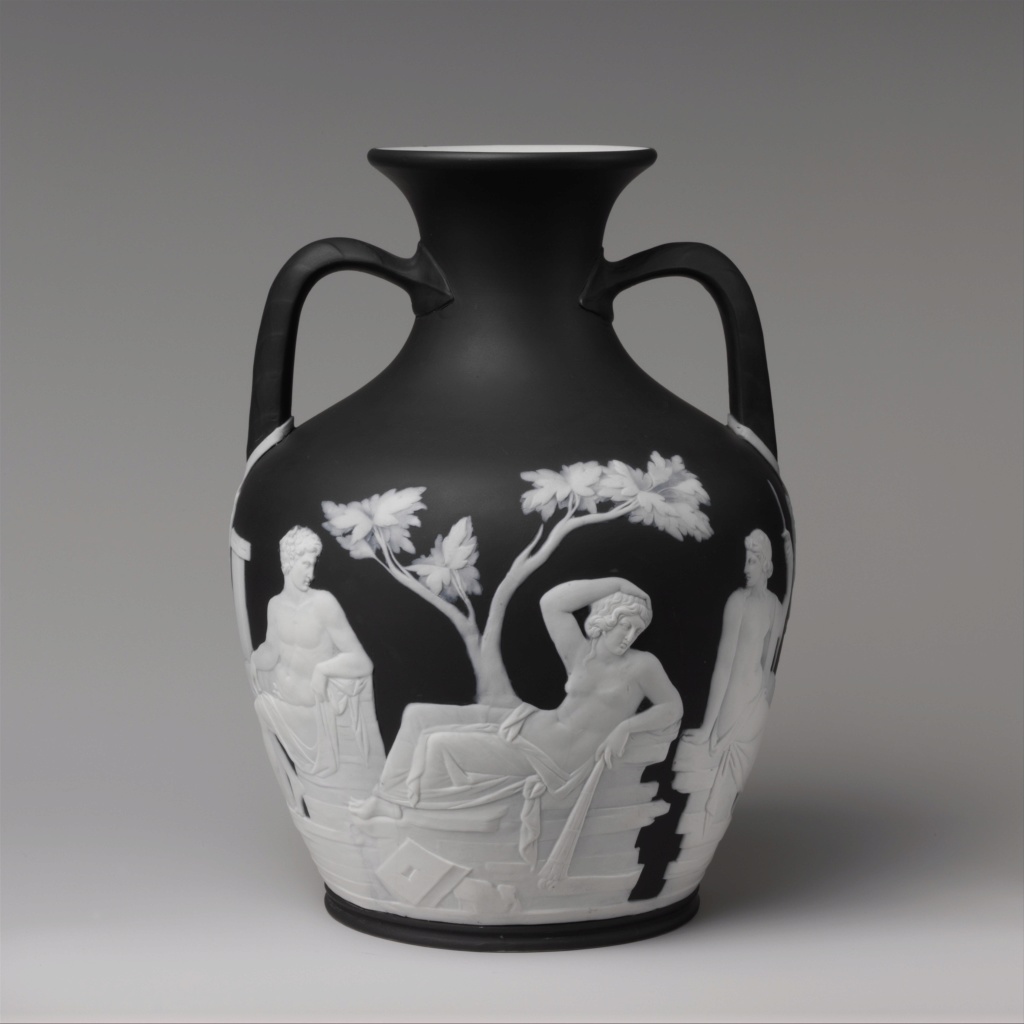
Portland Vase
Josiah Wedgwood and Sons
Ceramic, Pottery - Black basalt ware with white relief decoration, c. 1840-1860
Image : The Metropolitan Museum of Art.
Cette version miniature...



Portland Vase, miniature copy
Black and white jasper ware
Factory of: Wedgwood (under Wedgwood, Josiah I)
Circa 1820-1839 (?)
Dimension Height: 4.1 inches
Images : Trustees of the British Museum

Copy of the Portland Vase
Josiah Wedgwood and Sons Ltd, 1843
DimensionsOverall: 165mm (width), 233mm (height), 165mm (depth)
Image : Museum of New Zealand Te Papa Tongarewa
Le Museum of New Zealand conserve notamment deux versions : l'une pour collectionneurs pudibonds (avec sexe drapé des figures masculines), et l'autre destinée à ceux à qui il en fallait bien davantage pour être choqués...
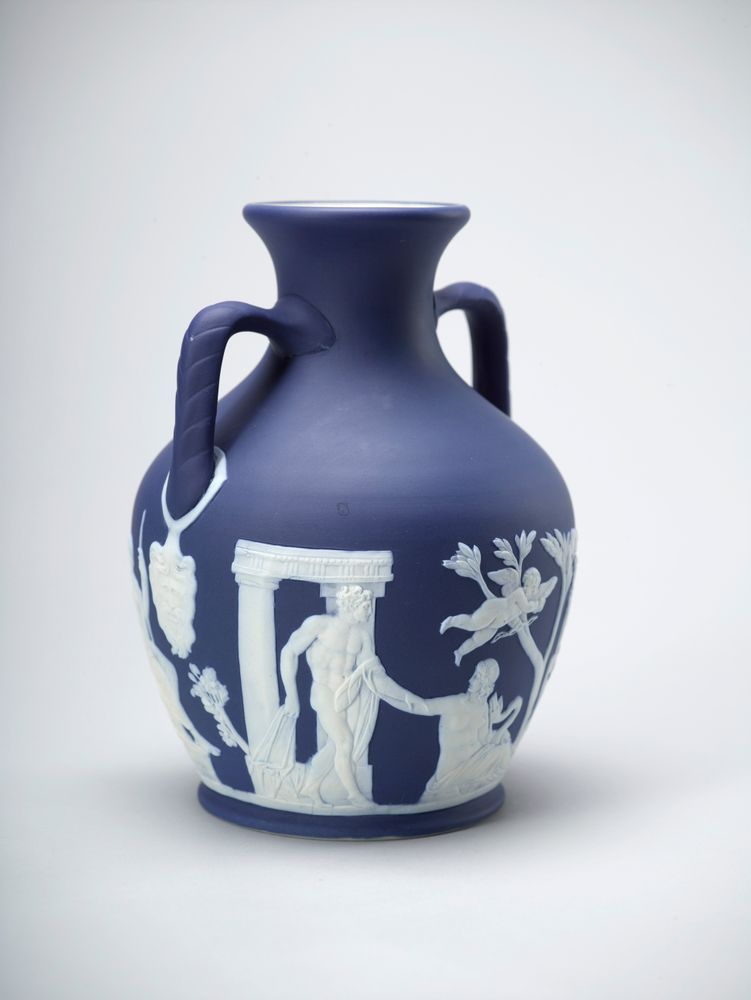
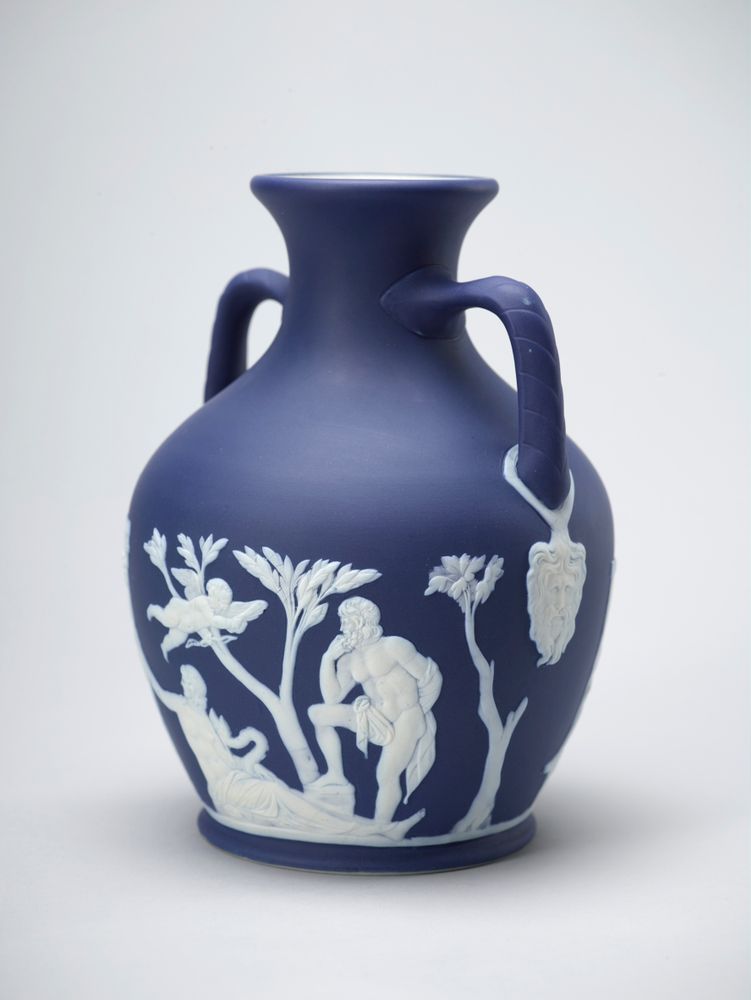
Copy of the Portland Vase
Josiah Wedgwood and Sons Ltd;
1800s
Dimensions Approximate: 163mm (width), 213mm (height), 160mm (depth)
Image : Museum of New Zealand Te Papa Tongarewa



Copy of the Portland Vase
Josiah Wedgwood and Sons Ltd
circa 1894
Dimensions Overall: 200mm (width), 255mm (height), 200mm (depth), 243mm
Image : Museum of New Zealand Te Papa Tongarewa
En 1786, l'annonce de la vente aux enchères du "museum" de la duchesse de Portland était un évènement. Le fameux vase antique faisait partie des lots parmi ceux les plus convoités.

Title plate to the set of prints of the Portland Vase
A seated figure pointing towards an inscription along a wall, above which is the Portland vase on a socle below a Roman sarcophagus; to the left a bucranium and a Corinthian capital, and an unfurled scroll showing the interior of the tomb in which the vase was discovered.
Print made by : Charles Francis Greville
London, Etching and aquatint, c. 1786
Image : Trustees of the British Museum


Details of the Portland Vase
Etching on paper, 1786
Print made by Francesco Bartolozzi after Giovanni Battista Cipriani
Image : Trustees of the British Museum
Josiah Wedgwood aurait souhaité se porter acquéreur du vase, mais il resta finalement entre les mains du duc de Portland qui accepta de prêter le vase à Wedgwood afin qu'il en fasse des copies en céramique.
Josiah Wedgwood, aidé de son fils, d'Henry Webber et de William Hackwood travaillèrent durant plus de trois ans afin de parfaire cette reproduction.
Après de nombreux échecs, la première copie jugée satisfaisante fut produite en octobre 1789.
Dès 1790, Josiah Wedgwood organisa la promotion et la vente de la très recherchée aujourd'hui "première édition du vase Portland".
La campagne de marketing de Wedgwood comprenait une exposition publique à Londres, une exposition privée animée par Sir Joseph Banks et une tournée promotionnelle dans les principales capitales d'Europe.

Admission ticket
Ticket inscribed Admission to see Mr. Wedgwood's Copy of THE PORTLAND VASE, Greek Street, Soho / between 12 o' Clock and 5. 2 pieces.
Image : Sotheby's

Portland Vase Black Jasper with White Reliefs
1790
Image : World of Wedgwood, museum highlights
Il est dit que le projet initial était de commercialiser une quarantaine d'exemplaires de cette première édition (les chiffres varient selon les sources).

Les copies du vase, dites de la première édition, furent produites jusqu'en 1796, mais leur nombre exact n'est pas certain, même si quelqu'uns d'entre-eux sont numérotés à l'intérieur du vase (tous ne le seraient pas, cependant

Image : MS Rau Antiques

Portland vase copy
Wedgwood, England, est. 1759
Stoneware, about 1790
Handwritten on interior rim in graphite: 12
Provenance : Josiah Wedgwood; Josiah Wedgwood II; by descent to Emma Darwin (nee Wedgwood); by descent to Sir Robin Darwin (then on loan to the Victoria & Albert Museum, London); purchased 1965 by Dwight and Lucille Beeson; Birmingham Museum of Art
Image : ArtsBMA

'First Edition' copy of the Portland Vase
Jasper with black 'dip' and white reliefs
Staffordshire (made), Wedgwood, ca 1790
Hackwood, William (modeller)
Webber, Henry (modeller)
Staffordshire, Josiah Wedgwood's factory, c. 1790
Image : Victoria and Albert Museum
He first attempted to reproduce it in 1786, and he spent over three years matching the subtlety of the lapidary-worked reliefs of the original.
His copies were made in Jasper, the stoneware body he developed following thousands of experiments in the 1770s and which is still in production today. This can be stained a range of colours to provide a background for applied moulded reliefs.
Having obtained the approval of leading connoisseurs and taste-makers, such as the artist Sir Joshua Reynolds, Wedgwood exhibited his perfected ‘First Edition’ copy in London in 1790, showing it to a select audience who had applied for admission tickets in advance.




Images : Victoria and Albert Museum

Copy of the Portland Vase, first edition
Inscription: inner lip, manganese pencil, handwritten: 9
Josiah Wedgwood & Sons
Jasperware, c. 1795
Dimensions : 25.8 x 18.5 cm diam
Gallery text :
In 1786, the Duke of Portland lent the original Greco-Roman Portland Vase to Josiah Wedgwood, who promptly set his artists to copying it and manufacturing meticulous replicas.
Early versions of the vase cracked in the firing process or failed to achieve the desired appearance. Wedgwood’s artisans struggled for four years to perfect their material and techniques, developing a blue-black clay to evoke the dark opaque glass of the original.
Ultimately a limited edition — of which this is number nine — was sold, mostly through special viewings at the Wedgwood showroom.
The name of John Trevor, who acquired this example from the manufacturer in 1797, is written inside the lip of the vase. One of Wedgwood’s most celebrated works, this was the first example from the subscription edition to enter an American collection.
Daté fin XVIIIe siècle, les experts de la vente reviennent sur les incertitudes quant au nombre de pièces produites pour la "première édition" :

A WEDGWOOD BLACK AND WHITE JASPERWARE 'PORTLAND VASE'
LATE 18TH CENTURY
after the antique, of amphora form, with two molded scaled handles affixed at the shoulder with a flaring trumpet neck, applied in white relief with a continuous scene around the body with six classical figures and a cupid and on the underside with a roundel of Pan, embellished in tones of green-blue and brown.
Height 10¼ in. - 26 cm


Images : Sotheby's
Note au catalogue (extraits) :
Exactly how many Portland vases were made in this first edition is unclear and has been much debated.
The Wedgwood 'oven books', or record of kiln firings which may be incomplete documents forty-five copies (Aileen Dawson, Masterpieces of Wedgwood in the Btritish Museum, London, 1984, op.cit., p. 124).
Some of the first editions are numbered and the highest number recorded so far is '30' on the example in the collection of the Art Institute in Chicago. 'Number 3' or 'The Barker Copy', was sold at Sotheby's London, October 22, 1974, lot 182, and 'Number 22' from the Oster Collection was sold in the same rooms, November 30, 1977, lot 112.
The most comprehensive listing of early numbered and unnumbered 'first edition' vases is compiled Ann Eatwell and Aileen Dawson and is published in Dawson, op. cit., pp. 149-150, where the present vase is included with nineteen other unnumbered examples.



Copy of the Portland Vase
Jasper ware coloured blue and ornamented with applied white reliefs subjects the myth of Peleus and Thetis; disc on the base shows the upper part of the figure of Paris, son of King Priam of Troy.
Modelled by: William Hackwood (fl.1770)
Modelled by: Henry Webber (fl.1782)
Factory of: Wedgwood (under Wedgwood, Josiah I)
Modelled by: William Wood
Factory in Etruria, circa 1785-1795
Image : Trustees of the British Museum
Je n'entrerai pas dans les détails (que j'ignore, d'ailleurs !
 ).
). 
Portrait after Reynolds below, specimens of Wedgwood ware, including a copy of the Portland vase; sixth state, after publication line added. 1841
Etching and engraving, printed on chine collé
Painted by Sir J. Reynolds", "Engraved by J.T.Wedgwood", with publication line: "London. Published June 18th 1841 by Jno
Et ce sont de multiples copies qui ont été produites depuis, et qui diffèrent par l'emploi de matériau, les couleurs, les dimensions, et jusqu'aux décors !
Avec notamment des exemplaires dont la nudité des hommes est cachée par un pudique drapé !

Par exemple :
L'exemplaire conservé au Metropolitan, dont l'intérieur du vase semble blanc...

Portland Vase
Josiah Wedgwood and Sons
Ceramic, Pottery - Black basalt ware with white relief decoration, c. 1840-1860
Image : The Metropolitan Museum of Art.
Cette version miniature...



Portland Vase, miniature copy
Black and white jasper ware
Factory of: Wedgwood (under Wedgwood, Josiah I)
Circa 1820-1839 (?)
Dimension Height: 4.1 inches
Images : Trustees of the British Museum

Copy of the Portland Vase
Josiah Wedgwood and Sons Ltd, 1843
DimensionsOverall: 165mm (width), 233mm (height), 165mm (depth)
Image : Museum of New Zealand Te Papa Tongarewa
Le Museum of New Zealand conserve notamment deux versions : l'une pour collectionneurs pudibonds (avec sexe drapé des figures masculines), et l'autre destinée à ceux à qui il en fallait bien davantage pour être choqués...



Copy of the Portland Vase
Josiah Wedgwood and Sons Ltd;
1800s
Dimensions Approximate: 163mm (width), 213mm (height), 160mm (depth)
Image : Museum of New Zealand Te Papa Tongarewa



Copy of the Portland Vase
Josiah Wedgwood and Sons Ltd
circa 1894
Dimensions Overall: 200mm (width), 255mm (height), 200mm (depth), 243mm
Image : Museum of New Zealand Te Papa Tongarewa

La nuit, la neige- Messages : 17807
Date d'inscription : 21/12/2013
 Re: La manufacture Wedgwood et sa production du XVIIIe siècle
Re: La manufacture Wedgwood et sa production du XVIIIe siècle
Si je puis me permettre, le drapé est cependant moins ridicule que la feuille de vigne ...

_________________
... demain est un autre jour .

Mme de Sabran- Messages : 54725
Date d'inscription : 21/12/2013
Localisation : l'Ouest sauvage
 Sujets similaires
Sujets similaires» Meubles du XVIIIe siècle en acier et la manufacture de Tula (Russie)
» À Versailles, désormais, on supprime du XVIIIe siècle pour retrouver du XVIIIe
» Le modèle " Vase du roi " ou " Vase du Roi guirlande ", Manufacture de Sèvres (18e siècle)
» Traîneaux et troïkas du XVIIIe siècle
» Bordeaux au XVIIIe siècle
» À Versailles, désormais, on supprime du XVIIIe siècle pour retrouver du XVIIIe
» Le modèle " Vase du roi " ou " Vase du Roi guirlande ", Manufacture de Sèvres (18e siècle)
» Traîneaux et troïkas du XVIIIe siècle
» Bordeaux au XVIIIe siècle
LE FORUM DE MARIE-ANTOINETTE :: La France et le Monde au XVIIIe siècle :: Les Arts et l'artisanat au XVIIIe siècle :: Les arts décoratifs
Page 1 sur 1
Permission de ce forum:
Vous ne pouvez pas répondre aux sujets dans ce forum|
|
|
